Growing Wildlife-Based Tourism Sustainably: A New Report and Q&A
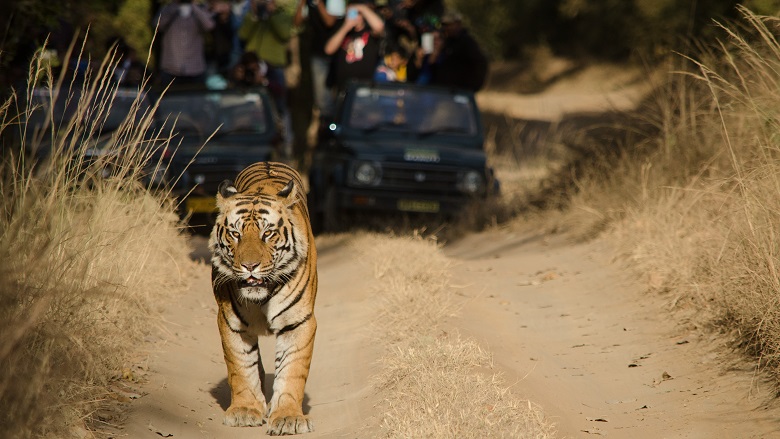
Copyright: Sanjayda, Shutterstock.com

STORY HIGHLIGHTS
- While wildlife and biodiversity are increasingly threatened by habitat loss, poaching, and a lack of funding for protection, nature-based tourism is on the rise and could help provide solutions for these issues.
- The publication Supporting Sustainable Livelihoods through Wildlife Tourism highlights successful wildlife tourism programs in seven countries in Africa and Asia that can be used as models to promote conservation and boost economies.
- World Bank lead economist Richard Damania answers questions on the drivers, innovations and challenges for wildlife tourism, and why the World Bank Group and governments should support sustainable tourism strategies.
Wildlife tourism is a powerful tool countries can leverage to grow and diversify their economies while protecting their biodiversity and meeting several Sustainable Development Goals. It is also a way to engage tourists in wildlife conservation and inject money into local communities living closest to wildlife. Success stories and lessons learned from nature-based tourism are emerging from across the globe.
“Here is a way of squaring the circle: provide jobs and save the environment,” said World Bank lead economist Richard Damania, who has extensive experience in understanding the link between tourism and the economy . In 2016, travel and tourism contributed $7.6 trillion, or 10.2%, to total GDP, and the industry provided jobs to one in 10 people, according to the World Travel & Tourism Council .
While nature-based tourism, which includes wildlife tourism, has been expanding rapidly in the last decade or so due to increased demand and opportunities, wildlife and biodiversity are increasingly threatened by habitat loss, poaching, and a lack of funding for protection.
Which is why more than ever countries need to look to concrete examples of well-planned, sustainably-run tourism operations that have led to increased investments in protected areas and reserves, a reduction in poaching, an increase in the non-consumptive value of wildlife through viewing , and opportunities for rural communities to improve their livelihoods through tourism-related jobs, revenue-sharing arrangements, and co-management of natural resources.
A recently-released publication— Supporting Sustainable Livelihoods through Wildlife Tourism —developed by the World Bank Group and the Global Wildlife Program , funded by the Global Environment Facility , showcases sustainable wildlife tourism models that can be applied to developing countries, and offers solutions and case studies to bring insight into this sector as a mechanism for inclusive poverty reduction and global conservation.
The Global Wildlife Program spoke with Damania to learn more about the growth, challenges, and innovations in wildlife-based tourism.
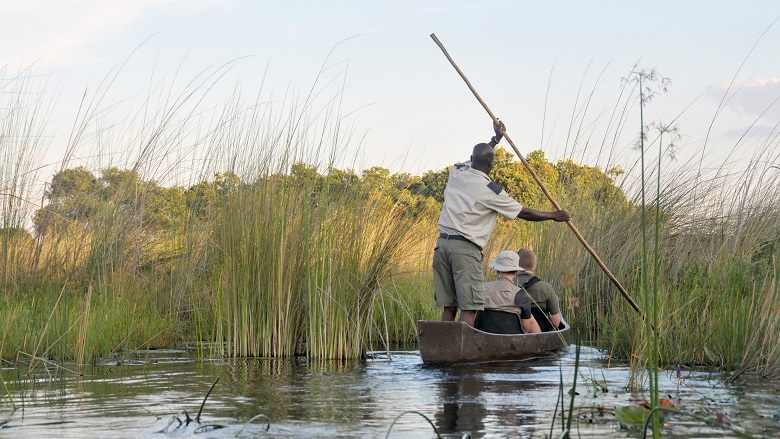
Copyright: Wandel Guides, Shutterstock.com
Why should the World Bank support conservation endeavors, and how does wildlife tourism help support our mission?
Enlightened self-interest is one obvious reason why we need to promote wildlife tourism. It provides the most obvious way to reconcile the interests of nature with the imperative for development and growth. Tourism simultaneously creates jobs while, when done well, protects natural habitats.
Prudence and precaution are another reason why investments in nature-based tourism ought to be promoted. The science of “ planetary boundaries ” warns us that many fragile natural environments and ecosystems are reaching their limits and in some cases, the hypothesized safe boundaries have been crossed. Further damage will imply that we lose important ecosystem services such as watershed and soil protection with damaging consequences for development.
But, in my mind, perhaps the most important reason is humanity’s moral and ethical imperative as stewards of global ecosystems. Simply because humanity has the ability to destroy or convert ecosystems and drive species to extinction does not make it ethically justifiable. There needs to be an ethical balance and that is where ecotourism comes in. We need jobs and economic growth, but here is a way to get jobs and growth in ways that meet our moral and ethical obligation.
What have been the drivers behind a burgeoning nature-based/wildlife-based tourism sector?
I think there are two things that drive it: as habitats diminish there is more scarcity and their value goes up. Everyone wants to see the last remaining habitats of wild gorillas for instance, or the few remaining wild tigers in India. In sum scarcity confers economic value.
Another force driving demand is the internet and rising lifestyles—you can learn about animals and habitats you might not have known existed, and more people have the ability to visit them. So, you have supply diminishing on one hand, and demand rising on the other hand which creates an opportunity for economic progress together with conservation.
What is your advice to governments and others who are developing or expanding on a nature or wildlife-based tourism strategy?
Tourism benefits need to be shared better . There is a lack of balance with too many tourists in some places, and none elsewhere. Some destinations face gross overcrowding, such as South Africa’s Krueger National Park or the Masai Mara in Kenya where you have tourists looking at other tourists, instead of at lions. We need to be able to distribute the demand for tourists more equally. The Bank has a role to play in developing the right kind of tourism infrastructure.
Those living closest to nature and wildlife must also benefit . The local inhabitants that live in the national parks or at their periphery are usually extremely poor. Having tourism operations that can benefit them is extremely important for social corporate reasons, but also for sustainability reasons. If the benefits of tourism flow to the local communities, they will value the parks much more.
We also need to be mindful of wildlife corridors . We know that dispersion and migration are fundamental biological determinants of species survival. Closed systems where animals cannot move to breed are not sustainable in the long run. As we break off the corridors because of infrastructure and increasing human populations we are putting the ecosystems on life support.
There are some who believe we can manage these closed ecosystems, but it takes an immense amount of self assurance in science to suggest this with confidence, and it is unclear that one can manage ecosystems that we do not adequately understand. A measure of caution and humility is needed when we are stretching the bounds of what is known to science.
What are some of the innovative partnerships that are helping the wildlife-based tourism businesses in developing countries?
One very successful model that has combined wildlife conservation and management and community benefits and welfare is the Ruaha Carnivore Project in Tanzania, part of Oxford University’s Wildlife Conservation Research Unite ( WildCRU ). They use a payment for ecosystem services (PES) scheme and do all the right things.
Another example are the community conservancies in Namibia. The community manages the land for wildlife and there are a variety of profit sharing commercial tourism arrangements—although not everything always works fairly or perfectly. Incentives matter deeply and communities need to be guided and need technical assistance in setting up commercial arrangements.
The Bank needs to understand these better and find ways of scaling those up. The IFC has a very good role to play here as well.
To learn more and to explore numerous examples of community involvement in wildlife tourism from Botswana, India, Kenya, Malawi, Namibia, South Africa and Uganda, read the report Supporting Sustainable Livelihoods through Wildlife Tourism or find a one-page fact sheet here .
The Global Wildlife Program (GWP) is led by the World Bank and funded by a $131 million grant from the Global Environment Facility (GEF). The program is working with 19 countries across Africa and Asia to promote wildlife conservation and sustainable development by combatting illicit trafficking in wildlife, and investing in wildlife-based tourism.
- Full Report: Supporting Sustainable Livelihoods through Wildlife Tourism
- Fact Sheet on Key Messages
- Report: Twenty Reasons Sustainable Tourism Counts for Development
- Report: Women and Tourism: Designing for Inclusion
- Blog: Africa can Benefit from Nature-based Tourism in a Sustainable Manner
- Feature: Ramping up Nature-Based Tourism to Protect Biodiversity and Boost Livelihoods
- Website: Global Wildlife Program
- Website: Environment
- Website: Competitiveness
- Global Environment Facility
An official website of the United States government
The .gov means it’s official. Federal government websites often end in .gov or .mil. Before sharing sensitive information, make sure you’re on a federal government site.
The site is secure. The https:// ensures that you are connecting to the official website and that any information you provide is encrypted and transmitted securely.
- Publications
- Account settings
Preview improvements coming to the PMC website in October 2024. Learn More or Try it out now .
- Advanced Search
- Journal List
- Animals (Basel)

The Escalating Effects of Wildlife Tourism on Human–Wildlife Conflict
Qingming cui.
1 School of Tourism Management, South China Normal University, Guangzhou 510006, China; moc.621@gnimgniqiuc
2 South China Ecological Civilization Research Center, South China Normal University, Guangzhou 510006, China
3 School of Hotel Administration, Cornell University, Ithaca, NY 14850, USA; ude.llenroc@242ry
Honggang Xu
4 School of Tourism Management, Sun Yat-sen University, Zhuhai 519082, China
Associated Data
Simple summary.
Communities adjacent to protected areas usually face conflict with protected wildlife. Wildlife tourism is regarded as a tool to mitigate such conflict through bringing economic benefits to villagers and then increasing villagers’ tolerance of wildlife. We used qualitative methods to conduct a case study on a macaque tourism attraction in China and find that tourism may escalate rather than mitigate community–wildlife conflict. Provisioning food is a common way to attract wild animals to visit and stay in human activity areas. In the case of macaque tourism, anthropogenic food provision caused rapid population increase and more intra-group aggressive behaviors. More tourist–macaque interactions resulted in macaques becoming habituated to human’s presence. These ecological impacts on macaques led more invasion to the surrounding community and intensified resident–macaque conflict. Meanwhile, low community participation in tourism generated few benefits for residents and did not help alter residents’ hostile attitudes towards the macaques. Local residents gradually retreated from agriculture as the macaques became more intrusive. We propose a holistic model combining social and ecological perspectives to evaluate the role of wildlife tourism in resolving community–wildlife conflict. We suggest that wildlife tourism should minimize human–wildlife intimate interactions and food provision.
Human–wildlife conflict is a barrier to achieving sustainable biodiversity conservation and community development in protected areas. Tourism is often regarded as a tool to mitigate such conflict. However, existing studies have mainly adopted a socio-economic perspective to examine the benefits of tourism for communities, neglecting the ecological effects of tourism. This case study of macaque tourism on a peninsula in China illustrates that tourism can escalate rather than mitigate human–wildlife conflict. Fifty-three stakeholders were interviewed and secondary data were collected to understand the development of rhesus macaque ( Macaca mulatta ) tourism and community–macaque conflict. The results show that food provision and tourist–macaque interactions rapidly increased the macaques’ population, habituation, and aggressive behaviors, which led them to invade the surrounding community more often and exacerbated human–macaque conflict. Meanwhile, low community participation in tourism generated few benefits for residents and did not help alter residents’ hostile attitudes towards the macaques. Local residents gradually retreated from agriculture as the macaques became more intrusive. A holistic approach to evaluating the role of wildlife tourism in resolving community–wildlife conflict is proposed and practical suggestions for alleviating such conflict are given.
1. Introduction
In the past few decades, protected areas have been one of the main tools for maintaining and improving biodiversity conservation [ 1 , 2 , 3 , 4 ]. However, there are tensions between wildlife conservation and the development of communities adjacent to protected areas [ 5 , 6 ]. The establishment of protected areas deprives communities of natural resources and restricts industrial and agricultural development, suggesting that to conserve ecology and wildlife, those communities sacrifice economic opportunities [ 7 , 8 , 9 ]. Moreover, wild animals often cross the borders of protected areas and enter neighboring communities, causing human–wildlife conflict [ 10 , 11 ]. The costs that wildlife impose upon local people include crop-raiding, livestock loss, human attacks, and opportunity and transaction costs [ 8 , 12 ]. Local residents who suffer economic, social, and health losses may then become hostile to wildlife and conservation, and even harm or kill wild animals for revenge [ 12 , 13 ]. Human–wildlife conflict is therefore one of the main problems besetting sustainable wildlife conservation and the sustainable livelihoods of local communities. “Human–wildlife conflict” in this study mainly refers to the community–wildlife conflict, following most other conservation studies, e.g., [ 12 , 14 , 15 ].
Wildlife tourism development has been proposed as a solution to human–wildlife conflict [ 3 , 14 , 15 ]. Recent studies have focused on examining whether and how tourism benefits can alter communities’ hostile attitudes and livelihoods from the economic and social perspectives [ 16 ]. In this article, we argue that those studies neglect the ecological costs of wildlife tourism. Human–wildlife interactions in tourism can bring about various adaptive ecological and behavioral changes that cause wildlife to become a nuisance and make human–wildlife conflict difficult to manage [ 17 , 18 ]. The introduction of profit-driven wildlife tourism in protected areas can trigger complicity in relation to human–wildlife conflict and result in a divergence from original conservation principles. In order to bridge the above research gap, we propose a holistic approach that synthesizes social and ecological perspectives to examine the interactions among tourism businesses, local community, and wildlife.
We use macaque tourism in Hainan Province, China, as a case study to show how wildlife tourism can intensify, rather than mitigate, human–wildlife conflict. The specific research questions include: (1) How do the community residents cope with the community–wildlife conflict? (2) How does the community participate in tourism, and can tourism benefits change the community’s attitude towards wildlife? (3) How does tourism activities affect wildlife? (4) Does wildlife tourism exacerbate or mitigate human–wildlife conflict if assessing the socio-economic benefits and ecological costs combined?
2. Literature Review
2.1. tourism as a way to mitigate human–wildlife conflict.
There are controversial arguments about whether and how tourism development mitigates human–wildlife conflict in protected areas. Many studies endorse the premise that tourism benefits that accrue to local residents can raise villagers’ environmental awareness, increase residents’ tolerance of wildlife [ 15 ], and transform traditional livelihoods [ 19 ]. For instance, Mbaiwa and Stronza found that in Okavango Delta, three communities participating in tourism had stopped traditional activities, such as hunting, gathering, livestock raising, and crop farming [ 20 ]. Tourism revenue-sharing projects in gorilla tourism in Rwanda and Uganda have received the most research attention, with studies finding that national park officials and local representatives believe that revenue-sharing is the most significant advantage of living adjacent to gorilla national parks [ 21 ] and that residents benefit from tourism revenue-sharing through infrastructure projects [ 22 , 23 ]. Cases from Brazil and Peru also support the argument that tourism benefits local residents, and that local participation in management can generate conservation attitudes and actions [ 24 ].
However, other scholars have questioned the effectiveness of tourism in improving community development and biodiversity conservation [ 9 , 16 , 25 ]. Swemmer et al. pointed out that “benefit sharing is messy, is complex, and occurs at various scales with multiple trade-offs” [ 26 ] (p. 17). Stakeholders at different scales have heterogeneous demands for revenue, for various reasons. For instance, communities in Uganda’s Mgahinga Gorilla National Park were found to want benefits to compensate for crop and livestock losses caused by wildlife, park officials hoped to use tourism revenues to offset the costs of management, and the national government tended to allocate tourism revenues according to the conservation needs of the whole state [ 27 ]. In many developing countries, the government and park authorities have the power to determine the allocation of tourism revenues, and communities lack access to participation in the decision-making process [ 25 , 28 , 29 ].
In addition to unequal power relations and a lack of local participation, the uneven distribution of tourism benefits is another problem [ 16 ]. Within communities, poor residents often perceive that the elite obtain the majority of tourism benefits [ 22 , 28 ]. Hemson et al. noted that only residents in tourism industry gain benefits; most local residents are not beneficiaries of tourism [ 30 ]. Tourism revenues may not be distributed evenly among different communities. For example, residents in the buffer zone of Nepal’s Chitwan National Park are constrained in their use of natural resources, but only those villages close to the park’s entry points benefit from tourism incentives [ 31 ]. In China’s Wolong Giant Panda Nature Reserve, the communities close to main roads gain more income from tourism than the remote communities that bear greater costs of conservation [ 32 ]. The spatial unevenness of revenue distribution has also been found in gorilla national parks in central Africa [ 25 , 33 , 34 ].
Moreover, the distribution of tourism economic incentives is often mismatched. Crop-raiding and livestock loss caused by wildlife are the problems of most concern to local residents [ 25 , 34 ]. However, tourism benefits are often allocated to improving social infrastructures, such as clinics, schools, roads, bridges, wells, and water tanks, rather than direct compensation or the prevention of human–wildlife conflict [ 21 , 22 ]. Because of this mismatch, local people remain hostile towards wildlife [ 30 ]. The locals in Kibale National Park in Uganda regard building elephant trenches as being better than building schools and roads [ 35 ]. Many scholars have therefore suggested that tourism revenues should be used to directly offset losses caused by human–wildlife conflict to more effectively improve local attitudes to conservation [ 22 , 25 , 28 , 34 ].
Generally, existing studies mainly evaluate the role of tourism in conservation from the socio-economic dimension, and conclude that although tourism benefits contribute to changing local people’s attitudes towards wildlife and conservation, the effectiveness of tourism is limited due to the unequal, uneven, and mismatched distribution of benefits [ 16 , 36 ]. By contrast, few studies consider the ecological impacts when assessing the impact of tourism on mitigating human–wildlife conflict. Many protected areas use their unique species as tourist attractions to generate economic revenues. However, wildlife-based tourism development is not without cost. Tourism activities can generate negative effects on wild animals [ 37 , 38 ], which should also be considered when evaluating social and economic benefits [ 39 ]. In the next section, we review the effects of wildlife tourism on macaques as an exemplar species.
2.2. The Effects of Wildlife Tourism on Macaques
Humanity has a long history of interacting with macaques ( genus Macaca ). In contemporary society, free-ranging macaques have become popular tourist attractions. There are 23 species of macaque distributed in Asia, North Africa, and Gibraltar, many of which are strongly involved in the tourism industry [ 40 ].
Wild animals usually avoid encountering humans, which makes wildlife-based tourism unpredictable and uncontrollable [ 41 ]. In non-captive macaque tourism, food provisioning is a common way to tempt macaques to stay in a certain area and become habituated to the presence of people [ 42 , 43 , 44 ]. In some wildlife tourism sites, feeding animals is itself an important tourist experience [ 44 ]. Provision of food is an effective strategy to increase the likelihood of tourists interacting with free-ranging macaques [ 44 ].
However, food provisioning and tourist activities have various negative effects on macaques [ 44 , 45 ]. Anthropogenic foods are highly caloric and are more palatable and more accessible than macaques’ natural foods. Wild macaques therefore spend more time at tourist sites and come to rely on the provided food supply, resulting in changes in their activity budgets and dietary diversity [ 43 , 46 ]. Provisioning also affects the population in diverse ways. A stable, intensive, and abundant food supply can dramatically increase the population of macaques [ 39 , 44 , 47 ]; however, close contact raises the possibility of mutual pathogen transmission between humans and macaques, which can further affect the health and population of the animals [ 48 ].
Macaques in tourism areas gradually develop interspecific aggressive behaviors. The presence and proximity of tourists can elevate Barbary macaques’ anxiety levels [ 49 , 50 ]. Many tourists are not satisfied with inactive wildlife. They often tease monkeys to behave more actively by pointing, waving, slapping, mimicking, yelling, throwing food, and even threatening [ 50 , 51 , 52 , 53 ]. Many studies show that tourists initiate the majority of interactions with macaques [ 54 , 55 ]. Tourists’ provocative behaviors induce monkeys’ agonistic responses such as biting, scratching, hitting, and threatening [ 52 , 56 ]. Because of interspecific differences, tourists generally misinterpret the meaning of monkeys’ behaviors, which may enhance the agonism. For example, Maréchal et al. found that in interactions, most tourists cannot identify the exact meanings of macaques’ facial expressions [ 57 ]. The longer the history of visitors’ interactions with macaques, the more aggressive the macaques may become [ 58 ].
Food provision also intensifies intraspecific agonism. Monkeys fight with each other during the feeding time [ 59 ]. There is a positive correlation between food provision and the frequency of in-group aggression [ 54 ]. Furthermore, tourists like to feed baby monkeys, which they perceive as cuter than adults [ 51 ]. This preference violates the strict hierarchy among macaque groups and increases the rate of attacks on baby and juvenile macaques by male adult macaques [ 51 , 59 ].
Despite these negative impacts, some scholars regard human–macaque interactions in tourism as opportunities that have stimulated the evolution of macaques [ 18 ]. Evidence for this point of view is the robbing and bartering behavior developed by long-tailed macaques at Uluwatu Temple, Indonesia [ 60 ]. The macaques have learned to steal inedible objects such as glasses and hats from tourists and barter the objects for food with the staff. This innovation has been socially learned and has spread in the group, suggesting that human–macaque interactions in tourism can cause significant cultural change in a macaque group [ 61 ].
Existing research shows that tourism affects macaques at the population, behavioral, and cultural levels. Macaques can develop adaptive behaviors in anthropogenic tourism environments. Barrett, Stanton and Benson-Amram called for more studies to explore the roles of animals’ adaptive behaviors in worsening or mitigating human–wildlife conflict in protected areas [ 17 ]. This study uses macaque tourism in China to show that the effects of tourism on macaques can exacerbate rather than mitigate human–wildlife conflict.
3. Materials and Methods
3.1. study site.
The study site is Nanwan peninsula in Lingshui county, Hainan, China ( Figure 1 ). This peninsula consists of three main areas: Nanwan Macaque Provincial Nature Reserve, Monkey Tourism Park, and Nanwan Village. The nature reserve was established in 1965 and covers 10.2 square kilometers [ 56 ]. The reserve contains more than 2000 rhesus macaques ( Macaca mulatta ), which are second class protected animals in China. There is a protection station responsible for conservation work. In 1974, a tourism park was built in the experimental zone of the nature reserve. Food was used to attract wild monkeys into the tourism area [ 62 ]. In 2020, more than 500 monkeys visit the tourism park every day, and approximately one million tourists visit every year. Nanwan Village, which has approximately 550 residents, is also located in the experimental zone of the reserve. Agriculture is still the way of life for some villagers. Macaques often cross the border of the nature reserve and enter the village, causing community–macaque conflict.

Map of the study site.
The macaques are the only target attraction in this area. There are also some potentially attractive houseboats on the sea, where some water people still live. However, those houseboats are usually seen from the cable cars, few tourists approach them.
3.2. Data Collection
The research team visited the site 10 years ago and conducted a study attempting to understand the tourism development model of the conservation area. The current qualitative study is based on twice fieldwork conducted from 16 to 22 February 2019, and from 28 to 30 September 2020. Data were collected using semi-structured interviews and observation. We used the method of purposive sampling to find the people who best know the situations about tourism, community, and nature reserve. We interviewed 2 managers from the nature reserve, 2 managers and 5 staff from the Monkey Tourism Park, 26 tourists, the chairman of Nanwan Village and other 17 Nanwan villagers. We also interviewed a biologist who had studied the macaques in the park since 2013. Interviews with tourists were mainly conducted at the visitor center. The main questions were about the visitors’ general views on macaques, and how they perceived and reacted to aggressive macaques. Interactions between the tourists and macaques were observed and recorded as field notes. Interviews with managers and staff were conducted in their workplaces. We mainly asked about the development of scenic spots, management of the macaques, and community participation in tourism. The interviews with the nature reserve managers covered the establishment and development of the protected area, the protection of macaques, the relationship between the protected area and the tourism park, and responses to community–macaque conflict. Interviews with the villagers concerned their livelihood, their attitudes to macaques, and management of the nature reserve and tourism park. All interviewees gave their permission to be recorded.
Observation was mainly used to understand the spatial arrangements of tourism park, tourist routes, nature reserve, and community land utilization. For example, the route that tourists go to the park from the mainland and return, the distance between the community and the park, the locations of village mango groves. The spatial relations between the tourism park, nature reserve, and village are essential to understand human–macaque conflict (see Supplementary Materials Figures S1–S4 ).
In addition to the above first-hand data, we also searched second-hand data about the Monkey Tourism Park, such as published research articles (e.g., [ 56 , 62 , 63 , 64 , 65 ]), and news reports (e.g., [ 66 , 67 ]) to help comprehensively understand the history of tourism development and macaque protection.
3.3. Data Analysis
From numerous qualitative data analysis methods, we chose “thematic analysis” [ 68 ] to analyze our collected materials. During the data analysis, the audio records were transcribed first. Then, two authors separately read the first-hand and second-hand data repeatedly to get familiar with the data. Second, we generated many initial codes about conservation conditions, community-macaque conflicts, community participations in tourism, and tourism’s ecological impacts. Third, we thought about the relationships between codes and categorized these codes into many sub-themes and themes, including conservation modes, villagers’ strategies to cope with conflict with macaques, low community participation in tourism, and two main ecological impacts of tourism on macaques. Fourth, each of the two authors reviewed and named the themes. After that, we wrote an outline by relating these themes to explain the story of community–macaque conflict and tourism development, then compared the two outlines to obtain a mutually agreed version and construct a thematic map. The third author then compared this outline with the data to check its validity, and proposed a final thematic map (see Supplementary Materials Figure S5 ), on which the results are based. Finally, the three authors proposed a general model to explain the exacerbating effects of tourism on human–wildlife conflict according to the evidence from Nanwan.
4.1. Coercive Fortress Conservation and Spatial Exclusion of the Community
The community–macaque conflict on the Nanwan peninsula has existed for a long time. In the 1930s and 1950s, before the establishment of the nature reserve, the conflict was solved at the cost of a loss of macaques. To safeguard their crops, community residents killed macaques. When the nature reserve was established in 1965, there were only 5 groups of macaques left, comprising about 115 individuals [ 62 ].
The nature reserve system in China prohibits any use of natural resources in the core and buffer zones, and only allows limited research, education, tourism, and leisure activities in the experimental zone [ 69 ]. This management regulation tallies with the model of fortress conservation, according to which “biodiversity protection is best achieved by creating protected areas where ecosystems can function in isolation from human disturbance” and “only tourism, safari hunting, and scientific research are considered as appropriate uses within protected areas” [ 70 ] (p. 704). The fortress conservation in Nanwan is coercive and underpinned by national laws. All conservation work in the reserve is run from a protection station, which routinely sends rangers to patrol and record at various points in the reserve. Considering that the Nanwan villagers and their ancestors have lived in this area for a long time, this conservation model excludes the community residents from using resources that once belonged to them. It also means that Nanwan villagers sacrifice their development opportunities for conservation.
As a result of the coercive fortress conservation, macaques are well protected. The number of macaques has undergone a rapid increase. In 1988, there were 903 macaques in Nanwan nature reserve [ 63 ]. In 1998, the population was estimated to be 1300 [ 63 ]. In 2019, the manager of the nature reserve told us that the current estimate is more than 2000 macaques.
4.2. Community–Macaque Conflict and the Lack of Ecological Compensation
As the population of macaques has grown, community–macaque conflict has worsened. According to Lian and Jiang [ 64 ], the ecological capacity of Nanwan nature reserve can provide resources for 1900 macaques at most. The current macaque population level has exceeded the maximum capacity. In a study conducted in 2010 [ 65 ], an ecologist has pointed out the problem of ecological overshoot on Nanwan peninsula.
Many bold macaques now enter the community area to search for food. The most damaged crops include mangoes, sweet potatoes, and watermelons. In Nanwan village, nearly every household used to have a mango grove, and selling mangoes was one of their main income sources. When the mango harvest was better, a farmer could earn about $2800 USD to $4200 USD per year. However, when the mangoes are ripe, macaques enter into the groves almost every day. As one resident (L02) described: “We are the poorest village in this town area. When mangoes ripen, macaques come down to eat. They not only eat whatever they can, but also grab and throw away the rest.” Some monkeys have even broken into residents’ houses to search for cooked food or steal eggs from chicken pens. The locals show obvious hostility towards the monkeys by describing them as “public nuisances” and “thieves”.
Because of the legally protected status of the macaques, the community cannot hurt monkeys as their ancestors did in the past. After the establishment of the nature reserve, it was made very clear to the Nanwan villagers that capturing monkeys is illegal. Nowadays, the residents do not have effective ways to expel the annoying macaques. “Many macaques come to the village at a time. You cannot catch them. You cannot beat them. We know it is illegal. If we frighten them, they run to the top of the trees and cannot be driven away. They are animals, we cannot control them.” (L01). Some villagers tried to isolate mango groves from the macaques using nets, but staff from the protection station stopped that defense because they feared that the net may pose a threat to the macaques. The conflict between the community and the macaques became more tense.
As a result, villagers were eager to be compensated by the government for their loss of livelihood. However, the protection station manager said: “There is no special fund for ecological compensation in Hainan Province for macaque damage.” (SM01). Nanwan villagers complained about the lack of ecological compensation: “We live on mangoes, macaques often come down to eat, they [the protection station] do not give us money, even a penny.” (L02). With no ecological compensation, the conflict between villagers and macaques remains unsolved, even though the station manager is aware of the macaques’ crop-raiding.
4.3. Monkey Tourism and Limited Community Participation
The development of monkey tourism brought a new potential opportunity to solve the conflict between villagers and macaques. There is a long history of developing macaque tourism on Nanwan peninsula. In 1974, the staff of the protection station began to feed two groups of macaques and the area received tourists in 1980 [ 62 ]. Around 1985, the Lingshui county government established a tourism company and cooperated with the reserve to develop monkey tourism on a large scale [ 62 , 66 ]. After experiencing 10 years of rapid development, the tourism park began to decline [ 67 ]. To restore tourism development, in 1999 the county government sold the rights of developing the park to a private cable car company. To reinvigorate tourism development, the company built a two-kilometer cableway to connect the mainland to the peninsula, rebuilt the park’s infrastructure, and improved the park’s management [ 67 ]. The tourism development has followed the conservation plan, such that nobody can enter the core zone of the reserve; the tourism park is restricted to the experimental zone and tourists can only interact with macaques when the monkeys freely enter this zone [ 65 ]. The attraction is now a national 4A level scenic area and attracts approximately one million tourists every year.
However, the prosperity associated with the monkey tourism has not resulted in the economic development of Nanwan village for many reasons. The most important is that the enclaved mass tourism model leaves no room for business opportunities for the Nanwan villagers. Most visitors are package tourists. They enter the scenic area via the sightseeing cableway from Xincun town on the mainland. The trip is about two-hour visit. They then either take a cable car or a boat and shuttle bus back. There are no tourism products in the village. Thus, there are few intersections between the tourists’ activities and village spaces. The villagers once applied to do business in the scenic area, but were denied by the manager. “When the scenic area belonged to the county government, we could sell things inside. When the tourism company contracted with the local government, they promised we could still do business inside. But after selling for one month, we were driven away by the tourism company and were not allowed to sell things from then on.” (L08).
Second, the tourism park only employs a limited number of villagers, due to its adoption of a modern business management model. Well paid and skilled jobs can only be from outside the peninsula. There are more than 130 households in Nanwan village. Only about 10 of them have obtained low-salary jobs in tourism to do cleaning and security work. The average salary is about $230 USD per month, lower than working in other places. “Now only some old villagers work in the scenic spot as security guards. They look after the scenic spot during the night.” (L09). Work in tourism is not economically attractive compared with off-farm jobs in the city.
Third, about 10 households rent their land to the company managing the scenic area. However, the contract was signed 20 years ago for a period of 50 years with a land value based on its 1999 evaluation. The village chairman revealed that: “About 10 households have contracts with the scenic area. Rents are low. Now the park pays the rent every year, about $50 USD per household. Only about 10 households receive the money.” (L01). The residents are powerless compared to the company, who is a big tax-payer for Lingshui County. Thus, it is impossible for the residents to push the company to sign a new contract based on the current land value.
The perception of the tourism park manager is that the company is not responsible for community development and compensation for macaque damage. “I am not clear about the negotiation between the nature reserve and the community. It [the compensation] has nothing to do with our park. We are only responsible for business operations. Macaques belong to the nature reserve, who should be responsible for the compensation.” (PM01).
It may be true that for historical reasons, the partnership among the conservation committee, the park company, the village committee, and the villagers was not perfectly designed because the potential dynamics of tourism and the macaques were not clear initially. The major challenge now is that the initial collaboration model was not designed to enable all parties to negotiate and benefit from the collaboration when changes occur. In the next section, we show how the development of macaque tourism is likely to escalate community–macaque conflict, and demonstrate the obligation of the tourism industry to provide compensation.
4.4. Adaptive Macaques and Escalation of Human–Wildlife Conflict
4.4.1. population, aggression, and tourist–macaque conflict.
As with macaque tourism in other regions, developing tourism on Nanwan peninsula has had many ecological effects on monkeys. One of the most obvious impacts is the rapid growth of the macaque population. Food provision is the main method of attracting wild macaques to the tourism park area and keeping them there. Such provisioning started in 1974 and continues now. Usually, the macaques come down from nearby hills every morning, stay in the park area during the day and go back to the hills in the evening. The park staff feed the macaques at 08:00, 12:00, and 17:30 each day with wheat and various vegetables [ 56 ]. In 2013, around 80 g of food was formally provided per individual per day [ 71 ]. In addition, the park sells food for tourists to feed the macaques. Anthropogenic provision can increase macaque populations. A biologist who is studying macaques in the park said that “provision can lead to the growth of the monkey population within the park. My records are from 2013 to this year 2019 and show that the number of fertile adult female macaques has grown every year in this park.” (R1). More fertile adult female macaques mean that there are more baby macaques every year. Zhang et al. recorded 7 groups with approximately 350 individuals visiting the park in 2014 [ 56 ]. According to the official data, the macaque population grew from 393 in 2018 to 433 in 2019. The head of Department of Macaque Management estimated that the number is more than 500 in 2020 and there are about 80 new-born baby macaques every year. The population growth effect of tourism provision corresponds with studies of Barbary macaques in Gibraltar [ 47 ] and Japanese macaques in Oita [ 39 ].
Second, the macaques become habituated to the presence of people and more aggressive to tourists. The provisioned food (80 g/individual/day) is not enough to satisfy the needs of every monkey. Many monkeys develop robbing, biting, scratching, and threatening behaviors towards tourists. Zhang et al. recorded 195 instances of aggressive behavior, most of which were aimed at obtaining food [ 56 ]. Tourist-induced aggressive behaviors accounted for 54.67% of the total [ 56 ]. Visitors often pursue close interactions with monkeys by feeding and touching them, even though the park regulations and tour guides prohibit such behaviors.
During our field observations, we found that when entering the park, tour guides usually counselled visitors not to feed monkeys or hold drinks, foods or colorful bags in their hands, and they repeatedly reminded visitors not to open bags in front of the macaques to prevent robberies by the monkeys. Park managers also set up many noticeboards to remind the tourists not to engage in these “transgressive” behaviors, but still allowed tourists to buy park-provided food to feed the macaques. Tourists usually perceived the monkeys, especially baby monkeys, as “funny, cute, and human-like”, and thus “approachable and playful” (T01). Many tourists ignored or forgot the guides and warnings, and approached the macaques to feed, tease and interact with them. These behaviors are highly likely to incur an attack. Staff in the park’s clinic said that nearly every day there are incidents in which tourists are hurt by macaques. Moreover, there were 45.33% aggressive behaviors initiated by the macaques [ 56 ]. Sometimes monkeys actively rob food, drinks, and inedible objects such as paper napkins and glasses from careless tourists. Some bold adult male macaques may even open tourists’ bags to search for food.
The above evidence shows that macaques in Nanwan Monkey Park have developed adaptive aggressive behaviors through long-term human–macaque interactions to better obtain anthropogenic resources and maximize their benefits. Tourists who are bitten or scratched by macaques need to be given vaccines, which increases the economic cost of the park’s operation and leads to economic disputes with tourists and the tourism company. Therefore, the park has built many wooden “cages” for tourists to eat inside to avoid monkey robberies. A number of security guards have been recruited to constantly remind visitors to pay attention to safety, and stop tourists from engaging in transgressive behaviors. The security guards are also responsible for driving macaques back to the trees when they gather at the visitor center or trails. However, it is difficult for the guards to watch over such a high number of tourists and troublesome macaques. The interviewed biologist revealed that in recent years the park had decided to increase the amount of food provision with the aim of making the macaques fuller and thus reducing their attacks on tourists. Now, in 2020 the head of Department of Macaque Management told that the park fed 50 kg of rice and 10 kg of peanuts for the macaques every day, that is 100 g for an individual per day.
Many measures have been formulated to mitigate tourist–macaque conflict in the park. However, the impact of the aggressive monkeys on the local community on Nanwan peninsula has been largely neglected. The monkeys not only make trouble in the park, but also invade Nanwan village, intensifying community–macaque conflict.
4.4.2. Intensification of Community–Macaque Conflict
It is difficult for the rapidly increasing and aggressive macaques in the tourism park not to influence the community, because the park is next to the community’s mango groves and the macaques are free to range in the park, the nature reserve, and the village. The park is separated from one main piece of village’s mango groves by a wall, which “can only prevent humans entering the park, not stop the monkeys entering the mango grove”, commented by a villager (L16) (see Supplementary Materials Figure S3 ). The interviewed biologist revealed that “Nanwan village is just next to the monkey park. Sometimes park macaques do range in Nanwan Village.” (R01). Although there has been no quantitative research calculating the proportions of park macaques and nature reserve macaques invading Nanwan village, it can be sure that monkey tourism has affected the community–macaque relationship.
The effects of tourism on the population and behaviors of the macaques have contributed to the escalation of community–macaque conflict. First, the fact that the tourism park has provided a stable and increasing food source for macaques has made the park a “reservoir” of constantly reproducing macaques. These macaques inevitably overflow into the surrounding areas including the village, especially when the park does not provide abundant food. A resident (L07) commented that “A few years ago there were more monkeys because they [the park] did not provide enough food for the monkeys, who then came to the village to steal food. Now, they feed more food and monkeys have become fewer in our village.” The village head told that “There were more monkeys disturbing the village in the COVID-19 pandemic compared to past years, maybe because the tourism food provision became less” (L01). The problem is that more provision can only keep macaques in the park temporarily, at the cost of macaques reproducing in the future. Thus, it is predictable that more provision cannot resolve the conflict between the community and the macaques, but will eventually intensify it. Second, the park macaques have become habituated to the presence of humans. When they invade Nanwan village, they are not afraid of villagers. Hence, villagers have few methods to repel the macaques. “After our protection, the macaques live harmoniously with humans. When people treat macaques well and stop hurting them, their courage will increase and they will definitely come to the village to find food to eat.” (SM01). The ecological impacts of tourism on macaques complicate the community–macaque conflict.
Residents’ reactions to macaque invasion provides further evidence of the escalated conflict. Nanwan villagers usually adopt two strategies in response to the ongoing macaque invasions. Some villagers spend more time and energy watching out for macaques to defend their mangoes (see Supplementary Materials Figure S2 ). In the ripe season, they have to stop most other daily work to drive away the invading monkeys, who may appear in the village at any time. Although driving away the monkeys is quite time and labour consuming, this intense defense does not significantly reduce invasion by the macaques. For instance, “Near the harbour, a boss rents the land and has planted many mangoes. The operation is different. They employ special men to drive away macaques all the day. But they said there are still a lot of monkeys going to eat mangoes.” (L06). Even the professionalization of repelling monkeys cannot stop macaque damage. Thus, many other residents have given up planting in most of the mango groves near the hills and the park (see Supplementary Materials Figure S4 ). Some have even abandoned mango cultivation as a main livelihood and have chosen to find jobs in the county town. “Now my family members don’t care about whether the mangoes grow well or not. We find jobs in other places. My parents stay at home, but have also stopped planting mangoes.” (L04). Only about 15 households still plant mangoes now, according to the estimate of the village head. The strategies of intense defense against macaques and retreating from planting mangoes are the community’s helpless reactions to the escalation of community–macaque conflict.
5. Discussion
The Nanwan case shows a dynamic and growing pattern of human–macaque conflict over time. This conflict existed when the community lived on the island before the reserve was established and did not stop when the nature conservation system was implemented. However, conflicts intensified when tourism was introduced. The structures leading to these conflicts are presented in Figure 2 . We argue that making food available to macaques is the critical aspect underlying all of these complicated conflictual relationships.

Integrated model of tourism–macaque–community interactions.
In the absence of anthropogenic and external influences, wild macaques live mainly by foraging for natural food. Under this condition, the macaque population will not exceed the maximum ecological capacity, and in the long term, wild macaques and the natural environment will reach an ecological balance. As the top left loop in Figure 2 illustrates, natural food resources impose a constraint on the growth of macaque populations, and vice versa. In the loop without anthropogenic influence, ecological rule plays the vital role in controlling macaque population.
However, in reality there are usually human communities adjacent to protected areas, and their agricultural crops provide additional food sources for wildlife. Hence, when protected areas lack sufficient food, wild macaques will invade the surrounding communities for extra food. When crop raiding, macaques must bypass communities’ guards, which usually evolves into human–macaque conflict. In the case of Nanwan, the villagers have developed different strategies to cope with human–macaque conflict in different social, historical, and institutional contexts.
Before the establishment of the nature reserve and the legislation of macaque protection, humans had advantages over the monkeys. They often hunted the transgressive macaques to protect their crops, which reduced the wild macaque population. After the nature reserve was established, the advantages were reversed. The villagers were prohibited from hurting the macaques, even for the purpose of protecting their property. Subsequently, the residents adopted a defensive strategy in the short term and attempted to drive the nuisance macaques away. This defense was effective in reducing crop loss and restraining the rapid increase of macaques. However, because of the gradual habituation of the macaques to the presence of humans, the residents have become unable to find effective methods to expel the monkeys once and for all. Thus, their defense strategy has failed to stop the macaque invasion. Human–macaque conflict has heightened; crop damage has increased, and the macaque population has grown steadily. In the long term, as the labour and time costs of defense have continued to increase, the community has begun to retreat, stop planting crops and find alternative livelihoods, resulting in a further increase of the macaque population in the community’s agricultural area. The conservation policies and community’s livelihood strategies determine the community–macaque interactions. In the context of coercive fortress protection, macaques have big advantages over humans, and the community–macaque conflict loop will not be completely mitigated until the community fully retreats from agriculture.
The introduction of wildlife tourism was supposed to mitigate community–macaque conflict. However, food provision has exacerbated the conflict. The Monkey Tourism Park uses food to tempt wild macaques to visit the park regularly, as many other tourism attractions have done [ 39 , 51 , 52 ]. This attracts tourists who want to watch and interact with the monkeys at close range. Close tourist–macaque interactions induce frequent macaque attacks on tourists [ 52 , 56 ], which have resulted in additional economic costs and disputes for the tourism park. To reduce these attacks and their associated costs, the tourism park has increased the amount of food provided to make the macaques more satiated and thereby stop them robbing food from tourists. Thus, a vicious loop has developed. Commercial logic dominates this loop. For maximizing the profit, the tourism park must maintain and increase food provision to attract macaques coming and reduce macaque attacks. As a consequence, the population of macaques will keep growing [ 39 , 47 ]. Macaques may also develop adaptive behaviors, including aggressive behavior, in continuous interactions with humans [ 18 , 61 ].
As the macaque population grows, the food provided by the tourism park can never be enough. Some macaques inevitably intrude into the nearby village to search for edible crops. This widens the macaque–community conflict loop. Because of the constantly reinforced loop in the tourism park, crop damage is intensified as more and more macaques become habituated to and aggressive towards humans. As a result, the macaque population gradually increases and the community retreats from agriculture with a hostile attitude.
This integrated model provides a general theoretical explanation of the dynamic and growing pattern of human–macaque conflict under the impact of wildlife tourism. The model covers the interactions between tourism, the community, and the macaques that we can see. However, it needs more testing and validation before it can be extended to explain conflict between humans and other species in other regions.
6. Conclusions
In protected areas, human–wildlife conflict is one of the main barriers to achieving sustainable biodiversity conservation and community development [ 6 , 12 ]. Tourism is usually regarded as a way to mitigate human–wildlife conflict by involving communities in tourism to obtain benefits that will change their hostile attitude towards wildlife or transform traditional livelihoods [ 3 , 15 , 20 ]. Existing studies mainly focus on examining the effectiveness of tourism in mitigating human–wildlife conflict from social, economic, and political perspectives [ 16 , 36 ], ignoring the biological consequences to wildlife. This study contributes to understanding the effect of using tourism as a tool to mitigate human–wildlife conflict. The provision of food in wildlife tourism can dramatically change the natural ecosystem and the behaviors of macaques, as well as the balance between natural capacity and the number of macaques. Human–wildlife conflict worsens in this scenario.
This research suggests the need for a holistic, integrated, and dynamic approach to evaluating tourism development and solving human–wildlife conflict in protected areas. Human–wildlife conflict is not only embedded in social systems, but also involves ecosystems. Thus, it is not adequate to solely consider the social and economic benefits brought by tourism. It is also necessary to consider tourism’s impacts on wildlife and ecology. As wildlife habitats shrink, more wild animals will cross the borders of protected areas into peripheral spaces, which then become the hot spots at the human–wildlife interface. It should be recognized that it is nearly impossible to protect a species without any human disturbance in the Anthropocene [ 72 ]. Hence, a balanced approach is to assess the mitigating effects of wildlife tourism in human–wildlife conflict by integrating social and ecological/biological perspectives.
Moreover, scholars should pay more attention to the agency of animals. Animals are not passive things waiting for human actions. Wildlife can actively develop adaptive behaviors in anthropogenic environments to maximize its own benefits [ 18 ]. More human–wildlife interactions provide more opportunities for wildlife to acquire more adaptations [ 17 ], such as the robbing and bartering behaviors of long-tailed macaques in Bali [ 61 ]. This adaptation and evolution, when combined with coercive institutional protection, give wildlife many advantages in conflicts with humans and make the conflict unmanageable and uncontrollable, as in the case of Nanwan. Wildlife tourism is based on human–wildlife interactions, and their impact on the adaptation and evolution of wildlife should be fully considered.
Implications
The integrated model of tourism–macaque–community interactions proposed in this study needs validation for other species and in other regions. Trans-species interactions in tourism can generate different effects on different wildlife due to the heterogeneity of species [ 37 ]. Thus, wildlife may evolve heterogeneous behaviors and then influence community–wildlife conflict in different ways. For instance, human–elephant conflict is also a challenging problem due to the excellent memory ability of elephants and their high food demand. Moreover, the diversity of social, cultural, economic, and political contexts in which human–wildlife conflict is embedded means that different regions must adopt different strategies to cope with the conflict. Under China’s current policies, culling protected wildlife is not possible to control wildlife populations, but in some other countries the culling of overpopulated wildlife is a normal ecological management policy. Different social, cultural, and institutional contexts produce different ways to address human–wildlife conflict.
This study has many implications for practice. Our observations suggest that wildlife tourism attractions should design their activities cautiously and minimize human–wildlife interactions and food provision if possible. It is better to control tourists’ behaviors to meet the behavioral patterns of wildlife rather than the other way around. If the tourism sites plan to feed wildlife, it is better to provide food via formal supervised arrangement and eradicate tourists’ accidental and non-regulatory feeding activity [ 44 ]. Furthermore, the institutional design for cooperation among communities, tourism companies, and conservation committees should also be flexible to allow for the adjustment and re-negotiation of benefits and obligations, because the interaction among tourists, wildlife, community, and ecosystem is always evolving. Because, in general, local communities are in relatively weak bargaining positions, it is better for governments to establish special ecological compensation projects for wildlife damage, and control wildlife populations properly according to the principle of maintaining ecological balance.
Acknowledgments
We thank Huang Xuebing, Wu Chengfeng and Wei Cao for their help in collecting data, and thank Lin Jiayi for helping edit the map. We also give gratitude to the managers and staffs of Nanwan Nature Reserve and Monkey Tourism Park and the Nanwan villagers for accepting our interview. Thanks to two anonymous reviewers for their constructive comments!
Supplementary Materials
The following are available online at https://www.mdpi.com/article/10.3390/ani11051378/s1 , Figure S1: A photographic illustration of the community–macaque conflict, Figure S2: Well-cared mango groves in a relatively remote place from the monkey park and reserve hills, Figure S3: The wall between the monkey park and mango groves, Figure S4: The abandoned mango groves beside the monkey park and reserve hills, Figure S5: The thematic map showing the (sub)themes from thematic analysis.
Author Contributions
Conceptualization, Q.C. and H.X.; methodology, Q.C. and Y.R.; validation, Q.C. and H.X.; formal analysis, Q.C. and Y.R.; investigation, Y.R.; resources, H.X.; data curation, Y.R.; writing—original draft preparation, Q.C. and Y.R.; writing—review and editing, Q.C. and H.X.; visualization, Q.C. and H.X.; supervision, H.X.; project administration, Q.C.; funding acquisition, Q.C. All authors have read and agreed to the published version of the manuscript.
This research was funded by National Natural Science Foundation of China, grant number 41901161.
Institutional Review Board Statement
The manuscript does not need ethical approval. The paper deal with villagers’ conflict with macaques and the study has been run through a questionnaire.
Informed Consent Statement
Informed consent was obtained from all subjects involved in the study.
Conflicts of Interest
The authors declare no conflict of interest.
Publisher’s Note: MDPI stays neutral with regard to jurisdictional claims in published maps and institutional affiliations.
How to be a responsible wildlife tourist

Mar 7, 2022 • 5 min read

These tips will help you be a responsible and safe wildlife tourist © 1001slide / Getty
The call of the wild – and the wildlife in it – is a powerful one. But as the dark truth behind many wildlife tourism activities becomes ever clearer, the case for responsible tourism has never been stronger. Acknowledging we should be more responsible, however, is only part of it. Learning what this means, and putting it into practice, is key.
"The important thing to keep in mind is that wild animals are not entertainers," says Ben Pearson, Senior Campaign Manager for the Australian branch of international animal welfare non-profit World Animal Protection . "If you want to see wildlife on holiday, the best thing you can do is to find somewhere to see it in the wild. The next best option is seeking out a legitimate sanctuary that offers observation only, so the animals are free to display their natural behaviors."

This might sound restrictive, but nothing elevates a wildlife experience more than the knowledge that the animals involved are as comfortable to be in your presence as they make you happy to be in theirs. Here are some handy tips to ensure you don’t upset the balance.
Keep your distance and avoid opportunities to interact
It’s not easy to resist our instinct to get up close to wildlife. Scientists even have a name for it – the biophilia hypothesis – which suggests that humans possess an innate tendency to seek connections with nature. But keeping your hands off is usually always in the best interests of the animals involved.
"If a tourism venue offers the opportunity to ride, touch or get a selfie with a wild animal, there’s a very good chance that animal has been treated cruelly," says Pearson. Animal shows, elephant rides, captive dolphin swims and interacting with big cats are more widely publicized examples of tourism experiences that animal welfare experts claim compromise animal welfare, but plenty of other seemingly harmless interactions can have a similarly devastating impact.
"Even smaller animals do not cope well with being handled by humans," says Pearson, adding that sloths used in the tourism industry typically die within six months of capture.
The alternative? Walking and jeep safaris led by experienced guides not only offer the thrill of observing wildlife in its natural habitat, but also helps to keep the animals – and you – safe.
The best places to see tigers in the wild

Seek out genuine sanctuaries
Wildlife sanctuaries provide valuable opportunities to view and learn about species that are difficult to see in the wild. In this era of greenwashing, however, it pays to do your research to ensure sanctuaries you plan on visiting are operating in the true sense of the term.
"Look at where the animals are housed," says Pearson. "Do they have room to move and display natural behaviors? Is there protection from the weather and somewhere for them to go to be away from visitors?" Opting to travel with a responsible operator can also help you avoid unwittingly visiting wildlife centers that do not operate in the best interests of their animals. Wannabe wildlife volunteers should also keep in mind that high-welfare sanctuaries do not typically allow direct contact with wildlife.
Resist the urge to feed wildlife
"Despite your best intentions, feeding wild animals does more harm than good," says Pearson. "As a result of continued feeding animals become dependent on humans for food, and can become aggressive." In the US and Canada , for example, rangers are often forced to terminate wild bears that pose a risk to humans as a result of being fed. Numerous studies have also concluded that feeding wildlife can wreak havoc with their breeding and migrating patterns.

Beware of grey areas like elephant washing and swimming with whale sharks
Be mindful that tourism experiences that have been created as sustainable alternatives to problematic activities often have their own issues.
"Elephant washing is a big one," says Pearson. "Many people believe this is a better alternative to riding, but allowing tourists to wash an elephant requires a high level of control over the animal. With mud used as sun protection and to keep elephants cool in the heat, this constant washing can have a negative impact on their welfare, too."
Another example is swimming with wild marine life that is baited or fed to draw it closer to humans. The whale shark swimming industry in Oslob in the Philippines , for example, has been credited with lifting the local community out of poverty, but the fact that whale sharks only gather here because they are accustomed to being fed has prompted conservationists to question its sustainability.
The good news is that there are hundreds of places around the world listed on our website and in our guidebooks where you can observe elephants, whale sharks and other amazing creatures more responsibly. You might have to travel a bit farther or pay a bit more, but at least you can be sure you’re not compromising the wildlife involved.
These nine wildlife webcams offer access to your favorite animals
Watch what you eat and consider opting for vegan meals
Did you know you can help to protect wildlife simply by watching what you eat on your travels?
"We encourage travelers to avoid things like bush meat, which is often hunted and killed inhumanely," says Pearson. And don’t forget your drinks. Popular in Southeast Asia , snake wine is typically made by drowning a live snake in alcohol, while coffee luwak is produced by caging and force-feeding civet cats.
There's no more sustainable or wildlife-conscious way to eat than going vegan, even if that means just a few select meals on your trip. Catch up on the best of vegan travel here .
Tanzania’s best road trips offer wildlife and culture aplenty

Shop wisely
Avoiding souvenirs made from wild animals such as traditional medicines and jewelry made from coral is also part of being a responsible wildlife tourist.
"Instead," says Pearson, "buy locally produced, environmentally sustainable souvenirs. You’ll be supporting local communities and culture, and protecting animals, too."
Serengeti's Great Migration: the world's ultimate wildlife spectacle
"Raising awareness of poor animal treatment is one of the best things people can do to stop it," says Pearson, who suggests respectfully raising the issue with the venue, and sharing your experience with friends and family via social media.
"We know most people visit wildlife venues – or partake in wildlife experiences – because they love animals. If more people are aware of the impact on wildlife welfare before they book their trip, they’re less likely to support cruel venues and partake in problematic activities."
You might also like: The most colorful destinations in the US 9 incredible wetlands for watching wildlife Where to see wildlife in Patagonia
This article was first published Aug 2, 2019 and updated Mar 7, 2022.
Explore related stories

Wildlife & Nature
Aug 8, 2024 • 6 min read
Consider these 10 trips designed to minimize environmental impacts while empowering local communities to make your vacation more deeply rewarding.

May 7, 2024 • 7 min read

Apr 9, 2022 • 5 min read

Jan 18, 2022 • 7 min read
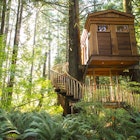
Jul 19, 2021 • 8 min read
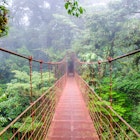
Jan 8, 2021 • 6 min read

Nov 23, 2020 • 4 min read

Oct 13, 2020 • 3 min read

Jun 26, 2020 • 4 min read
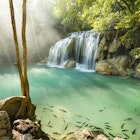
Jun 9, 2020 • 1 min read

How Tourism Benefits Nature and Wildlife
The Great Barrier Reef. Yellowstone. The Amazon Rainforest. One of the top reasons that tourists are drawn to destinations such as these is because of their rich biodiversity and unique landscapes.
According to Brand USA, 2 of the top 5 motivators for selecting vacation spots are ecotourism and nature. Wanderlusters are seeking experiences that reflect the true essence of the places they are visiting. In other words, they want to visit places with unspoiled environments and thriving native wildlife.
We often hear about all of the ways that humans are destroying wild places and jeopardizing the health of the planet – and rightfully so. Over 75% of land environments have been severely altered by humans and species are facing extinction at up to 1000x the natural rate. While there’s no denying that irresponsible tourism contributes to this devastation, we shouldn’t overlook the important role that sustainable and well-managed tourism plays in advancing conservation and protecting our world’s treasured ecosystems. These benefits have only been further evidenced by the current COVID-19 crisis and the resulting halt in tourism.
In this blog post we’ve highlighted just a handful of the different ways that tourism benefits nature and wildlife. Read on to learn more!
Increasing Community Support for Conservation
Over the last decade, nature-based tourism has become increasingly popular. In total, wildlife tourism now supports nearly 22 million jobs around the world and contributes more than $120 billion to global GDP.
This growing interest in wildlife tourism, and the economic benefits that come along with it, can change community attitudes towards conservation. Without tourism, local communities may merely view wild animals as a danger to their farms and families, and only value natural resources for consumption. But when animals and natural areas bring tourism dollars and jobs to their community, it can help residents see the importance of keeping their natural assets intact and healthy.
In Cambodia, for instance, ecotourism is motivating communities to conserve critically endangered bird species, such as the giant ibis and white-shouldered ibis. Thousands of tourists come from across the world to see these rare and iconic species. The birding operator Sam Veasna Conservation Tours incentivizes community-based conservation in the region by training and employing locals as guides and ecotourism providers, and requiring visitors to donate to village development projects. In return for this income and employment, community members agree to not hunt or cut down trees. To date, Sam Veasna’s visitors have contributed over $500,000 to local communities, making a strong case for the importance of protecting their unique birdlife.
Creating Sustainable Livelihoods
Beyond changing mindsets, tourism can prevent ecosystem degradation by creating more sustainable livelihoods for local communities. Jobs as guides, cooks, or housekeepers offer alternative income sources to environmentally-destructive activities such as logging, slash-and-burn agriculture, quarrying, or illegal hunting.
In Rewa, Guyana, poor job security led villagers to illegally harvest and trade wild animals. As a result, wildlife species such as arapaimas, giant river turtles, and giant otters were beginning to disappear. In 2005, the village opened a community-run eco lodge to improve livelihoods while protecting its ecological diversity. By employing community members as sport fishing guides and boat captains, the lodge allows villagers to maintain rainforest-based livelihoods without causing damage to the ecosystem. Thanks to tourism, arapaimas, turtles, and otters are now common in the Rewa River. Not to mention, visitors contribute far more money to the local economy than wildlife exploitation did. In fact, research shows that globally wildlife tourism is 5x more lucrative than illegal wildlife trade!
Raising Environmental Awareness of Tourists
Tourism not only bears the capacity to shift local mindsets and behavior, it can also raise environmental awareness among tourists. From camping to beach lounging, tourism provides countless opportunities for individuals to learn about the natural world and experience it firsthand.
When people connect with nature during their travels, it can lead them to appreciate it more and become invested in protecting it. Tours, parks, and other travel experiences often facilitate this type of environmental learning through interpretive techniques such as educational brochures, exhibits, or guided excursions. Whale watching, for instance, has been shown to raise visitors’ knowledge of aquatic mammals and increase their support for whale conservation. And on the Great Barrier Reef, guided boat tours and marine biology talks have been found to influence visitor behavior and minimize the damage that they cause to the reef.
In Chilean Patagonia, interpretive panels have been installed along one of the world’s most iconic trekking circuits in Torres del Paine National Park. The panels, which were designed by the Torres del Paine Legacy Fund , educate visitors about the wetland ecosystem they’re traversing, and provide information about the plants and animals found there.
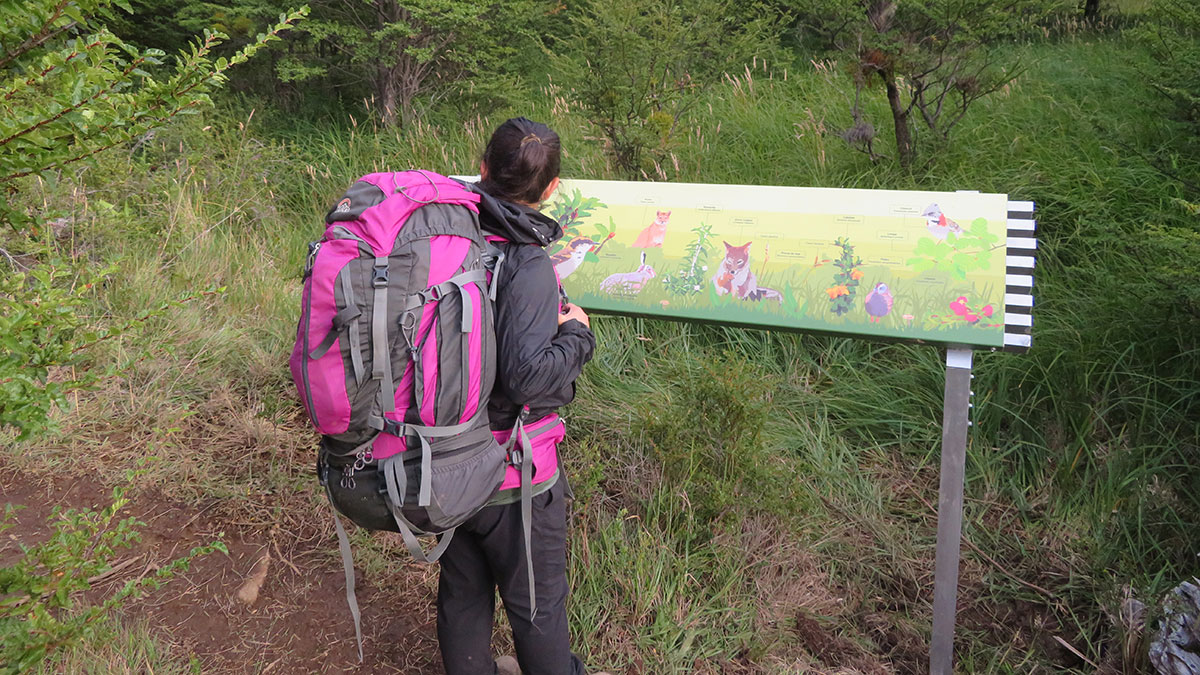
A hiker reads about the types of wildlife that reside in Torres del Paine National Park. Photo: Torres del Paine Legacy Fund.
Prompting Conservation Policies & Protected Areas
Tourism can also provide a compelling incentive for governments and organizations to institute environmental policies and conservation measures. This includes the creation of national parks, nature reserves, and other protected areas to preserve their biodiversity and correspondingly boost their tourism appeal.
Due to the popularity of coastal tourism in particular, reef-based activities such as scuba diving, snorkeling, boat trips and whale watching are a particularly important source of economic revenues. In fact, it is estimated that coral reefs generate $36 billion in global tourism value per year. Many countries rely on the income that comes from marine-based tourism and see the importance of protecting their coastlines, coral reefs, and beaches.
In the Galapagos, for instance, marine-based tourism is worth over $178 million per year, and supports over a third of all jobs. The islands are a hotspot for large and rare marine life, including the highest abundance of sharks on the planet. Thanks to spending by divers and other marine tourists, a single shark in the Galapagos is worth about $5.4 million over its lifetime, while a dead shark only brings in $200 to fishermen. Realizing the economic importance of its life below water, the government introduced no-fishing zones in 2016 to prevent the extraction of sharks and safeguard the island’s marine tourism value.
Mountain gorillas are another species that has benefited from tourism-motivated conservation policies. These endangered apes can only be found in Uganda, Rwanda, and the Democratic Republic of the Congo. In Uganda, gorilla trekking permits start at $600 and the economic value of gorilla tourism is estimated to be as much as $34.3 million . This has led to policies and strategies that support conservation, such as veterinary interventions, intensive law enforcement, community conservation projects, regulated ecotourism, and transboundary collaboration among government institutions and NGOs. Thanks to these efforts, the number of gorillas within the Virunga Mountain region rose from 240 in the 1980s to 604 in 2016 . Now they are the only wild ape population whose numbers are increasing !
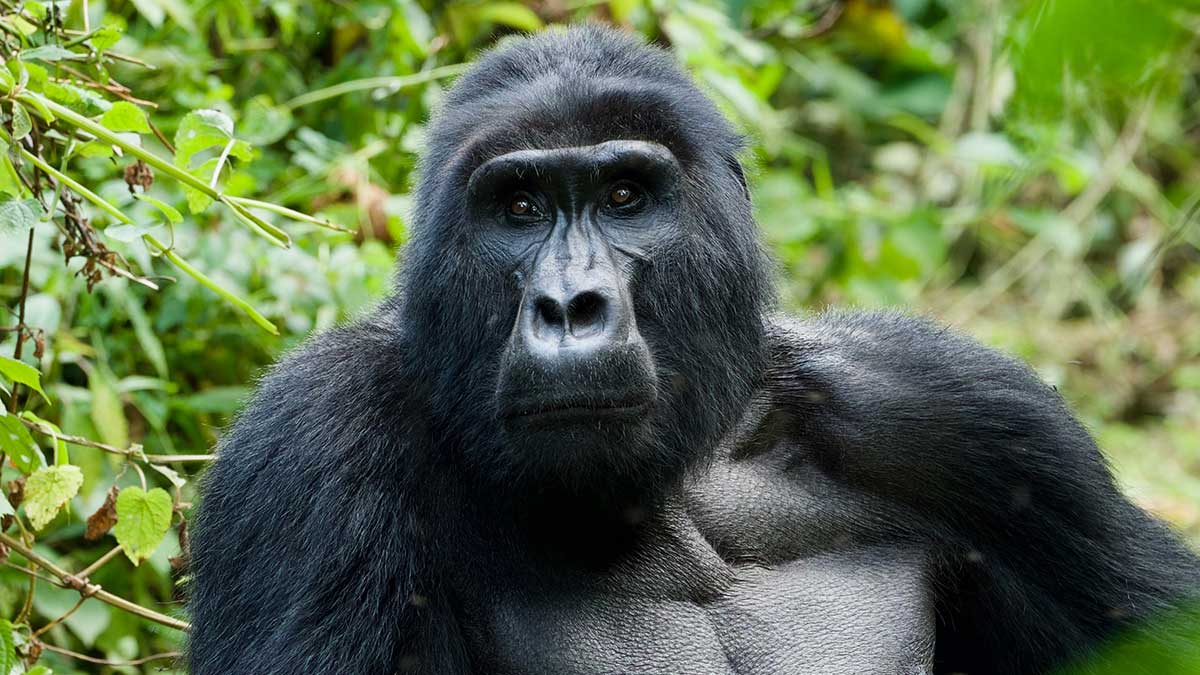
Financing Conservation
But simply establishing protected areas isn’t enough on its own. Ensuring the conservation of the sensitive environments and vulnerable species that these areas aim to protect requires effective management and conservation measures.
However, this is easier said than done. Around the world, many protected areas are under-funded. In fact, the global funding gap for effectively managing these sites is estimated to be up to $440 billion dollars per year. Tourism plays an essential role in bridging this gap by providing an additional source of funding. Proceeds from visitor entrance fees, operating permits, accommodations, and guiding services can help pay the salaries of park rangers and guards, and fund necessary management activities such as ecosystem monitoring, anti-poaching patrols, invasive species eradication, and environmental educational programs.
In Africa, tourism is an important source of funding for land and wildlife conservation. SANParks, the public entity responsible for managing South Africa’s national parks, raises more than 80% of its funding from tourism. Chumbe Island Coral Park, a marine protected area off the coast of Zanzibar, takes this model a step further and is funded entirely by ecotourism income. Thanks to effective management, Chumbe Island is home to one of the most pristine coral reefs in the region.
In addition to financing protected areas, tourists and tourism businesses may also contribute directly to local conservation initiatives. In St. Kitts, local tourism businesses donated $18,500 to fund the planting of fruit trees to protect coastal areas. At Vail Resorts, guests are invited to donate $1 when they purchase a season pass, lift ticket, hotel stay, or shuttle ride. In 2019, Vail’s program raised over $975,000 for on-the-ground conservation efforts that help restore habitat, improve forest access, and preserve land.
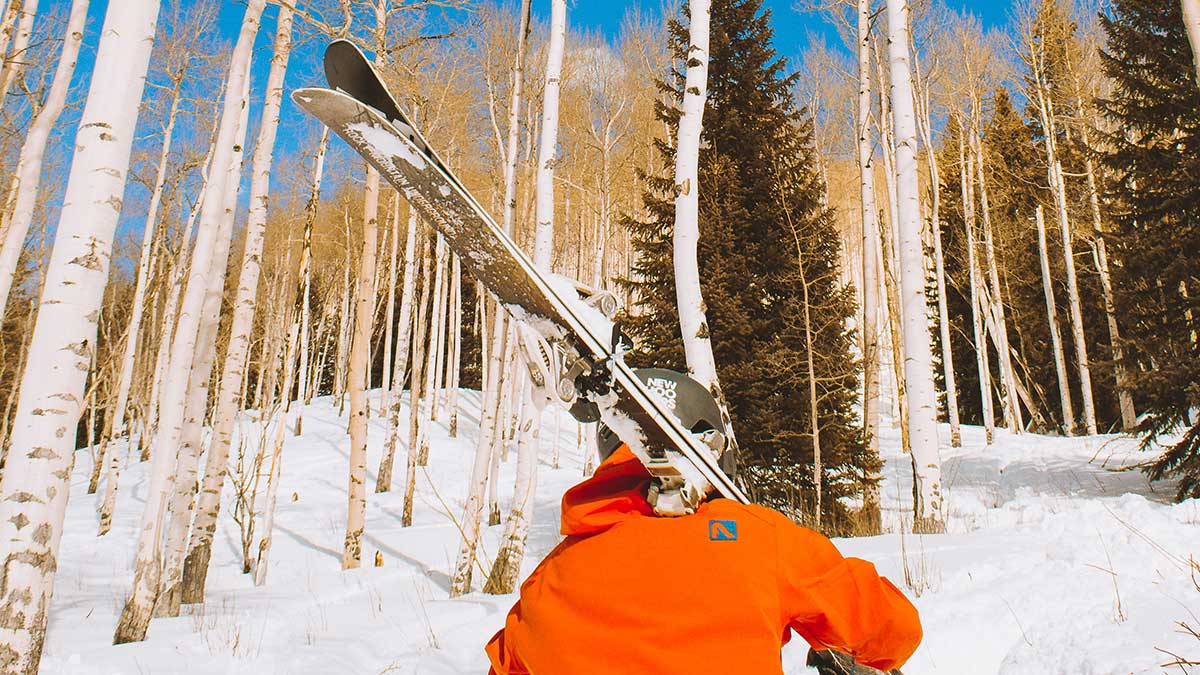
Carbon offsetting is another way that individuals and businesses can contribute to environmental conservation projects, while also mitigating their own emissions. Luxury tour operator TCS World Travel, for instance, partners with Sustainable Travel International to offset the carbon emissions generated by their jet trips. Through this partnership, TCS supports the Madre de Dios project which protects critical rainforest habitat and endangered species in the Peruvian Amazon.
Aiding Ecosystem Monitoring
While park rangers and guards play a critical role in patrolling sensitive environments, tracking ecosystem health, and warding off threats, it is often impossible for them to monitor such vast areas by themselves. The mere presence of tourists in natural areas can protect wildlife by providing an extra set of eyes on the ground.
In Africa, safari vehicles and guests deter poachers from wildlife conservancies, helping to safeguard highly targeted species such rhinos. The COVID-19 pandemic has further highlighted the critical role that tourism plays in deterring poachers and creating safe havens for wildlife. As visitation has come to a halt, rhino poaching has reportedly increased in tourism hotspots.
The Great Barrier Reef Marine Park Authority’s “Eye on the Reef” program is an even more intentional effort to engage tourists and operators in ecosystem monitoring. The program engages divers and marine tourism providers in watching over the Great Barrier Reef by reporting the coral, fish, pollution, and invasive species they see via a citizen science app. Sustainable Travel International is currently developing NEMO, a similar reef monitoring program for use on the Mesoamerican Reef.
There are countless other citizen science programs that aim to fill different research gaps, and that visitors can participate in during their trip. Whale watchers, for example, can contribute to whale identification and tracking by submitting their photographs of humpback whales via the HappyWhale website. To date, more than 260,000 photos have been submitted to HappyWhale, and more than 38,000 individual whales identified.
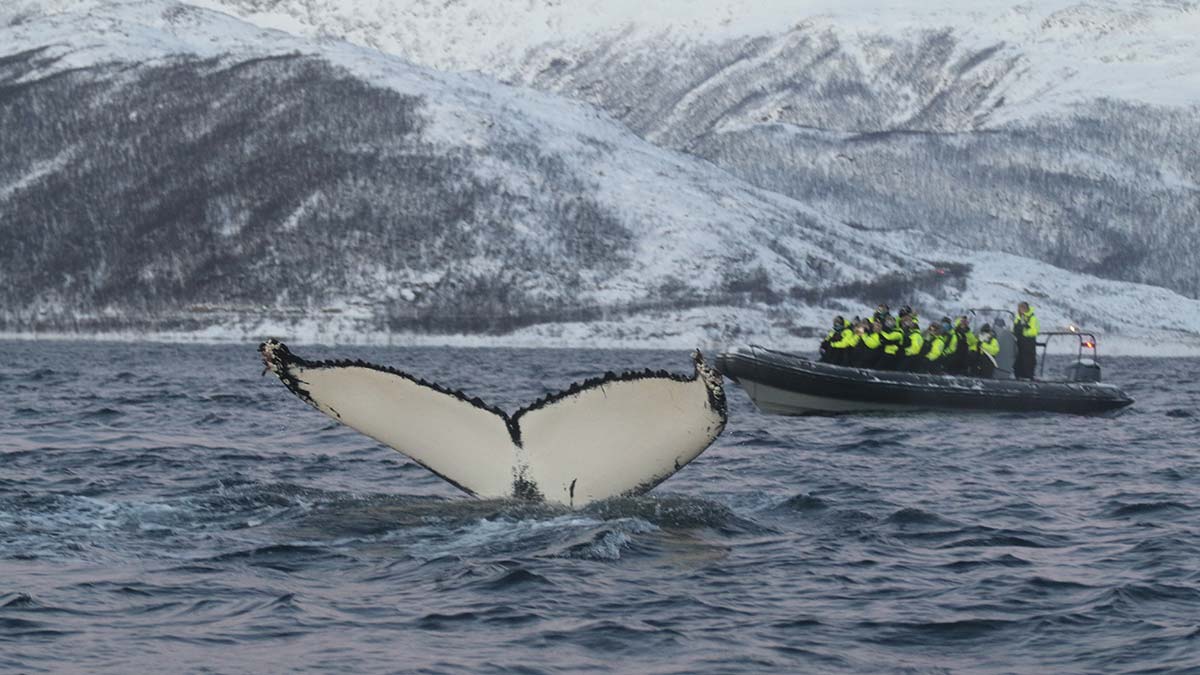
Tourism businesses may also aid researchers in collecting environmental data. In Nevis, the Four Seasons Resort helps researchers study the migration patterns of critically endangered hawksbill sea turtles that nest on the island’s beaches. Resort guests help look for nesting sea turtles which are then fitted with a satellite transmitter and released into the sea. To date, 21 turtles have been released through this program.
Supporting Habitat & Ecosystem Restoration
Along with putting on their scientist cap, visitors and tourism businesses can support conservation by participating in ecosystem restoration.
In Bonaire, local dive operators are lending a hand in restoring the island’s coral reefs by training tourists and divers on basic reef restoration techniques. Once they are trained, visitors can help maintain coral nurseries and outplant coral fragments onto degraded reef sites. To date, more than over 22,000 corals have been outplanted onto Bonaire’s reefs.
Visitors and tourism businesses can also participate in the removal and eradication of non-native species which devastate local habitats. In Mexico, divers and guides lend a hand in hunting invasive lionfish which are a serious threat to the Mesoamerican Reef. After they are captured, the fish are grilled up and served to tourists as a special local dish.
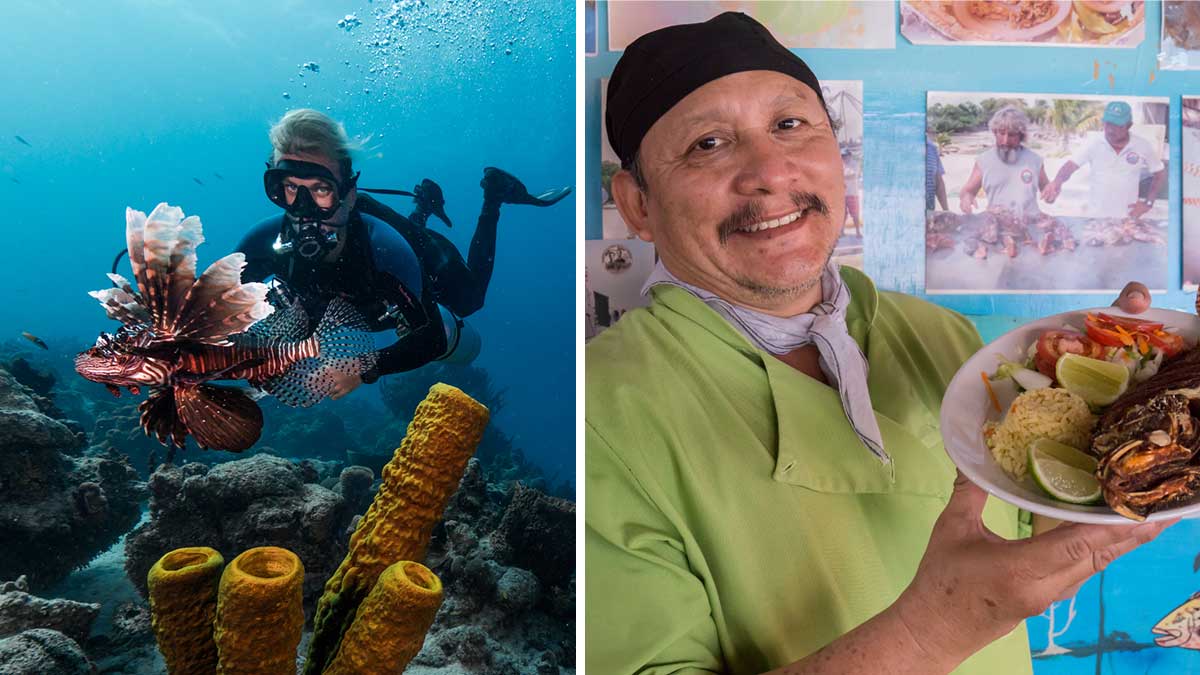
Visitors and tour guides can also help restore ecosystem health by cleaning up the environments they visit. For example, more than 86,000 scuba divers have removed litter from the oceans as part of Project Aware’s “Dive Against Debris” program.
Advancing Green Technologies & Fueling Innovation
Because of its economic importance and influence, tourism can trigger environmental innovation through the advancement of green infrastructure, processes, and technologies. For instance, tourism can lead the way in the development of renewable energy infrastructure, like wind and solar farms, on remote islands or rural areas that would not usually be exposed to clean energy.
In Aruba, tourism is the primary economic activity, representing 73% of GDP. Realizing that the future of its tourism industry depends on environmental sustainability, Aruba’s public and private sector have invested in innovative solutions. Aruba’s Bucuti & Tara Beach Resort, for instance, is considered an eco-pioneer in the Caribbean due to the novel sustainability initiatives that it not only implements, but also develops. Among its achievements, the property heats its water via solar panels, installed exercise equipment that produces electricity, utilizes water saving devices in its bathrooms, and reuses greywater to irrigate its gardens. The resort aids the sustainability transition on the island by offering tours of their grounds and sharing their practices with others.
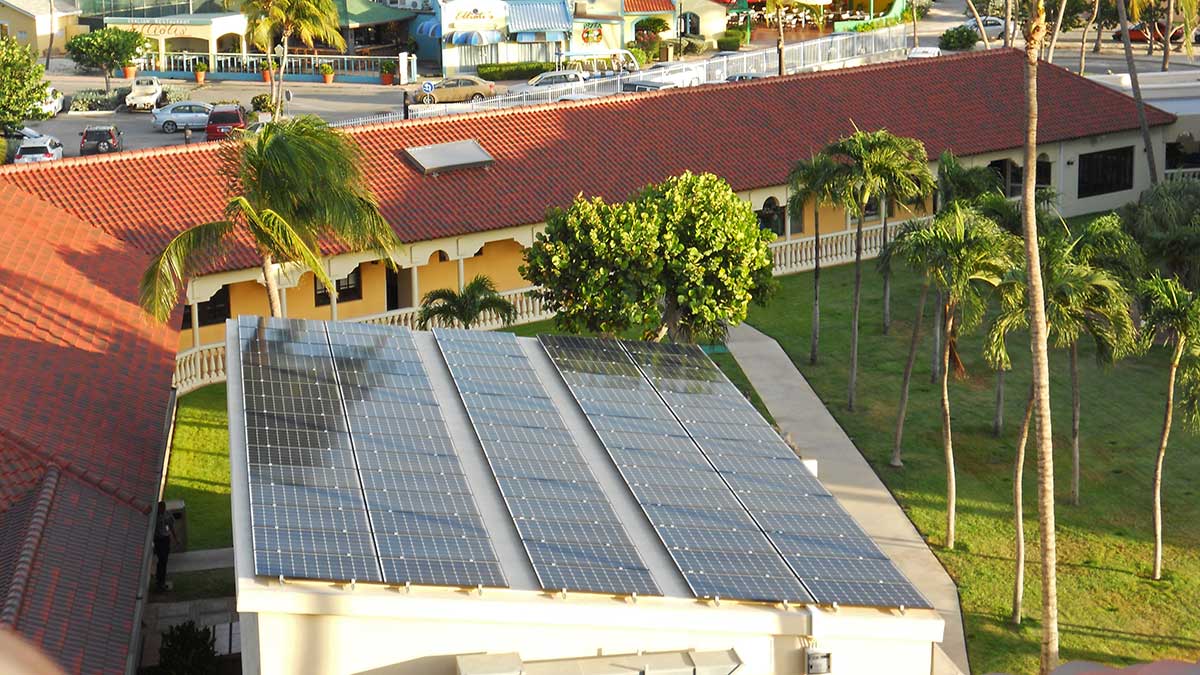
In Oregon, tourism supported the expansion of electric vehicle infrastructure along the state’s rural roads and scenic highways. The state’s tourism commission, Travel Oregon , helped facilitate the installation of electric vehicle charging stations near tourism businesses and developed Electric Byway itineraries. Now, Oregon is home to one of the largest networks of electric vehicle fast charging stations in the country!
Still Progress To Be Made
But of course, all of the benefits above will only occur when tourism happens in a well-managed and sustainable way. As we’ve gained a better understanding of how humans impact the natural world, there have definitely been great strides towards making tourism more eco-friendly. However, our work is far from done. There’s still a lot of room for improvement by everyone involved in tourism – businesses, governments, communities, and tourists – to maximize tourism’s benefits for the planet.
To learn more about how we are helping to amplify the environmental benefits of tourism and ensure that tourism safeguards local ecosystems through our work, click here .
Free Sustainable Travel Tips List
- June 26, 2020
- Blog , Nature & Wildlife
Recent Posts
Sustainable travel: where next docu-series returns for season 3 in 2025, spreading the love: how travel companies can disperse visitors to combat overtourism, climate impact update – 2024 portfolio 4, what is overtourism and why is it a problem, indigenous bunong women weave a brighter future, bird nest guardians in keo seima.
- September 2024
- August 2024
- January 2024
- December 2023
- November 2023
- October 2023
- September 2023
- August 2023
- January 2023
- November 2022
- October 2022
- September 2022
- February 2022
- January 2022
- December 2021
- October 2021
- September 2021
- January 2021
- December 2020
- November 2020
- October 2020
- August 2020
- February 2020
- January 2020
- December 2019
- November 2019
- October 2019
- September 2019
- August 2019
- October 2018
- September 2018
- February 2018
- December 2017
- November 2017
- October 2017
- September 2017
- August 2017
- February 2017
- October 2016
- September 2016
- February 2016
- November 2015
- October 2015
- September 2015
- August 2015
- September 2014
- © 2024 | Sustainable Travel International
- Privacy Policy
Download Our Sustainable Travel Tips List
Subscribe to get your free tips list, plus sustainable travel emails and content
Check your inbox for our Sustainable Travel Tips.
- Prof. Development
Redefining Wildlife Tourism: Ethically Interacting with Animals Abroad

By Nick Callos
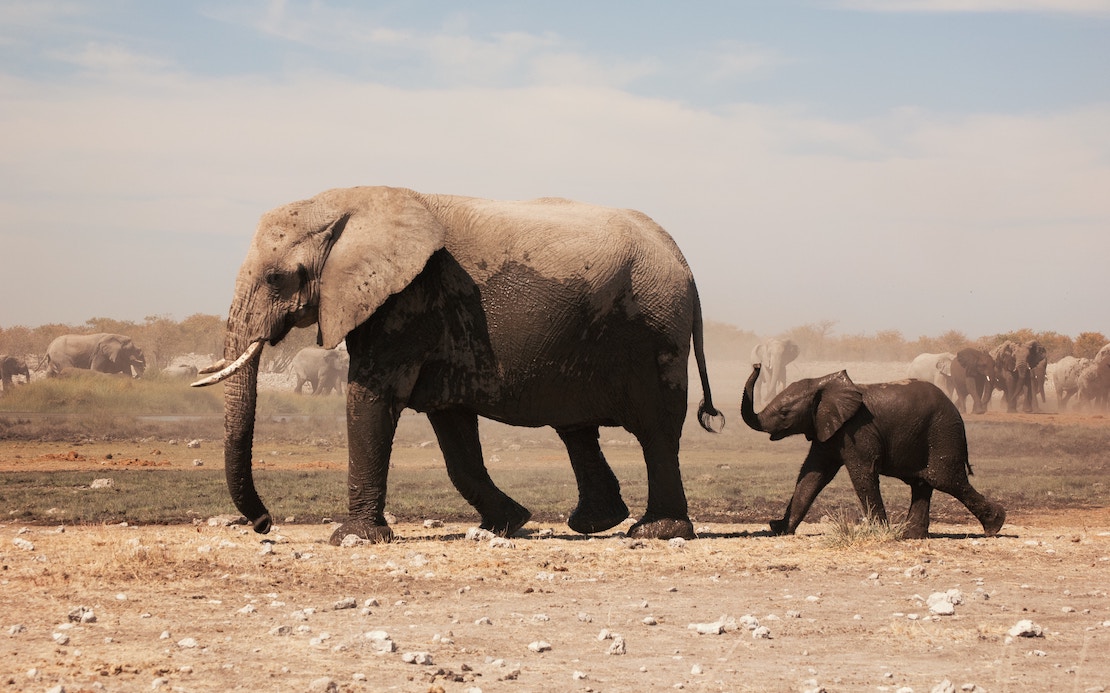
Few things captivate like seeing:
A cheetah running in the grassland… A grizzly bear fishing for salmon… A lion roaring at night…
These sorts of wildlife encounters make you stop, and appreciate the impressive beauty and dignity of animals and nature.
Sadly, not all animal interactions are what they seem. Travelers often aren’t aware of it, but many wildlife tourism activities actually hurt the creatures.
The reality is: Wildlife tourism is a complex industry. As an article in National Geographic notes, “discerning the difference between ethical and problematic wildlife experiences” is a difficult task.
But not all is lost.
Ethical animal interactions and wildlife volunteer projects exist. You can have a positive impact on wildlife, even as a tourist. What’s needed is more education and awareness, and a better understanding of what wildlife tourism should look like. This way, you know to join the right activities.
In this guide, we’ll discuss the dark side of wildlife tourism and explain the right way to interact with animals. We’ll also highlight reputable organizations and projects so you can explore ethical wildlife encounters and animal volunteer work.
The Dark Side of Wildlife Tourism
Perhaps you’ve read about Kim Kardashian riding on an elephant in Indonesia. A quick Google search shows all the criticism she received for it.
Whether the criticism was deserved or not, stories like Kim Kardashian’s should serve as positive learning moments. They should motivate us to learn more about the realities of wildlife tourism, and understand why elephant rides can damage the species.
Here’s an overview of the main issues with wildlife attractions:
Wildlife tourism takes animals out of their natural habitat
Many facilities that specialize in elephant treks, tiger petting, swim with dolphin experiences, and other interactions hold animals in captivity. Given the lack of regulations and oversight, many places don’t offer animals sufficient space and resources to live naturally.
Furthermore, the situation often gets worse than just not enough space. A study of 3,000 elephants in the wildlife tourism industry by World Animal Protection (WAP) found that 75% lived in ‘severely cruel’ conditions (more on this below).
Animal cruelty and abuse is widespread in wildlife tourism
The National Geographic feature, Suffering Unseen , details shocking scenes: shackled elephants, declawed and drugged tigers, abused bears in the circus, and more.
Whether it’s elephant rides or tiger petting, up-close animal interactions may not be as cheery as they look. If the wildlife tourism attractions aren’t prioritizing animal welfare, the creatures you encounter may be experiencing intense suffering.
Some kinds of wildlife tourism don’t prioritize animal rights
The University of Oxford carried out an extensive study on animal welfare in the wildlife tourism industry . Researchers analyzed wildlife attractions across five categories:
- Animal interactions like riding on elephants and swimming with dolphins
- Wildlife sanctuaries that protect endangered and injured animals
- Wildlife farms, like farms where crocodiles are bred for meat
- Animal entertainment, such as street performances
- Wild attractions, such as gorilla sightseeing
Among all the wildlife attractions, only wildlife sanctuaries earn positive scores for animal welfare and conservation. Animal entertainment receives negative scores for both.
As researchers noted, increased demand, a focus on profits, and travelers’ lack of awareness all contribute to the growing animal welfare problem in the tourism industry.
The Right Way to do Wildlife Tourism: No More Elephant Rides or Tiger Petting
Consider this statistic: Wildlife tourism accounts for between 20-40% of global tourism .
Now, we know why wildlife tourism is so popular: Animals amaze us!
But the economics of wildlife encounters create problems.
As stated in the article, Suffering Unseen , the “wildlife tourism industry caters to people’s love of animals but often seeks to maximize profits by exploiting animals from birth to death. The industry’s economy depends largely on people believing that the animals they’re paying to watch or ride or feed are having fun too.”
Tourists, eager to make memories while traveling abroad , don’t consider the possibility of animal cruelty. Even more concerning, animal cruelty can be tough to spot. And pictures on social media only add to the confusion of what’s acceptable.
It doesn’t have to be this way.
The solution is educating yourself before you interact with wildlife. Here are a few tips:
Read the bad reviews
Even for wildlife attractions that have poor animal welfare standards, they may receive good ratings from tourists. When you look up reviews, read the bad ones to see what they say.
As a rule of thumb, David Macdonald, Director of Oxford University’s Wildlife Conservation Research Unit, recommends avoiding any wildlife attraction that scores under 80% on sites like TripAdvisor .
Investigate the facility
Look for evidence the facility focuses on animal welfare and conservation. Find out if:
- the total area is sufficient
- there is space to escape the crowds
- crowd size is limited
- the facility upholds animal rights (for animals in captivity, the ASPCA says animals should have the freedom to express normal behavior , as well as freedom from hunger and thirst, discomfort and pain, injury and disease, and fear and distress)
Finally, ensure animal interactions only benefit the animals. View pictures, check out the website, and read reviews. They absolutely should not offer elephant rides, tiger petting, monkey performances, and other similar wildlife encounters. These activities hurt and stress the animals, and can cause long-term trauma.
Unless you’re giving medical attention, or providing care to captive-born wildlife that can’t return to the wild, you should not have physical contact with wild animals. Activities should be observation-based and include tasks designed to support their existence in nature.
Go into the wild
The best way to avoid the mistake of supporting a harmful wildlife attraction is to only visit natural environments. This includes observations of animals in national parks and wildlife sanctuaries. Such places protect animals from activities like illegal poaching and pet trading.
For instance, through Global Vision International (GVI), a leader in ethical volunteer abroad adventures , you can join a wildlife research project in Kruger National Park. As a volunteer for big cats in South Africa , you can see lions, cheetahs, and leopards in their natural habitat, and you can improve conservation strategies to ensure they can thrive in the wild.
Look for international certifications
Ethical wildlife attractions have obtained certification and have undergone third-party inspections. Some common certifications that demonstrate a commitment to animal welfare include:
- Blue Flag certification : awarded to sustainable marine tourism operators
- Fair Trade Tourism certification : awarded to those who follow best practices of responsible tourism
Volunteer for animals abroad
If you want to encounter wildlife but don’t want to contribute to anything unethical and harmful, volunteering offers you a solution. Just look for organizations that focus on ethical animal volunteer work.
For example, Via Volunteers , an ethical volunteering organization in South Africa , only works with the most responsible wildlife sanctuaries and projects. Their Lion Sanctuary project near Cape Town has earned international praise for exceptional care of captive-born lions. As a volunteer, you’ll ensure lions get treated with dignity and respect, and are protected from commercial use and breeding.
What do Ethical Animal Interactions Look Like?
Now, you know wildlife tourism should NOT entail:
- selfies with lions
- elephant rides
- tiger petting
What wildlife tourism should involve is:
- animal rescue and care, such as caring for rescued sea turtles
- observing creatures in the wild, such as ethical safaris in Tanzania
- conservation, research, and protection, like panda research in China
If you want to observe and study animals in the wild, or take part in work to protect endangered wildlife, consider conservation and research projects. Organizations like Projects Abroad run wonderful conservation initiatives around the globe, from shark conservation research in Fiji to Big 5 wildlife conservation in Botswana .
So, even though you’ll actively avoid wildlife tourism activities like petting a tiger and riding on an elephant, you still have plenty of options. And by opting to participate in only ethical activities, you can make a real and lasting contribution.
We Have the Power to Change Wildlife Tourism
In the following sections, we detail the different ways you can ethically interact and volunteer with animals abroad.
Don’t think of these activities as alternatives to wildlife tourism. Rather, think of them as a form of responsible wildlife tourism.
After all, we can redefine wildlife tourism. By making more educated and ethical choices about how we interact with animals, and also by spreading the word to others, we can inspire collective action. And we can make the focus of wildlife tourism about animal welfare and conservation.
Wildlife Protection, Rehabilitation, and Release
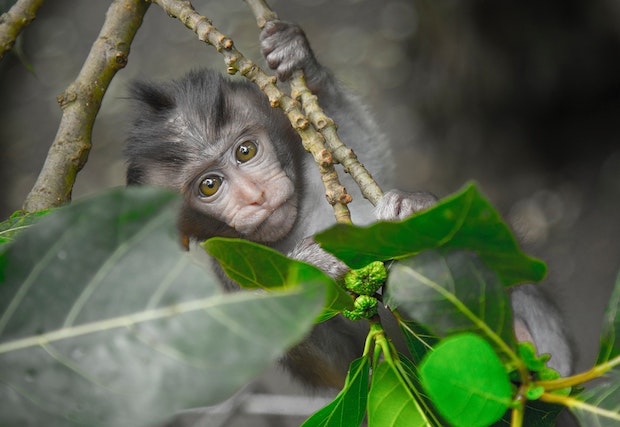
The National Wildlife Federation has summarized main threats to wildlife:
- exploitation of resources by humans
- spreading of invasive species and disease
- habitat degradation and loss caused by climate change and pollution
- poaching, illegal pet trading, trophy hunting, etc.
- the abuses of the wildlife tourism industry
Whether it’s deforestation from commercial logging or more drought from changing precipitation patterns, animals face a variety of threats. Many majestic creatures, such as the chimpanzee , deal with displacement and diminishing room to call home.
Many of these animals, especially those that have experienced cruelty in the wildlife tourism and illegal pet trade industries, have become seriously hurt and ill. They require medical attention and sanctuaries just to survive. This is where you can make a difference.
If you want to ethically interact with animals abroad, focus on helping animals in need get back on their feet (or wings!). Volunteer with animals at wildlife sanctuaries and responsible rehabilitation and rescue centers. Plenty of great organizations support projects throughout the globe (see below).
Plan My Gap Year (PMGY)
Founded in 2011, Plan My Gap Year (PMGY) has become a leading volunteer travel organization. They send 4,000+ volunteers abroad each year and consistently receive great ratings from project participants.
Operating across 17 countries, PMGY’s fees for wildlife conservation and animal rescue projects begin from just $225. PMGY’s affordability, transparency, and strong ethical commitment make them a terrific organization to choose if you wish to volunteer with animals abroad.
Wildlife Rescue in Thailand
Price: from $210 per week ($1,014 for two weeks; $2,514 for 12 weeks)
Length: 1 to 12 weeks
Habitat degradation and loss have pushed many of Thailand’s creatures near extinction. At the wildlife rescue center , you’ll assist with rehabilitation and release efforts for animals that have been injured or fallen ill. The shelter houses gibbons, langurs, lorises, bears, otters, wild cats, and other amazing animals. Your work won’t involve physical interactions with the animals, but you will create environmental enrichments, prepare and distribute food, clean enclosures, and maintain forest areas.
You’ll stay in a bungalow with other volunteers during the program. When you’re not volunteering with animals, explore the scenery of Kaeng Krachan National Park and the beaches of Cha-am.
Sound like the perfect trip? Apply to be a wildlife rescue volunteer in Thailand!
Wildlife Rescue in Bali
Price: from $218 per week ($729 for two weeks; $3,489 for 16 weeks)
Length: 1 to 16 weeks
Indonesia’s forests are home to wonderful biodiversity, but animals face rapid deforestation and environmental degradation from rubber and palm oil plantations. Many endangered animals, such as the Javan lutung, pig-tailed macaque, palm cockatoo, sea turtle, and grey-headed fish eagle, have lost their native habitat or been abused in the wildlife tourism industry or illegal pet trade. As an animal volunteer with PMGY , you’ll work at a center dedicated to rehabbing and releasing these rescued primates, birds, and reptiles. Duties include:
- mangrove conservation for biodiversity preservation
- feeding and enrichment (hands-off tasks)
- enclosure cleaning and maintenance
- assistance with release back into the wild
When you’re not volunteering with animals in Bali, do yoga, relax on the beach, hike in the forests, and more.
Already thinking about Bali? Register now!
Projects Abroad
Projects Abroad began in 1992 with the goal of connecting volunteers to impactful service projects. To date, they’ve placed more than 125,000 volunteers overseas on a variety of projects, including ethical animal conservation initiatives.
Projects Abroad is a champion of Responsible Travel and works towards the United Nations Sustainable Development Goals. They get great reviews on Volunteer Forever , with a rating of 4.7 out of 5 stars across nearly 350 reviews. If you want to volunteer with animals abroad, Projects Abroad deserves your consideration. They thoroughly vet each wildlife volunteer project for ethical commitment, quality, safety, and impact. So, you can be sure you’re doing good for wildlife.
Giraffe and Lion Conservation in Kenya
Price : $2,970 for 1 week; $4,260 for 4 weeks
Length : 1 to 52 weeks
Want to protect endangered animals in the savannah? Then head to Kenya, where you’ll work with conservation experts at Soysambu Conservancy, an entity in charge of protecting and conserving local flora and fauna and wildlife. As a volunteer with the conservancy, your tasks will include:
- Researching endangered species in the area, such as Rothschild’s giraffe
- Setting up cameras to monitor wildlife behavior
- Planting trees and removing invasive plants
- Managing waterholes the animals use
As you can see, this wildlife conservation project in Kenya doesn’t involve harmful tourist activities, like elephant rides or tiger petting. The goal is to collect data so that we can protect endangered animals and help them thrive.
Interested in signing up? Click here !
Animal Rehab in Peru
Price : $3,220 for 1 week; $4,660 for 4 weeks
Journey to the Amazon and help with wildlife rehabilitation and reforestation. As a volunteer, you’ll work to protect wildlife, indigenous plants, and the future of one of the world’s most important natural areas. Duties range from helping with turtle and butterfly breeding programs to collecting data for biodiversity studies. You’ll also assist with rescuing, rehabbing, and releasing injured wildlife, which is really cool. In this program, your work goes a long way in protecting life in the Amazon rainforest .
If you want to do animal volunteer work abroad in the heart of the Amazon, look no further. The project is based at Taricaya Ecological Reserve, and you’ll have time for travel to popular cities and sites in Peru, such as Cusco and Lima.
Ready to go? Sign up as a wildlife rehab volunteer in Peru here !
Animal Rescue, Care, and Adoption

Think about this: In the USA alone, more than 6.5 million dogs and cats enter shelters each year , according to the ASPCA. Across the world, animal rights and animal ethics still have a long way to go, and that’s causing widespread homelessness and cruelty.
As Maximo Nivel, a leading volunteer abroad organization in Latin America , describes, in many countries, “a lack of education and understanding of animals and their unique needs ” has left side streets filled with “abandoned dogs and cats.” Moreover, “exotic species are sometimes illegally captured and kept as pets,” and farm animals get neglected because farmers lack resources to care for them.
Clearly, domesticated animals, including farm animals, and exotic wildlife are enduring an animal rights crisis. From hunger to physical and emotional illness, the consequences have become tragic.
Your service is needed . From Vietnam to Ghana to Mexico , animal volunteers can make a significant impact by joining an animal rescue and care project , like the ones below.
Maximo Nivel
If you want to volunteer with animals in Latin America , look no further than Maximo Nivel . A leading organization in study abroad and educational travel in the region, Maximo Nivel began in 2003 and is an internationally accredited organization .
Maximo Nivel is committed to promoting animal rights in Latin America. Their animal care and wildlife volunteer programs strive to protect and heal those creatures that have suffered from abuse, neglect, illegal trading, and other forms of animal cruelty. From horse rescue and rehabilitation in Guatemala to volunteering for exotic animals at a zoo in Peru, you have plenty of opportunities to save animals in need!
Dog and Cat Shelter Volunteering in Guatemala
Price: from $314 per week ($645 for 1 week; $1,255 for 4 weeks)
Length: 1-4+ weeks
Make the trip to Antigua, a UNESCO World Heritage City known for its Spanish colonial buildings. There, you’ll care for stray cats and dogs that deal with hunger and health issues. When you volunteer with the stray animals , you’ll offer much-needed human company, provide food, groom the cats and dogs, and assist with veterinary care. You’ll help solve a public safety problem as well. Other duties include carrying out educational outreach, running fundraising campaigns, and getting involved with spay/neuter programs.
During off-hours, view the architecture in Antigua, hike in the nearby mountains, and immerse yourself in local culture. Sounds like quite the volunteer vacation, right?
Reserve your place at the dog and cat shelter in Guatemala!
Alpaca Farm Volunteering in Peru
Love alpacas? Then join this unique farm animal volunteer program in Cusco . You’ll help out at a family-owned farm that produces traditional Peruvian textiles from alpaca and llama wool. The alpacas and llamas are ethically raised, and your job as a volunteer will be to care for them. That includes feeding, cleaning pens, and doing light farm construction.
What’s also nice is that Cusco, a city in the Peruvian Andes, sits close to Machu Picchu, the Sacred Valley, and other Inca Empire sites.
Ready to go? Sign up to volunteer with alpacas now!
Love Volunteers
Love Volunteers has become known for their affordability, transparency, and commitment to making a lasting impact . Founded in 2009, Love Volunteers prioritizes intercultural exchange and serving local communities in a way that truly benefits them. With an average rating of 96% from past volunteers, it’s clear they’re doing good work.
Love Volunteers offers plenty of ethical ways to interact with animals abroad, from patrolling African game reserves to monitoring Asian elephants to protecting giant sea turtles. If you want to volunteer with animals at rescue, care, and adoption centers, they have high-quality projects in exciting destinations (see below!).
Animal Rescue in Albania
Price: from $70 per week ($279 for 2 weeks; $829 for 12 weeks)
Length: 2-12 weeks
Contribute your time and energy at an animal rescue center in Tirana , the capital of Albania. The center is the only animal shelter in the entire region, and provides a crucial safe haven for sick, injured, and endangered animals. As a volunteer, you’ll:
- care for mistreated domestic animals
- provide medical attention to injured animals
- engage in cross-cultural exchange with staff and visitors
The animal rescue center in Tirana receives no government support, so your work as an international animal volunteer is essential. When you’re not helping the animals, explore Tirana, a gorgeous city with colorful architecture and surrounding mountains.
Think this is the program for you? Apply here!
Wildlife Rescue in Australia
Does wildlife volunteering in ‘the Land Down Under’ interest you? Then travel to Stanley State Forest, a gorgeous natural area in Victoria. There, you’ll care for indigenous wildlife that have been forced from their natural habitat, orphaned, or injured. The goal is to nurse and rehab these animals so they can return to the wild.
Past volunteers have great things to say about the wildlife rescue project, like Amanda:
“The project manager is wonderfully nice, as are the other volunteers there and, of course, the wallabies and kangaroos are just precious!”
Ready to serve as a wildlife volunteer in Australia? Get a spot in the program today!
Wildlife Research and Conservation
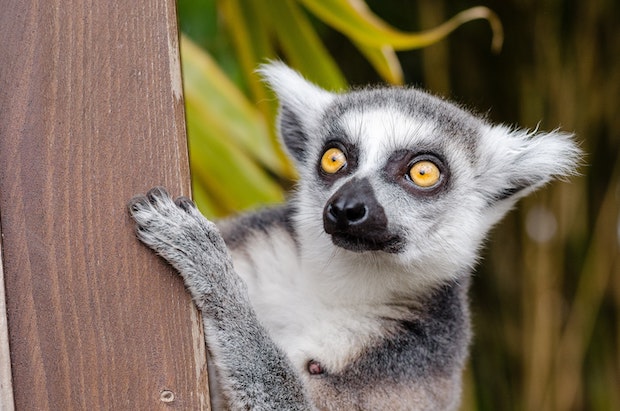
If you want to help animals survive and thrive, contribute to wildlife conservation efforts as a research volunteer.
As Global Vision International , an award-winning volunteer abroad organization that tackles wildlife and environmental issues, states, research volunteers play a vital role in the “success and long-term sustainability” of wildlife conservation programs . Without such support, partner projects “would not have the manpower to conduct their research, protect endangered species, map habitats, and educate local communities on how to look after their unique environments .”
When you serve as a wildlife conservation volunteer , you’ll engage in ethical animal interactions (i.e. observing and monitoring). You’ll get to witness magnificent creatures, like sharks and lions, in their natural habitats.
Want to hear about specific conservation experiences? The organizations and projects below can provide an amazing experience and the chance to leave a lasting, positive impact.
GoEco is a leading ecotourism company and volunteer abroad program provider. They’ve placed more than 17,000 volunteers in projects since beginning in 2006. And they were recognized as the 2018 Top Volunteer Abroad Organization by GoAbroad.
GoEco’s wildlife volunteer projects have sustainable goals, respect animals rights, and only include ethical animal interactions. They have strong ethical values, including a strict wildlife protection policy for all their programs.
Wildlife Research and Conservation in Madagascar
Price: from $358 per week ($1,200 for 1 week; $3,580 for 10 weeks)
Length: 1-10 weeks
Journey to Madagascar, one of the world’s most biodiverse regions. There, you’ll work with wildlife research experts. You’ll take daily trips into the forest, carrying out surveys on birds, mammals, reptiles, and amphibians. You’ll get to study lemur behavior! You’ll also map vegetation, analyze levels of human disturbance, and participate in educational outreach campaigns. The program teaches a lot of practical skills for collecting scientific data. And the data you gather will contribute to wildlife conservation strategies. How awesome is that?
If you want to volunteer with animals abroad , this program gives you an ethical, fun way to do so. You’ll stay in a self-sustained beach camp on gorgeous Nosy Be island.
Join the wildlife research project in Madagascar today!
Great White Shark Conservation in South Africa
Price: from $477 per week ($1,380 for 2 weeks; $5,720 for 12 weeks)
For this project, GoEco partners with a research and ecotourism organization that has received both Blue Flag and Fair Trade Tourism certification. Located in Gansbaai, the Great White Shark Capital, the organization upholds best practices for ethical wildlife tourism and animal volunteer work.
When you join as a great white shark research volunteer , you’ll work directly with marine biologists, conducting research that contributes to conservation initiatives for sharks, whales, dolphins, and African penguins. You’ll assist with daily diving operations designed to monitor and collect data on great white sharks. During those dives, you’ll encounter great whites ethically (there is no feeding or other tricks to draw them close). Other duties include beach cleanups and wildlife tourism education, where you’ll teach about the issues great white sharks face.
Interested? Click here to volunteer with great white sharks in South Africa!
Fronteering
Fronteering’s volunteer abroad programs aim to uplift indigenous communities and protect unspoiled nature. Their wildlife volunteer projects take you to exotic, off-the-beaten-path destinations where you can perform crucial research and preserve the local environment.
Fronteering operates programs across the world, in countries like the United States , Brazil , and Indonesia . Have a real, raw experience in the wild as a research volunteer. Check out two of their best animal volunteer programs below!
Wildlife Research in Guyana
Price: from $462 per week ($2,695 for 4 weeks; $3,695 for 8 weeks)
Length: 2-8 weeks
When you volunteer for wildlife in Guyana , you’ll assist with researching the black caiman, the largest predator in the Amazon ecosystem. Sadly, black caimans, along with other Amazon giants, deal with threats to their existence on a daily basis, from poaching to habitat loss to pollution. Through research, study, and educating the public, you can help turn the tides through better conservation policy and greater awareness.
Duties include looking for signs of poaching, mapping of reserves, making trails, and wildlife monitoring. You may even spot black caimans in the wild!
So, want to help the Amazon ecosystem in Guyana? Volunteer for black caimans today!
Wildlife and Elephant Conservation in Sri Lanka
Price: from $474 per week ($1,195 for 1 week; $1,895 for 4 weeks)
Length: 1-4 weeks
Unfortunately, elephant rides have become a popular wildlife tourism activity in Sri Lanka. When you volunteer on this wildlife conservation project , you’ll work to prevent such abuses. As a volunteer for elephants in Sri Lanka, you’ll:
- collect data on foraging elephants
- gather environmental and socio-economic data to develop community-based conservation strategies
- participate in creating solutions for humans and elephants to peacefully coexist
- teach environmental education in schools
This animal volunteer program takes place in and around Wasgamuwa National Park in the central region of Sri Lanka. As a research volunteer, you’ll help a lot with ensuring Sri Lankan elephants can overcome present challenges and prosper.
Ready to help elephants? Register for this wildlife research project in Sri Lanka here!
Ethical Animal Encounters and Responsible Wildlife Volunteering: a New Way Forward for Wildlife Tourism
It’s time for a new chapter in wildlife tourism. The more we realize the dangers and cruelty of activities like elephant rides and tiger petting, the more motivated we’ll be to seek ethical wildlife encounters and inspire others to do the same.
By serving as a volunteer or intern on animal welfare and conservation projects, and by only going on ethical encounters in natural habitats, you can witness the beauty of wild animals and engage in activities that benefit the animals’ lives. It’s a win-win for both you and the animals.
For more inspiration on how to ethically interact with animals abroad, view our other resources:
The Big 5: Conserve and Protect Africa’s Iconic Animals
Wildlife, Marine Animal, Veterinary, and Conservation Volunteer Abroad
Marine Conservation, Research, and Biology Internships Abroad
Most Popular Guidebooks
2024 best volunteer abroad programs, organizations, and projects, medical volunteer abroad programs for doctors, nurses, pre med students, cheap affordable volunteer abroad programs & low cost overseas projects, teens & high school volunteer abroad programs | under 18 mission trips, 200 volunteer abroad & study abroad scholarships & grants, dental volunteer abroad & medical mission trips | dentists & students, volunteer abroad opportunities for seniors and retirees, nursing volunteer abroad projects for students & professional nurses, short term volunteer abroad programs & mission trips (1 week & 2 weeks), long term volunteer work abroad programs & voluntary charity jobs, trending guidebooks, volunteering abroad after the coronavirus outbreak, 2024 best internships abroad: medical care, marine biology & more, volunteer in australia: animals, conservation, ranching and more.
Nick Callos · Writer
With a BA in English Literature & Writing from Boston College, Nick researches and writes about volunteer, intern, and teach abroad programs worldwide. He has studied abroad and taught English in Chengdu, China, and aims to help fellow travelers make a lasting impact on the communities they visit.

Traveller type
- Solo Travelers
- First Time Travelers
- Female Travelers
- Senior Citizens
- Family & Group
- Teen & High School
- Volunteer Abroad
- Intern Abroad
- Teach Abroad
- Study Abroad
- Professional Development
To stay in touch! Enter your email address to get travel recommendations and be the first to know about our $500-$1,000 travel scholarships!
Thanks for signing up!
Your first email will arrive shortly

Tourism in Russia
Tourism in Russia is big business, but why? Why is this industry so important and how should it best be managed? Read on to find out…
Tourism in Russia
Spanning two continents and enveloping a myriad of cultures, landscapes, and histories, Russia stands as a colossal testament to human civilisation’s diverse tapestry. From the historic domes of Moscow to the vast Siberian wilderness, the country beckons with tales as expansive as its geography . This article delves into the multifaceted allure of Russian tourism, offering a glimpse into a nation where age-old traditions intersect with contemporary vibrancy.
Geographical overview of Russia

Russia is the world’s largest country in terms of land area, covering more than one-eighth of the Earth’s land surface. It is located in northern Eurasia and spans two continents – Europe and Asia. The geography of Russia is diverse and includes a wide range of landscapes, from arctic tundras and deserts to mountains and forests.
In the west, Russia borders Norway, Finland, Estonia, Latvia, Lithuania, Poland, Belarus, and Ukraine. In the south, it borders Georgia, Azerbaijan, Kazakhstan, China, North Korea, and Mongolia. The country has a coastline of more than 37,000 kilometres, which includes the Arctic Ocean, the Pacific Ocean, and the Baltic, Black, and Caspian Seas.
The landscape of Russia is characterised by several major physical features. The Ural Mountains, which run from north to south, separate Europe and Asia. The vast Siberian plains cover most of Russia’s territory east of the Ural Mountains, and they are some of the most extensive and least populated regions in the world. To the east of Siberia lies the mountainous region of the Russian Far East, which includes the Kamchatka Peninsula and the Sikhote-Alin Mountains.
Russia has several major rivers, including the Volga, the longest river in Europe, which flows into the Caspian Sea, and the Ob and Yenisei Rivers, which are among the longest rivers in Asia and flow into the Arctic Ocean.
In terms of climate, Russia experiences a wide range of conditions due to its vast size and diverse landscapes. The Arctic regions of Russia have an extreme polar climate, while the southern regions have a humid subtropical climate. The majority of Russia’s population lives in the western part of the country, where the climate is temperate continental.
Overall, the geography of Russia is vast and varied, with a range of landscapes, climates, and physical features that make it one of the most unique and fascinating countries in the world.
Tourism industry in Russia
Russia is a country with a rich history, culture, and natural beauty, and its tourism industry is gradually growing in popularity. The country’s diverse geography and climate, along with its numerous historical and cultural attractions, make it an exciting destination for tourists from around the world.
Some of Russia’s most popular tourist destinations include Moscow, the capital city, and St. Petersburg, known for its impressive architecture and art collections. Other popular cities include Kazan, Sochi, and Yekaterinburg, each with its unique attractions and cultural offerings.
Russia is also known for its scenic natural beauty, with vast forests, lakes, and mountain ranges that offer opportunities for hiking, skiing, and other outdoor activities. Some of the country’s most popular natural attractions include Lake Baikal, the world’s largest freshwater lake, and the Kamchatka Peninsula, home to several active volcanoes and hot springs.
In addition to its cultural and natural attractions, Russia also offers a unique experience for tourists interested in history and politics. The country has a complex and fascinating history, with several historical sites and museums that offer insights into the country’s past, including the Kremlin in Moscow, the Hermitage Museum in St. Petersburg, and the WWII Museum in Moscow.
Overall, the tourism industry in Russia is still developing, but it has great potential due to the country’s numerous attractions and unique offerings. However, visitors should be aware that the country has its own unique customs and culture, and it is important to research and plan accordingly to ensure a safe and enjoyable trip.

Statistics about tourism in Russia
Here are some of the most current statistics available and the time of publication about tourism in Russia:
- In 2019, Russia welcomed approximately 24 million international tourists, generating $11.4 billion in tourism revenue. (Source: World Tourism Organization)
- The top five source countries for international tourists to Russia in 2019 were China, Germany, South Korea, the United States, and Finland. (Source: Federal Agency for Tourism of the Russian Federation)
- Domestic tourism is also significant in Russia, with over 70 million trips taken by Russians within their own country in 2019. (Source: Federal Agency for Tourism of the Russian Federation)
- Moscow and St. Petersburg are the two most popular destinations for both international and domestic tourists in Russia. (Source: Federal Agency for Tourism of the Russian Federation)
- In 2019, tourism accounted for approximately 3.5% of Russia’s GDP. (Source: World Travel and Tourism Council)
- The tourism industry in Russia provides employment for approximately 4 million people. (Source: Federal Agency for Tourism of the Russian Federation)
- Russia has over 57,000 hotels and other accommodation options, with a total of over 1.6 million rooms. (Source: Federal Agency for Tourism of the Russian Federation)
- The majority of international tourists to Russia visit for leisure purposes, with business travel and visiting friends and relatives also common reasons for travel. (Source: Federal Agency for Tourism of the Russian Federation)
- The most popular time to visit Russia is during the summer months of June to August, although winter tourism is also growing in popularity due to the country’s winter sports offerings. (Source: Federal Agency for Tourism of the Russian Federation)
Most popular tourist attractions in Russia
Russia has many popular tourist attractions that offer visitors a glimpse into the country’s rich history, culture, and natural beauty. Here are some of the most popular tourist attractions in Russia:
Red Square and the Kremlin – Located in the heart of Moscow, Red Square and the Kremlin are two of Russia’s most iconic landmarks. The square is home to the colourful St. Basil’s Cathedral and the GUM department store, while the Kremlin is a fortified complex that includes several palaces, churches, and museums.
The Hermitage Museum – Situated in St. Petersburg, the Hermitage Museum is one of the world’s largest and most impressive art museums. It houses a vast collection of over three million artworks and artefacts, including works by Rembrandt, Da Vinci, and Michelangelo.
Lake Baikal – Known as the “Pearl of Siberia,” Lake Baikal is the world’s largest freshwater lake by volume and is home to a unique ecosystem of flora and fauna. Visitors can take a cruise on the lake or explore the surrounding wilderness on foot.
The Golden Ring – The Golden Ring is a collection of historic towns and cities northeast of Moscow that date back to the 12th century. It includes cities such as Vladimir, Suzdal, and Sergiev Posad, each with its unique architecture and cultural attractions.
Catherine Palace – Located just outside St. Petersburg, Catherine Palace is a stunning baroque palace that was once the summer residence of the Russian Tsars. Visitors can explore the palace’s opulent interiors and stroll through the expansive gardens.
Kazan – Located in the republic of Tatarstan, Kazan is a vibrant city that blends Russian and Tatar cultures. Visitors can explore the city’s UNESCO-listed Kremlin, visit the Kul-Sharif Mosque, or enjoy the vibrant nightlife.
Trans-Siberian Railway – The Trans-Siberian Railway is the world’s longest railway, spanning over 9,000 kilometres across Russia from Moscow to Vladivostok. The journey offers stunning views of the country’s diverse landscapes and is a unique way to experience the country.
Peterhof Palace – Also known as the “Russian Versailles,” Peterhof Palace is a grand palace complex located on the Gulf of Finland near St. Petersburg. Visitors can explore the palace’s opulent interiors and enjoy the beautiful gardens and fountains.
Sochi – Located on the Black Sea coast, Sochi is a popular resort town that hosted the 2014 Winter Olympics. Visitors can enjoy the city’s beaches, ski resorts, and subtropical climate.
Baikal-Amur Mainline – The Baikal-Amur Mainline is a railway that spans over 4,000 kilometres through some of Russia’s most remote and beautiful landscapes. The journey is a unique way to experience the country’s natural beauty and is a popular option for adventure travellers.
These are just a few of the many popular tourist attractions in Russia, and there are many more to discover in this fascinating and diverse country.

Most popular types of tourism in Russia
Russia offers a wide variety of tourism experiences, from historic cities and cultural attractions to stunning natural landscapes and adventure sports. Here are some of the most popular types of tourism in Russia:
- Cultural tourism – Russia’s rich cultural heritage and fascinating history make it a popular destination for cultural tourism. Visitors can explore historic cities like Moscow and St. Petersburg, visit museums and art galleries, and attend cultural events such as ballets and operas.
- Heritage tourism – With its long and complex history, Russia is home to numerous UNESCO World Heritage sites, including the Kremlin and Red Square in Moscow, the historic city of St. Petersburg, and the Golden Ring of ancient towns.
- Adventure tourism – Russia’s vast and diverse landscape offers many opportunities for adventure tourism, including hiking, skiing, and mountain climbing. Popular destinations include the Altai Mountains, Lake Baikal, and the Caucasus Mountains.
- Ecotourism – Russia is home to some of the world’s most unique and unspoiled natural landscapes, making it an excellent destination for ecotourism. Visitors can explore national parks and nature reserves, observe wildlife, and engage in sustainable tourism practices.
- Cruise tourism – Russia’s major cities, including Moscow, St. Petersburg, and Volgograd, are all located on major rivers or coastal waterways, making it a popular destination for river and ocean cruises. Visitors can enjoy scenic views of the countryside while stopping at historic ports and cultural attractions along the way.
- Medical tourism – Russia has a reputation for its world-class medical facilities and expertise in specialised medical treatments. Visitors can take advantage of medical tourism to access high-quality healthcare and wellness services.
- Sports tourism – Russia has hosted many international sporting events, including the 2018 FIFA World Cup and the 2014 Winter Olympics. Visitors can participate in sports activities or attend sporting events, such as soccer matches, ice hockey games, and skiing competitions.
These are just a few of the many types of tourism available in Russia, and the country’s diverse attractions and activities make it an ideal destination for all types of travellers.
Economic Impacts of tourism in Russia
Tourism has become an increasingly important contributor to Russia’s economy, generating significant economic impacts at both national and regional levels. Here are some of the key economic impacts of tourism in Russia:
- Job creation – Tourism is a major employer in Russia, with the industry providing direct and indirect employment opportunities for millions of people. This includes jobs in hotels, restaurants, transportation, retail, and other tourism-related sectors.
- Economic growth – Tourism generates significant economic growth in Russia, contributing to the country’s GDP and generating tax revenues for the government. In 2019, tourism contributed 3.7% to Russia’s GDP and supported 5.5 million jobs.
- Foreign exchange earnings – Tourism is an important source of foreign exchange earnings for Russia, as international visitors spend money on accommodation, food, transportation, and other tourism-related activities. In 2019, tourism generated over $11 billion in foreign exchange earnings for Russia.
- Regional development – Tourism can have a significant impact on regional development, particularly in less developed areas of the country. By attracting tourists to these areas, tourism can stimulate investment in infrastructure and support local businesses, creating new opportunities for economic growth and job creation.
- Stimulating other sectors – The tourism industry also stimulates other sectors of the economy, such as agriculture, handicrafts, and cultural industries. This can help to diversify the economy and create new opportunities for local communities.
- Improved quality of life – Tourism in Russia can also improve the quality of life for local residents by creating new job opportunities, generating tax revenues for public services, and supporting the development of new infrastructure and facilities.
Overall, tourism plays an important role in Russia’s economy, generating significant economic impacts at both national and regional levels. As the tourism industry continues to grow, it is expected to become an even more important contributor to Russia’s economic development.
Social impacts of tourism in Russia

Tourism can have both positive and negative social impacts on a destination, including impacts on local communities, cultural heritage, and social structures. Here are some of the key social impacts of tourism in Russia:
- Cultural exchange – Tourism can promote cultural exchange and understanding between visitors and local communities, helping to preserve and promote cultural heritage. This can include cultural events, traditional music, dance, and crafts.
- Employment opportunities – Tourism in Russia can create new job opportunities for local residents, particularly in rural areas where other employment opportunities may be limited. This can help to improve the standard of living and reduce poverty.
- Community development – Tourism can contribute to community development by supporting the development of local infrastructure and services, such as roads, healthcare facilities, and schools. This can improve the quality of life for local residents.
- Preservation of cultural heritage – Tourism can support the preservation of cultural heritage sites, traditions, and customs. This can include the restoration of historic buildings, preservation of traditional crafts, and promotion of local cultural events.
- Environmental impact – Tourism can have negative environmental impacts, including pollution and degradation of natural habitats. This can harm local communities and wildlife.
- Social disruption – Tourism can also cause social disruption in local communities, particularly in areas with high levels of tourism activity. This can include overcrowding, noise pollution, and loss of privacy.
- Pressure on resources – Tourism in Russia can place pressure on local resources, such as water and energy, which can create conflict with local residents and affect the sustainability of the destination.
Overall, tourism can have both positive and negative social impacts on a destination. To maximise the positive impacts and minimise the negative impacts, it is important to develop sustainable tourism practices that prioritise the well-being of local communities and the preservation of cultural and natural heritage.
Environmental impacts of tourism in Russia
Tourism can have significant environmental impacts on a destination, both positive and negative. Here are some of the key environmental impacts of tourism in Russia:
- Carbon emissions – Tourism in Russia can contribute to greenhouse gas emissions, particularly through air travel and transportation. This can contribute to climate change and impact local ecosystems.
- Water usage – Tourism can increase demand for water, particularly in areas where water resources are already limited. This can lead to water scarcity and impact local ecosystems.
- Waste generation – Tourism can generate significant amounts of waste, particularly in areas with high levels of tourism activity. This can lead to pollution of local waterways and harm local wildlife.
- Land use – Tourism in Russia can lead to increased development and land use, particularly in areas with high levels of tourism activity. This can lead to habitat destruction and loss of biodiversity.
- Natural resource depletion – Tourism can increase demand for natural resources, such as timber, food, and water. This can lead to depletion of these resources and harm local ecosystems.
- Wildlife disturbance – Tourism in Russia can cause disturbance to local wildlife, particularly in areas where wildlife is a key attraction for tourists. This can lead to habitat destruction and impact the ecological balance of the area.
Overall, tourism in Russia can have significant environmental impacts on a destination, particularly in areas with high levels of tourism activity. To minimise the negative impacts and promote sustainable tourism practices, it is important to prioritise environmental protection and conservation in tourism planning and management. This can include promoting eco-friendly accommodation, encouraging responsible behaviour among tourists, and implementing policies to reduce carbon emissions and waste generation.

FAQ’s about tourism in Russia
Now that we know a bit more about tourism in Russia, lets answer some of the most frequently asked questions on this topic:
Do I need a visa to visit Russia?
Most foreign visitors to Russia require a visa. However, some countries have visa-free agreements with Russia, and citizens of those countries can visit without a visa for a limited period.
What is the best time of year to visit Russia?
The best time to visit Russia depends on your preferences and the activities you plan to do. The summer months of June to August are the most popular for tourism, but the winter months can also be a magical time to visit.
What is the currency used in Russia?
The official currency of Russia is the Russian ruble (RUB).
Is it safe to travel to Russia?
Overall, Russia is a safe country for tourists, but like any other country, it is not completely immune to crime. Tourists should take common-sense precautions and stay aware of their surroundings.
What language do people speak in Russia?
The official language of Russia is Russian. English is also widely spoken in major tourist destinations, but it is still a good idea to learn some basic Russian phrases before visiting.
What are the most popular tourist destinations in Russia?
Some of the most popular tourist destinations in Russia include Moscow, St. Petersburg, the Golden Ring, Lake Baikal, the Trans-Siberian Railway, and the Caucasus Mountains.
What is the cost of living in Russia?
The cost of living in Russia can vary depending on the city and the type of lifestyle you lead. In general, major cities like Moscow and St. Petersburg can be quite expensive, while smaller cities and rural areas are more affordable.
Can I use my credit card in Russia?
Credit cards are widely accepted in major tourist destinations in Russia, but it is still a good idea to carry cash as a backup.
What is the public transportation system like in Russia?
Russia has an extensive public transportation system, including metros, buses, trams, and trains. The metro systems in Moscow and St. Petersburg are particularly efficient and affordable.
What are some unique cultural experiences to have in Russia?
Some unique cultural experiences to have in Russia include attending a ballet or opera performance, visiting a traditional Russian bathhouse (banya), sampling local cuisine, and learning about Russian art and history at museums and galleries.
To conclude- Tourism in Russia
So, that sums up this article about tourism in Russia. In the vast expanse of Russia, every corner narrates tales of history, culture, and natural splendour. From imperial cities to sprawling tundras, the country’s diverse tapestry invites travellers to explore and rediscover. As the curtain falls on our exploration of Russian tourism, one truth remains evident: Russia’s allure, both timeless and ever-evolving, ensures it remains an unforgettable destination on the world’s travel map.
If you enjoyed this article about tourism in Russia, I am sure you will like these too:
- 35 Famous Landmarks Of Russia (with photos)
- 35 fascinating facts about Russia
- Tourism in Alaska
- 25 Fascinating Facts About the Indian Ocean
- 30 Fun Facts About Ukraine
- United Arab Emirates
- Switzerland
- The Netherlands
- Puerto Rico
- United States
- New Zealand
- ➨ Choose from World Map
- Budget Travel
- Family Travel
- Getting Around
- Visas & Passports
- Work with Us
Browsing Category
- Czech Republic
- Saint Martin
- Uncategorized

Moscow Travel Guide: Best Things to Do + More [2023]
· everything to know about visiting moscow, including the best things to do and how to get around. ·.

Moscow is Russia’s vibrant capital city, and it also happens to be the largest city in all of Europe. The city’s long and infamous history makes it one of the most unique places we have ever visited.
The architecture ranges from centuries-old palaces to uniform, gray concrete buildings. The people range from cold and private to warm and welcoming. Moscow is a city is strong juxtapositions, and we learned a lot during our time there.
This post will break down all you need to know about visiting Moscow, including the best things to do, how to get there, how to get around, and more.

The Best Things to Do in Moscow
1. explore the red square.
The Red Square is the heart of Moscow. Most of the city’s top attractions can be found here, including just about everything on this list. The Kremlin, St. Basil’s Cathedral, and Lenin’s Mausoleum are all located here, and the State Historical Museum and GUM are not far from here, either.
The Red Square is a common home for parades, protests, and seasonal celebrations. There are massive Christmas celebrations here, with food vendors and carnival rides set up in numbers.

2. Check Out the Ziferblat
The Ziferblat is a café in Moscow that is unlike any café we have ever been to. While most cafes charge you for your drinks and food, the Ziferblat charges you for your time.
Upon arrival, you are given a clock. When you leave, the barista calculates how much time you spent in the café and charges you accordingly. This concept was created to help visitors to be more intentional with their time, and the cafe itself is incredibly charming.
For a detailed look at everything you need to know before you visit, make sure you read my post about visiting the Ziferblat Cafe in Moscow .

3. Marvel at St. Basil’s Cathedral
St. Basil’s Cathedral is one of the most iconic churches in the world, and it was the single thing we were most excited to see while in Moscow. Built almost 500 years ago, St. Basil’s Cathedral is recognized by its colorful domes and whimsical style. The church is of the Russian Orthodox faith, and the inside is just as wondrous as the outside.
St. Basil’s Cathedral is located on the edge of the Red Square, making it incredibly convenient to visit. Entrance for non-worshippers costs 800 rubles, and tickets can be bought at the church

4. Explore the Kremlin
The Kremlin is the largest active fortress in Europe, and it is the site of most of Russia’s government affairs. In addition to government buildings, the Kremlin Complex is filled with courtyards, towers, and museums that are open to the public. If you have the time, you could spend a couple of days fully exploring all that there is to see in the Kremlin.

5. Walk Through Lenin’s Mausoleum
Vladimir Lenin is one of the most important figures in Russian history, and his body is located perfectly embalmed in a mausoleum in the Red Square. The Mausoleum is open to the public to visit, and as long as you are willing to go through a few security checks, it is easily one of the best things to do in Moscow. Its convenient location in the Red Square makes it a can’t miss attraction.
There is absolutely no photography allowed inside the Mausoleum. Do not test this rule.

6. Wander Along Arbat Street
The Arbat is a very popular street in Moscow that is lined with stores, cafes, and other touristy attractions. It is one of the oldest streets in the city, dating back to the 1400s. This street is both quaint and trendy, and there are many walking tours that introduce tourists to the neighborhood’s wonders and highlights.

7. Catch a Show at the Bolshoi Theatre
As a lover of the arts, it is hard to think of Moscow and not think of ballet. Russia has always been a top dog in the world of fine arts, and Bolshoi Theater is one of the best places to catch a performance. We were lucky enough to attend an Opera here, and it is a venue that you don’t want to miss out on if you enjoy opera, ballet, or orchestral performances.
8. Visit the State Historical Museum
The State Historical Museum is one of the most respected museums in Moscow. Despite its name, it is not really focused on the history of Russia as a nation. Rather, it contains a collection of artifacts from all throughout Russia’s history.
The museum’s collection is very broad in nature. It houses some items from indigenous tribes that used to occupy the region, pieces collected by the Romanov family, and more.
9. Wander Around GUM
GUM is an absolutely massive mall within walking distance of the Red Square. It isn’t just the size that draws visitors here; it’s the sense of luxury. The mall is so beautiful inside, much like the metro stations.
While visiting a mall might not sound like it belongs on a bucket list, this mall does. You will not want to miss out on visiting GUM while in Moscow.

10. Admire the Cathedral of Christ the Saviour
While St. Basil’s Cathedral is the most iconic church in Moscow, it isn’t the only one. The Cathedral of Christ the Saviour is absolutely stunning, with massive golden domes. It is the tallest Orthodox church in the world, and it is the seat of the Orthodox Patriarch of Moscow.
It is located just about a mile from the Red Square, just south of the Kremlin Complex. You can walk to it from the Red Square in about 20 minutes.
How to Get to Moscow
Flying to moscow.
Moscow has three major international airports: Sheremetyevo (SVO) , Domodedovo (DMO) , and Vnukovo (VKO) . All three of them are directly connected to downtown Moscow by the Aeroexpress trains, which leave every 30 minutes throughout the day. By Aeroexpress train, you can expect to get to the city center in 25-45 minutes depending on the airport that you fly into.
Sheremetyevo is the biggest and busiest of the three airports, and it is the one you are most likely to fly into – especially if you are coming from outside of Europe or the Caucus region. We flew into Sheremetyevo on a direct flight from New York City.
I usually provide backup airport options, because flying right into the city isn’t always the cheapest way to get where you’re going. Unfortunately, when it comes to Moscow, don’t really have a choice other than to fly right into Moscow. It is a very remote city, and it is usually the cheapest place to fly into in Russia as a whole.
Since Sheremetyevo is so busy, you will probably find a great flight option anyway. I wrote in my post about finding cheap flights that using hub airports will lead to more affordable airfare, and the same logic applies here. Even though Russia’s national airline, Aeroflot, is no longer a member of the SkyTeam Alliance, Moscow is still a major hub connecting passengers from all over the world.

READ OUR CHEAT SHEET
Train or Bus to Moscow
Trains and buses are one of the most popular ways to get around Europe. However, they’re of very little use when you’re trying to get to Moscow.
Moscow is hundreds of miles from the nearest major cities. The only major European city that can even be reached within 8 hours on the ground is St. Petersburg, and even the Baltic capitals of Riga, Vilnius, and Tallinn are over 12 hours away.
If you want to get to Moscow, the best option is almost always to fly. While the train routes to Moscow are scenic, they simply take forever.
How to Get Around Moscow
METRO | TROLLEYS | TRAMS | BUSES
Moscow has one of the most memorable metro systems in the world. Its metro lines are very deep underground, and the stations are absolutely stunning. Each station has its own unique style, but all of them contain escalators that seem to go on forever.

The system was built in an effort to showcase the power of the Soviet Union and its bright future. The plans were a form of propaganda, but they resulted in what is still one of the most visually appealing subway systems on earth.
Moscow’s metro system isn’t just pretty. It is also very useful and accessible. The system has 17 lines that connect the city and its surrounding area.
But wait; there’s more!
The Moscow metro system is also incredibly affordable, with each ride costing less than a dollar. The metro is by far the best way to get around Moscow, as it is almost impossible to beat the connection times and the low cost to ride.
Tickets can be bought at electronic, English-speaking kiosks in stations, or directly from ticket counters at certain larger stations. There are also day passes available, which are a very solid option if you plan on riding the metro several times per day.

The metro is by far the best way to get around Moscow.
In addition to the metro system, Moscow also has a network of buses, trams, and trolleys. This system is nowhere near as convenient or well-connected as the metro, though, and is likely of little use to you during your trip. There is no Uber in Moscow, but a similar app named Yandex is available if you need a ride in a pinch.
How Many Days Do You Need in Moscow?
Moscow is the biggest city in all of Europe, and it is absolutely loaded with things to do. You could spend weeks in Moscow and still find new things to do. Of course, most travelers don’t have that kind of time to spend in one place!
I recommend spending no less than three full days in Moscow, and ideally closer to five or seven.
Moscow is very spread out, and it can take some time to get from one major point to another. There are also so many places that are nice to just sit back and relax, which is hard to do when you’re in a hurry trying to cram activities into just a few days.
If you only have a week to visit Russia, I’d advise spending all of the time in one city. If you decide to split your time between Moscow and St. Petersburg, I recommend not trying to squeeze in any day trips beyond those two cities.

When Is the Best Time of the Year to Visit Moscow?
There are two different ways to approach this question. Personally, I think the best time to visit Moscow is around Christmas and New Year’s Day. While the weather will be absolutely freezing, Moscow is a surreal winter wonderland in December and January.
We were in Moscow right before Christmas. While it was very cold, you can always bundle up. Exploring the Christmas markets and pop-up ice skating rinks throughout Moscow is one of my favorite memories from anywhere I’ve traveled, and I dream of going back to do it again.
If you aren’t fond of the cold, Moscow is beautiful in the summer. It tends to get pretty cold in the shoulder seasons, so if you want warm weather, you should plan to visit in the summer. Moscow actually gets pretty warm in July and August, and there are a bunch of fantastic places to soak up the sun within the city.
The best time to visit Moscow is either around Christmas or from late May to August.

Is Moscow Safe to Visit?
While Moscow is a truly wonderful city, there’s no denying that visiting Russia comes with risks. As the country is run by an infamous communist dictator, concerns about visiting are valid. While we didn’t experience any sort of threat or negative treatment during our time in Moscow, we visited in a peaceful time.
In our experience, Russia doesn’t seem to detain normal Americans or Westerners to use as pawns. As a regular person, as long as you don’t commit any crimes, there is a slim chance you will run into any issues. However, Russia will not hesitate to enforce its laws against foreigners, and illegal behaviors will likely land you in a very compromising position.
Russia will not hesitate to enforce its laws against foreigners, and illegal behaviors will likely land you in a very compromising position.
To make matters worse, Russia has a bad reputation for gang violence. While the Russian mafia has very little interest in normal Western tourists, they won’t hesitate to pick a fight with anyone who ventures into their sphere of influence. If you seek out illegal substances or activities, you could be a target of the mafia.
If you seek out illegal substances or activities, you could be a target of the mafia.
Finally, since Russia’s invasion of Ukraine, things are all very different. Russia is currently at war, and there are battles raging within 8 hours of Moscow. While it is still relatively safe to visit, that could change at any time as the war with Ukraine continues.
Is Moscow Worth Visiting?
Without a doubt, Moscow is worth visiting. It is one of the most unique major cities we have ever visited, and we hope to make it back one day. The Russian Orthodox churches are stunning, the city’s history is unlike any other, and the food is to die for.
While many visitors prefer St. Petersburg to Moscow, I think Moscow deserves a lot of hype of its own. Moscow is the beating heart of Russian culture and history, and it’s a place I highly recommend checking out if you have the chance.

That’s all we have for you about Moscow! I hope this post was helpful as you plan your trip to Russia’s capital.
Have you been to Moscow? Or is this your first time visiting? Comment below if you have anything to add to our travel guide!
Hi, I'm Greg. I'm an avid traveler who has traveled to over 50 countries all around the world with my wife and kids. I've lived in Italy, Mexico, China, and the United States, and I dream of moving abroad again in the future. With this blog, I provide my audience with detailed destination guides to my favorite places and pro-tips to make travel as stress-free as possible.
Leave a comment
Save my name, email, and website in this browser for the next time I comment.

Meet The Author - Greg

Recent Post

Most Famous Churches in Florence, Italy: Where to Visit
July 5, 2024

10 Best Coffee Drinks to Buy From Starbucks in India
April 26, 2024

How Much Does a Trip to Egypt Cost: Budget Breakdown
March 10, 2024

Best Time to Visit the India Gate in Delhi [2024]
March 1, 2024

Flying with a Sinus Infection: Tips to Avoid Pain
February 20, 2024

- Visit The Best 10 Tourist Attractions and Things to Do in Perth, Scotland
- Explore 14 Tourist Attractions and Things to Do in Füssen, Germany
- 20 Lovely Tourist Places to Visit and Things to Do in Tours, France
- 21 Popular Tourist Attractions to See and Things to Do in Basel, Switzerland
- The Best 40 Tourist Attractions to See and Things to Do in Corfu, Greece

27 Tourist Places to Visit and Things to Do in Moscow in 4 Days Trip
Moscow is the national capital city of Russia. The city gets its name from the river Moskva. It is among the largest cities in the world and the largest city in Europe. It is one of the most historically significant cities in the world. The best places to visit in Moscow are some of the most iconic monuments across the globe. The events which took place in this city have had a great impact on global politics, economics and culture. The city has been the center for Russia’s politics for ages. Many of the Moscow tourist attractions outline the governance of the country from this city even before Soviet Union era. The grand duchy of Moscow and Tsardom of Russia had their seat of power in the city.
The city has also been a thriving center for art, culture, architecture and science. Many of Moscow attractions are UNESCO world heritage sites. The country has some of the most iconic buildings which are known around the world. The city is considered the place of origin for Russian architecture and is also home to some of the most exemplary works in that style. The city has been home to several great thinkers, philosophers, musicians, artists, playwrights, dancers, scientists, film-makers, writers and so on. Many people visit Moscow to explore the lives of these revered personalities. The houses and places frequented by them have become Moscow tourist places.
Today, the city has a unique culture of its own, which is unlike any other European city. Firstly, it is the best place to explore for Russian cuisine. There are great many fun things to do in Moscow besides sightseeing as well. The city is known for its partying vibe with its vibrant nightlife. You can also explore the deep culture through theater, public events, art galleries and so on.
Table of Contents
Explore The Best Tourist Places in Moscow in 4 Days (Trip Itinerary)
This section explore some of the most popular things to see in Moscow categorized based on probity to one another so you don’t face a hectic commute during your trip.
1. Red Square
This square is definitely one of the most famous Moscow attractions. It is a place of great historical and cultural significance to the city as well as the country. This is the best places to begin Moscow sightseeing as you are surrounded by various monuments. You will need about an hour for the Red Square.
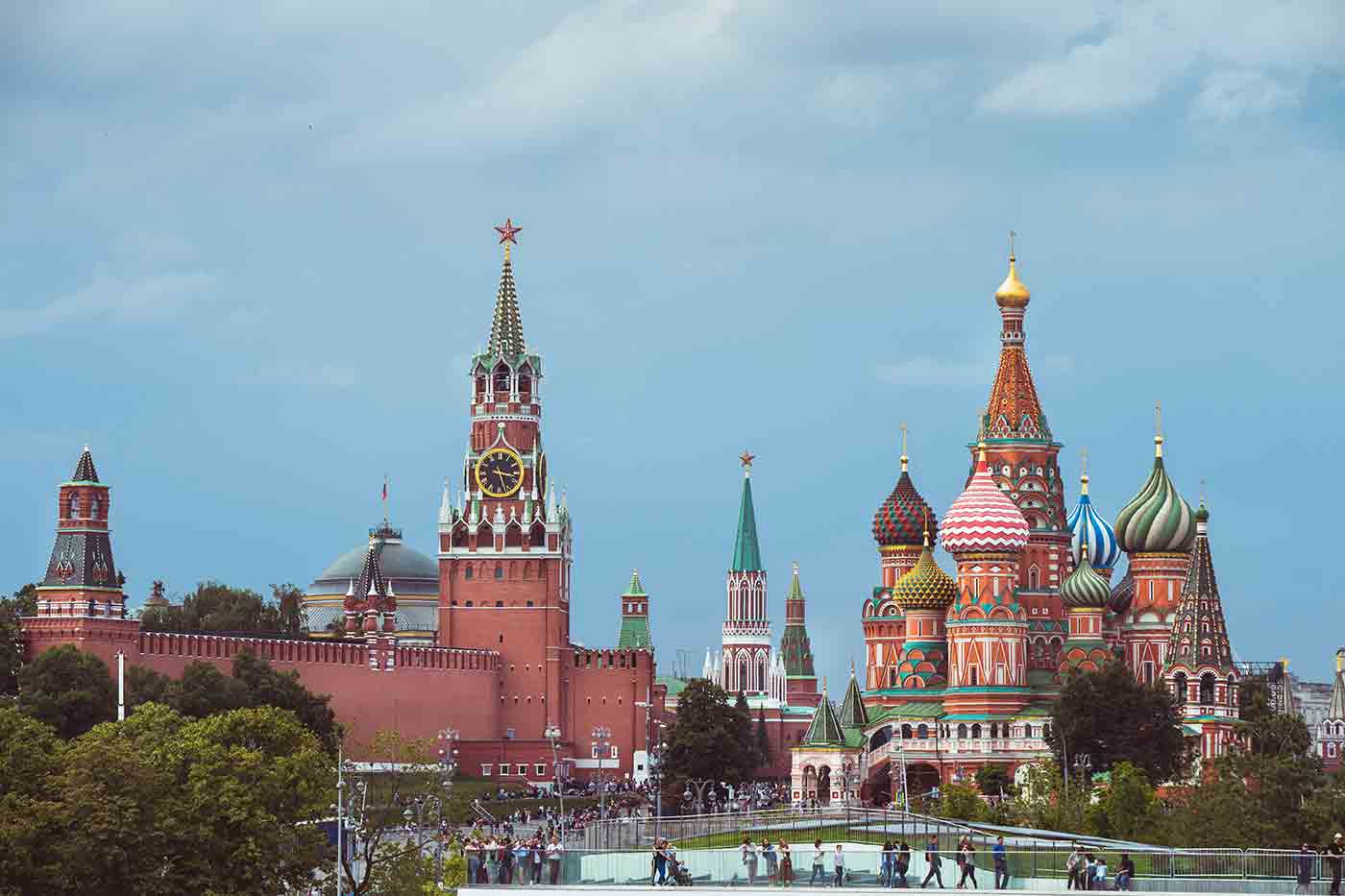
2. Lenin’s Mausoleum
This is the final resting place of the iconic leader of Soviet Union, Vladimir Lenin. It is a place of great historical significance to visit during Moscow travel. You will need 20 to 25 minutes for Lenin’s Mausoleum.
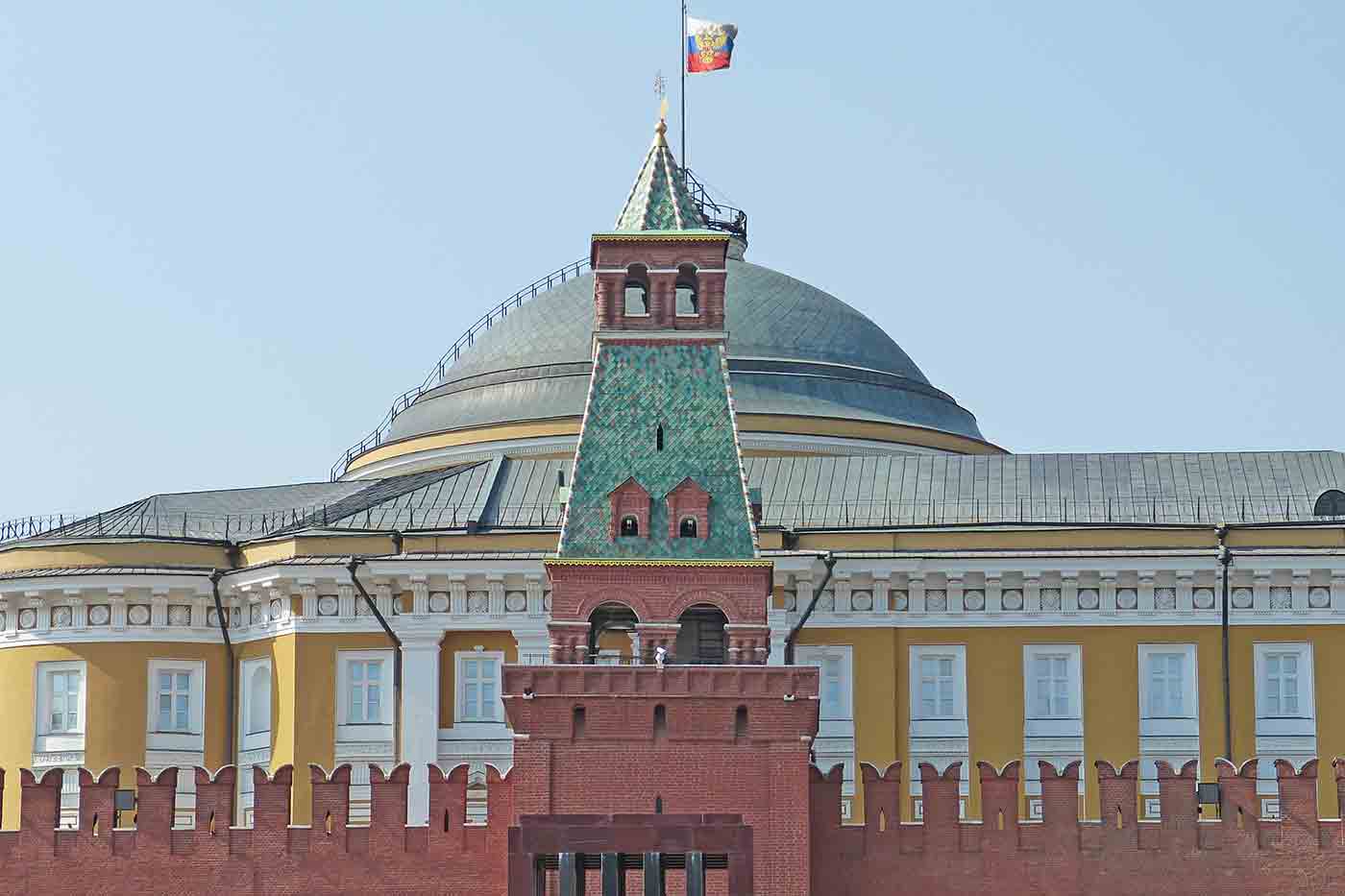
3. GUM Department Store
This is the largest shopping mall in the city and also its most popular. If you are looking for fun things to do in Moscow, Russia then this is the place to go. You can easily spend an hour or so at GUM Department Store.
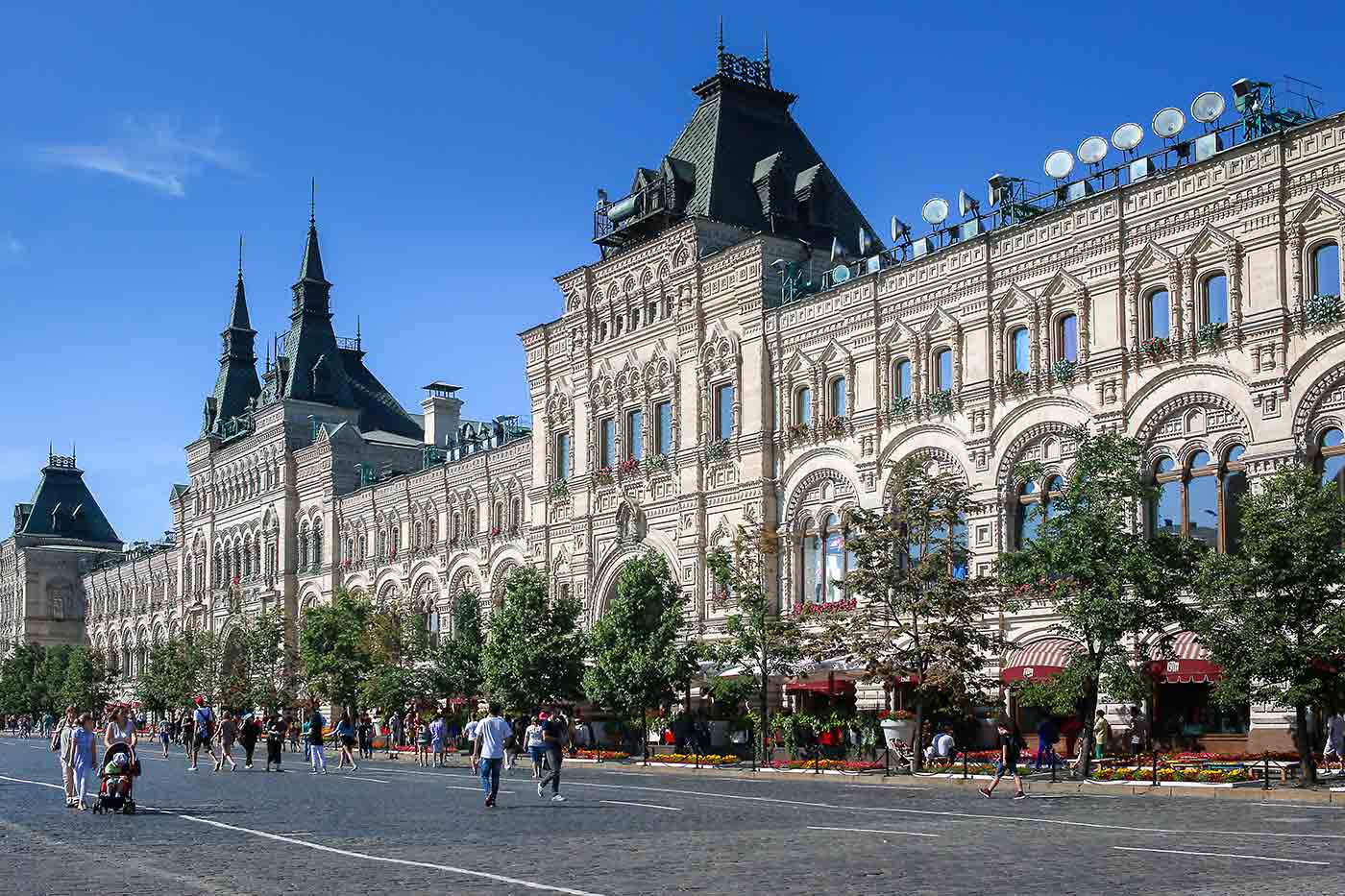
4. State Historical Museum
This museum tells the story of Russia, it is one of the first places you should explore when you visit Moscow. The museum has more than a million artifacts and you would need about 2 hours to explore it.
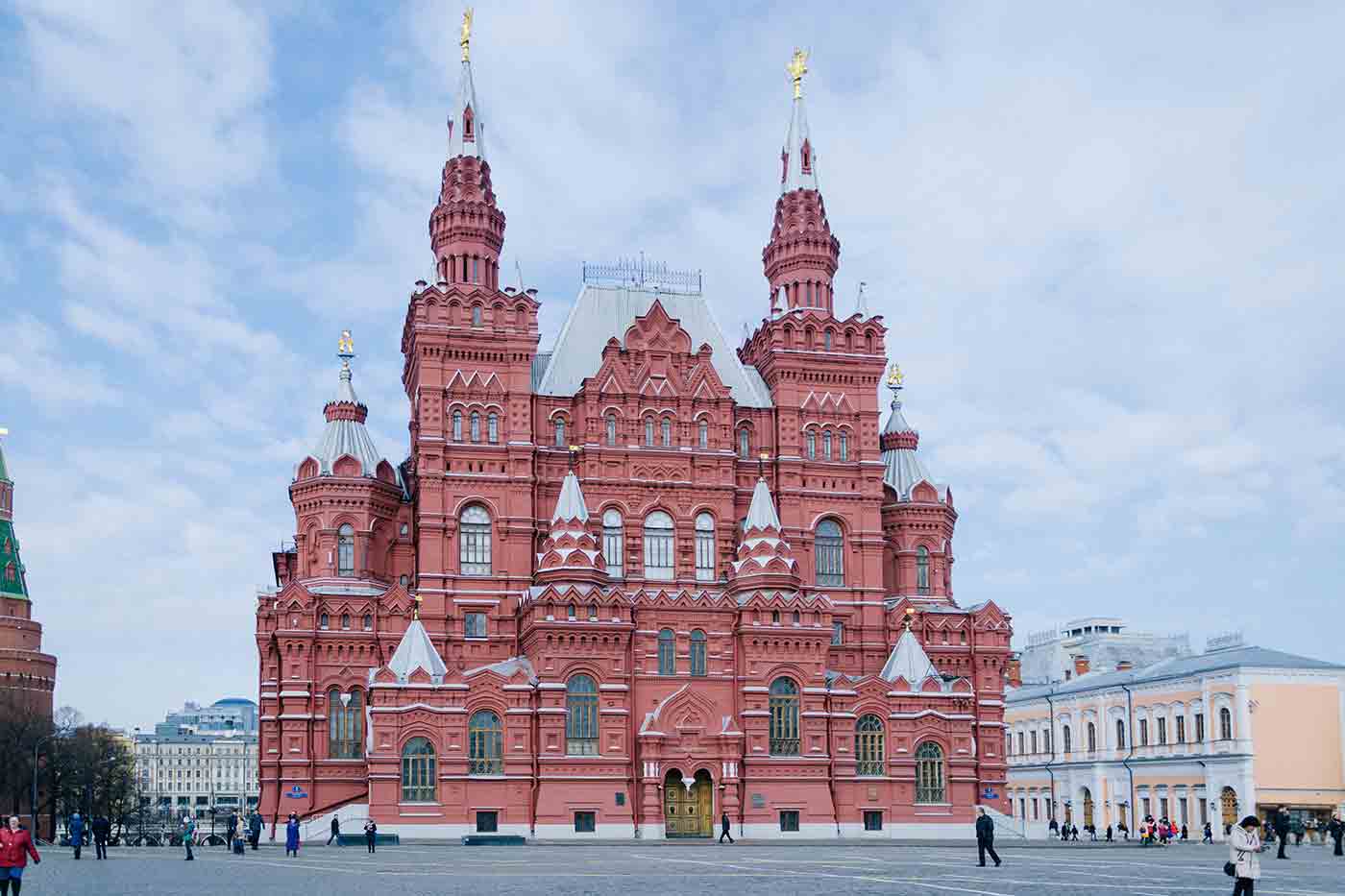
5. Saint Basil’s Cathedral
This cathedral is one of the most beautiful things to see in Moscow. It is an iconic monument which is known around the world. It was built in 1555 and was built under the reign of the very first Czar of India. You will need about an hour to explore this cathedral.
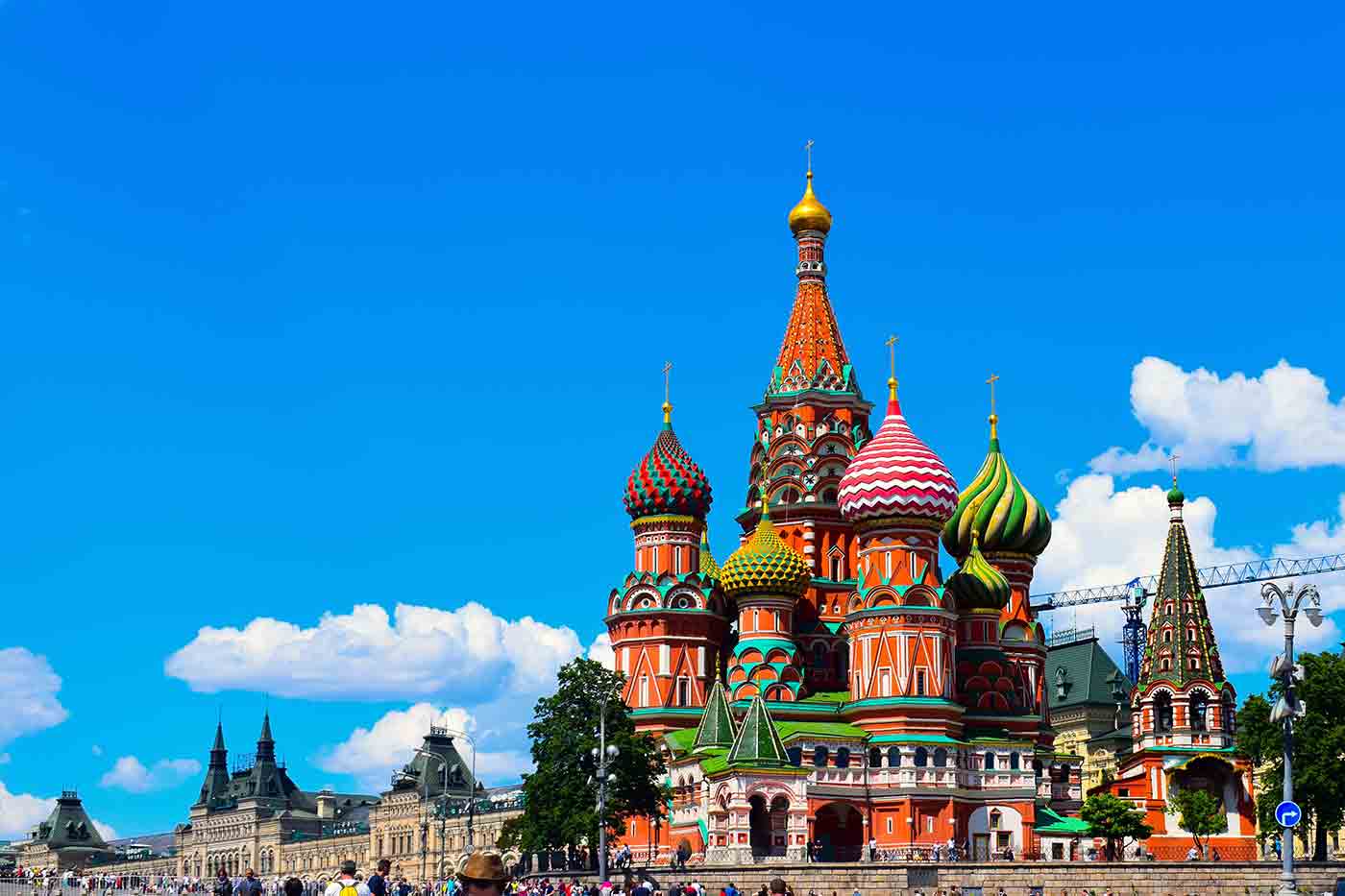
6. The Moscow Kremlin
This is the official residence of the President of Russia. The complex also includes an eponymous museum exhibiting artifacts which goes back 3rd century B.C. You will need an hour to explore Moscow Kremlin museum.
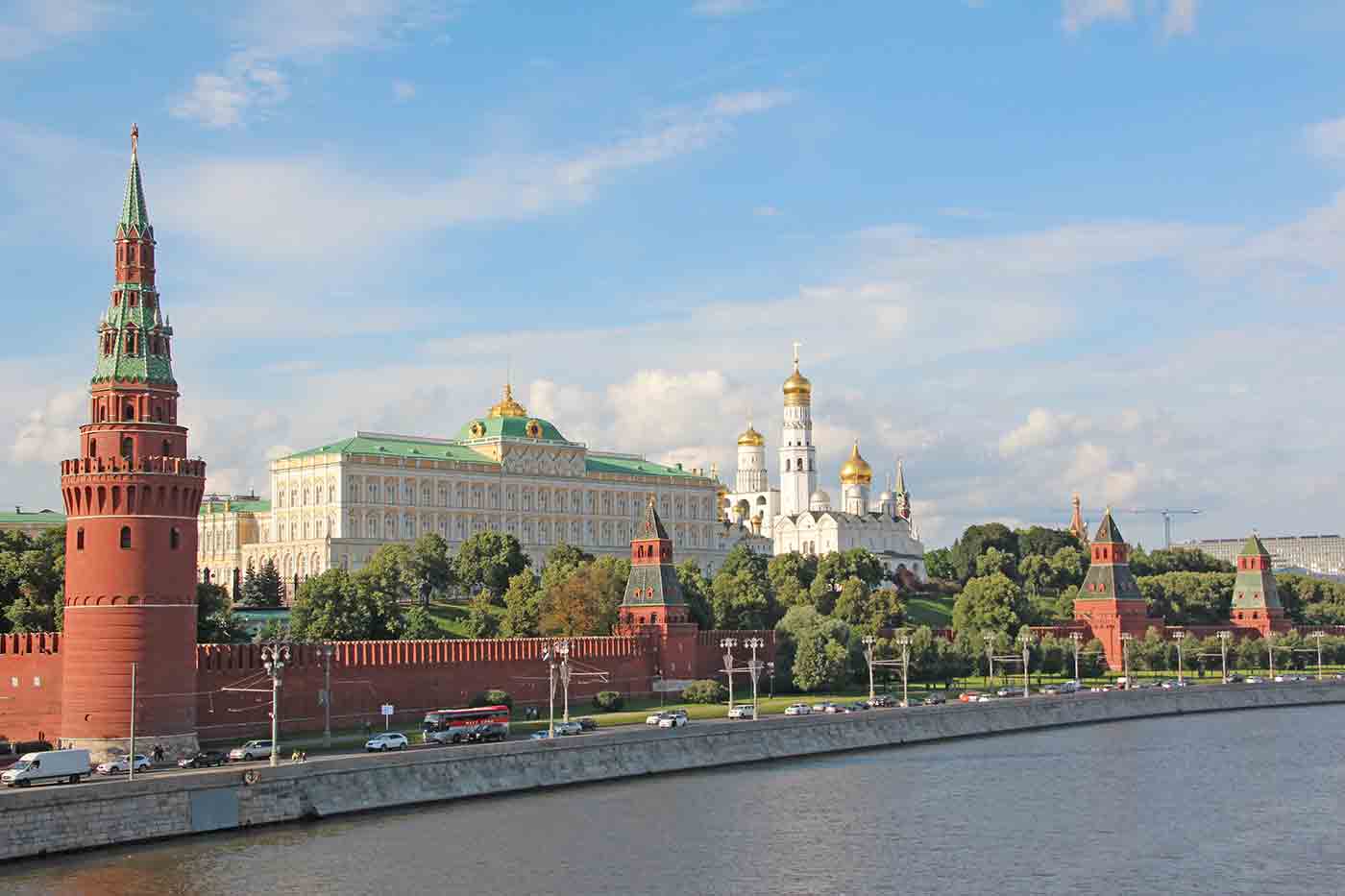
7. Kremlin Armoury
It is one of the most popular places on Moscow itinerary for its collection of exhibits of applied arts from 5th and 20th century. The collection features items from Russian, Western Europe and Eastern. It will take you an hour for this museum.
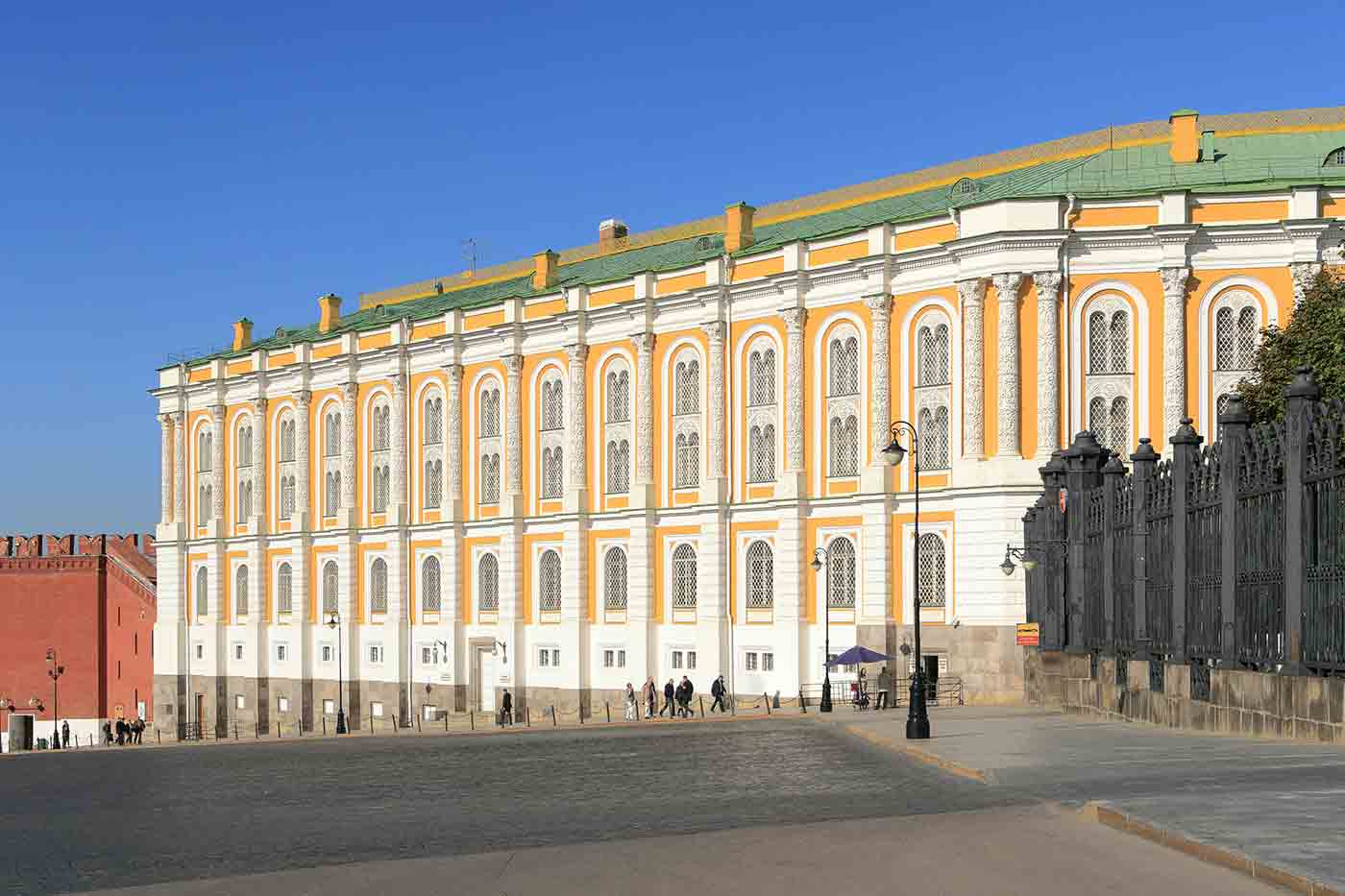
8. Diamond Fund (Almaznyy Fond)
This museum exhibits cut gems, jewelry items and natural gem stones. The museum was established in 1719 by Emperor Peter the Great. You will need about 30 to 45 minutes for this museum.
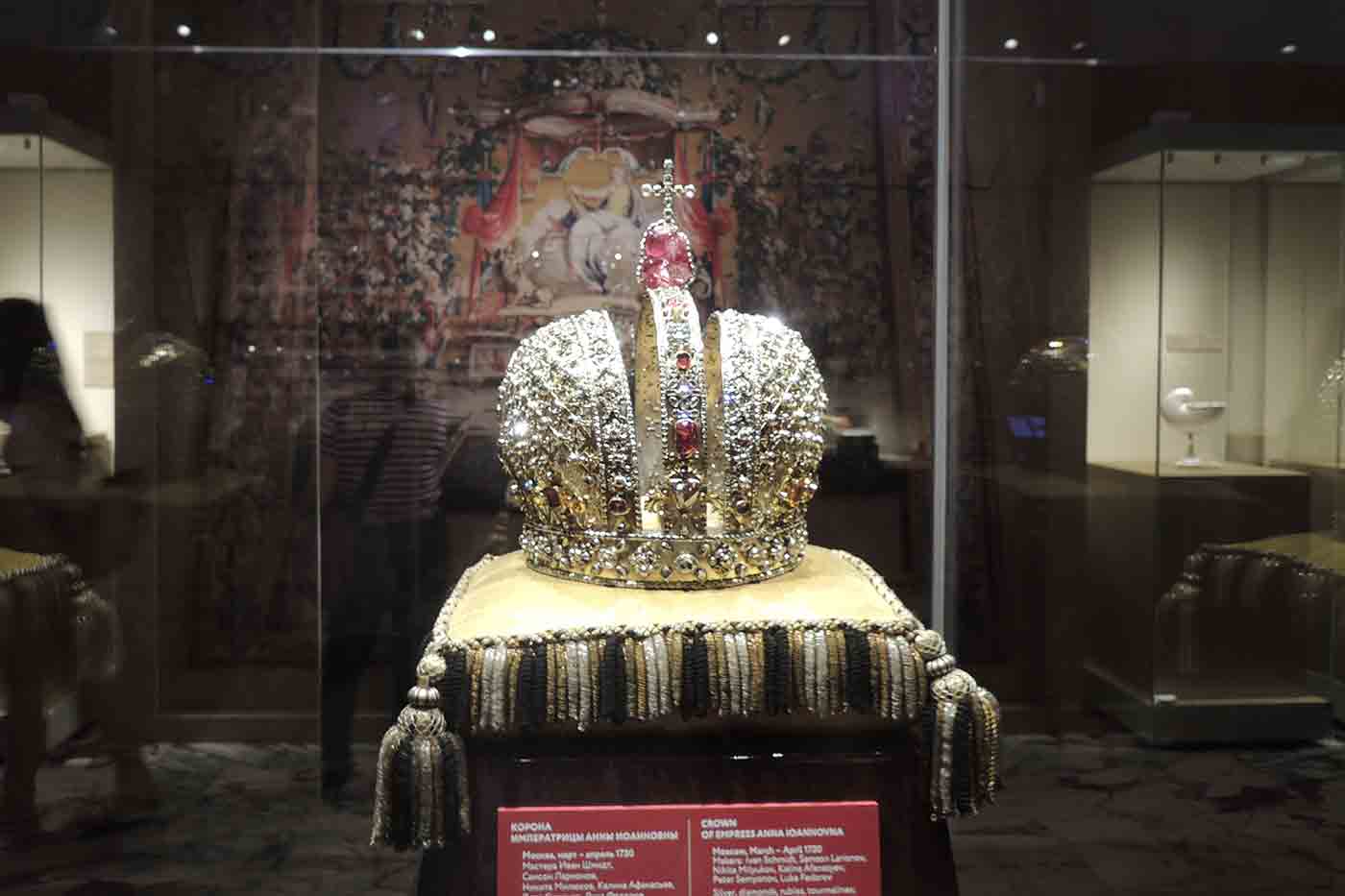
9. Alexander Garden
This park was built in 1812 and was one of the first public parks in the city. It was designed by architect Osip Bove. It is among the most beautiful Moscow tourist places. You will need about 30 to 45 minutes to explore it.
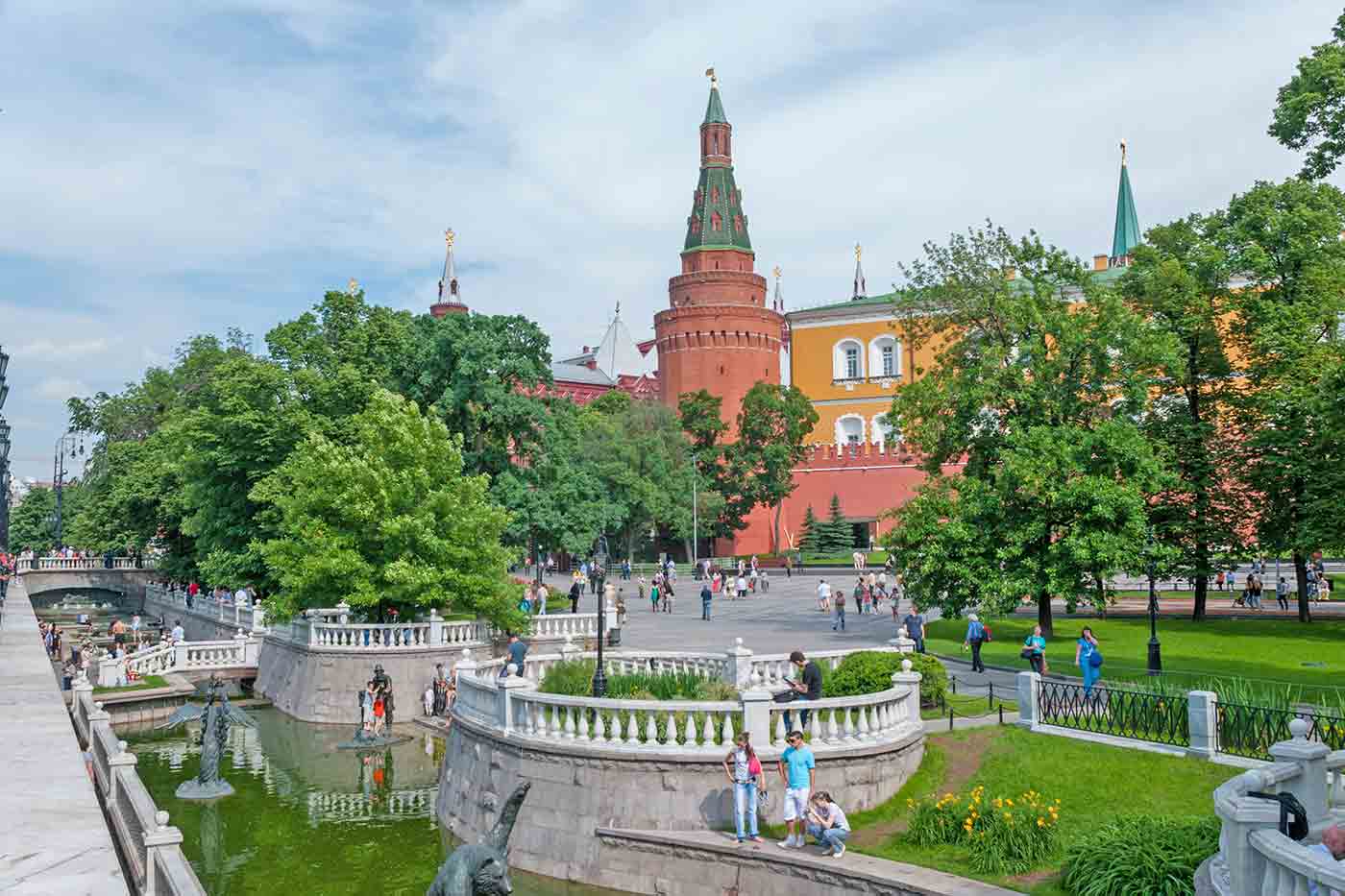
1. Poklonnaya Hill
This is one of the highest point in the city and one of the best places to see in Moscow. The hill is dedicated to Soviet Union’s victory over Nazi Germany. You will need about 2 hours to explore it.
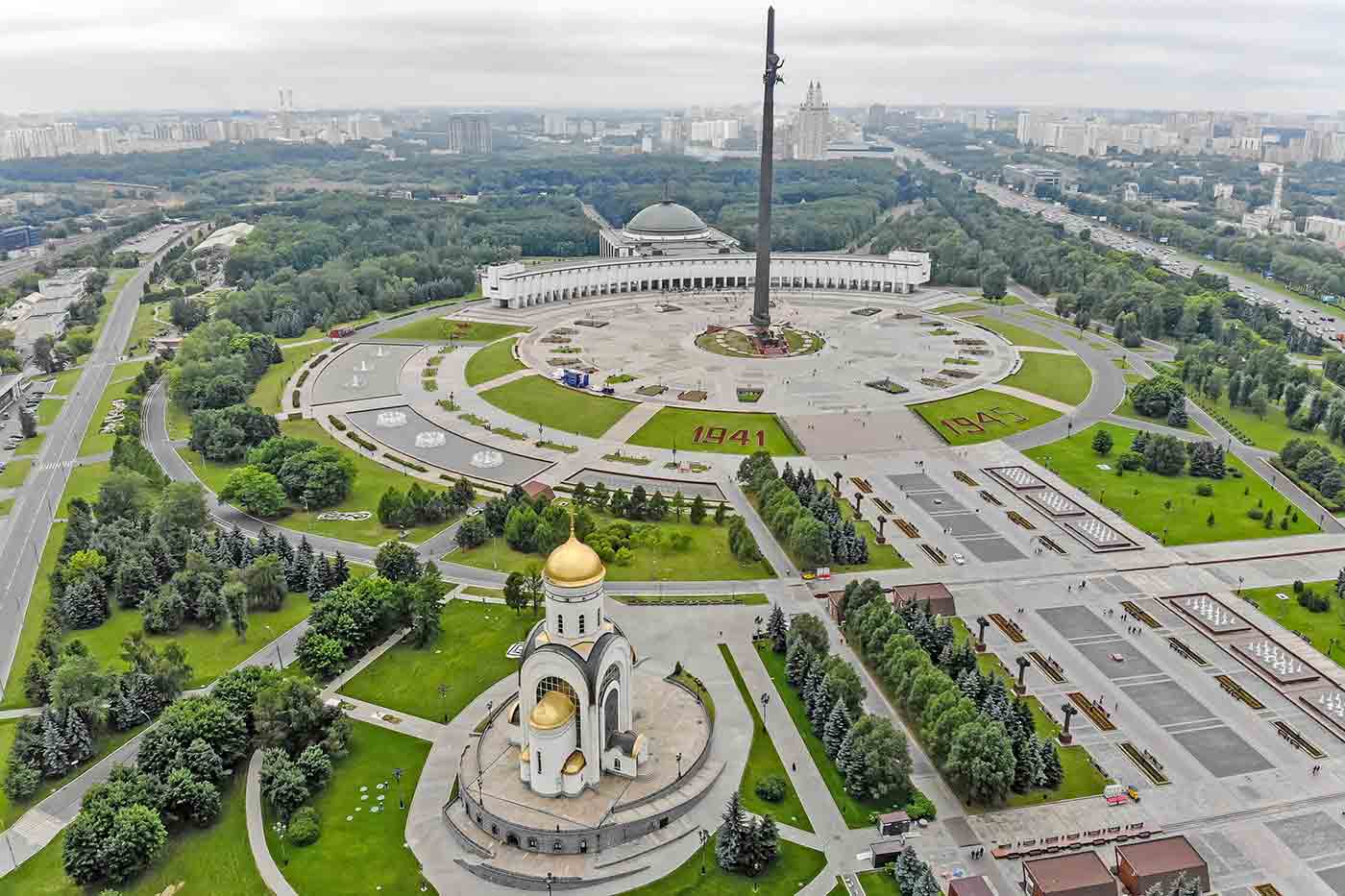
2. Museum of Great Patriotic War
This museum is dedicated to Soviet Union’s contribution to the Second World War. It is one of the most interesting museums to explore during city sightseeing in Moscow. You will need about an hour to explore this museum.
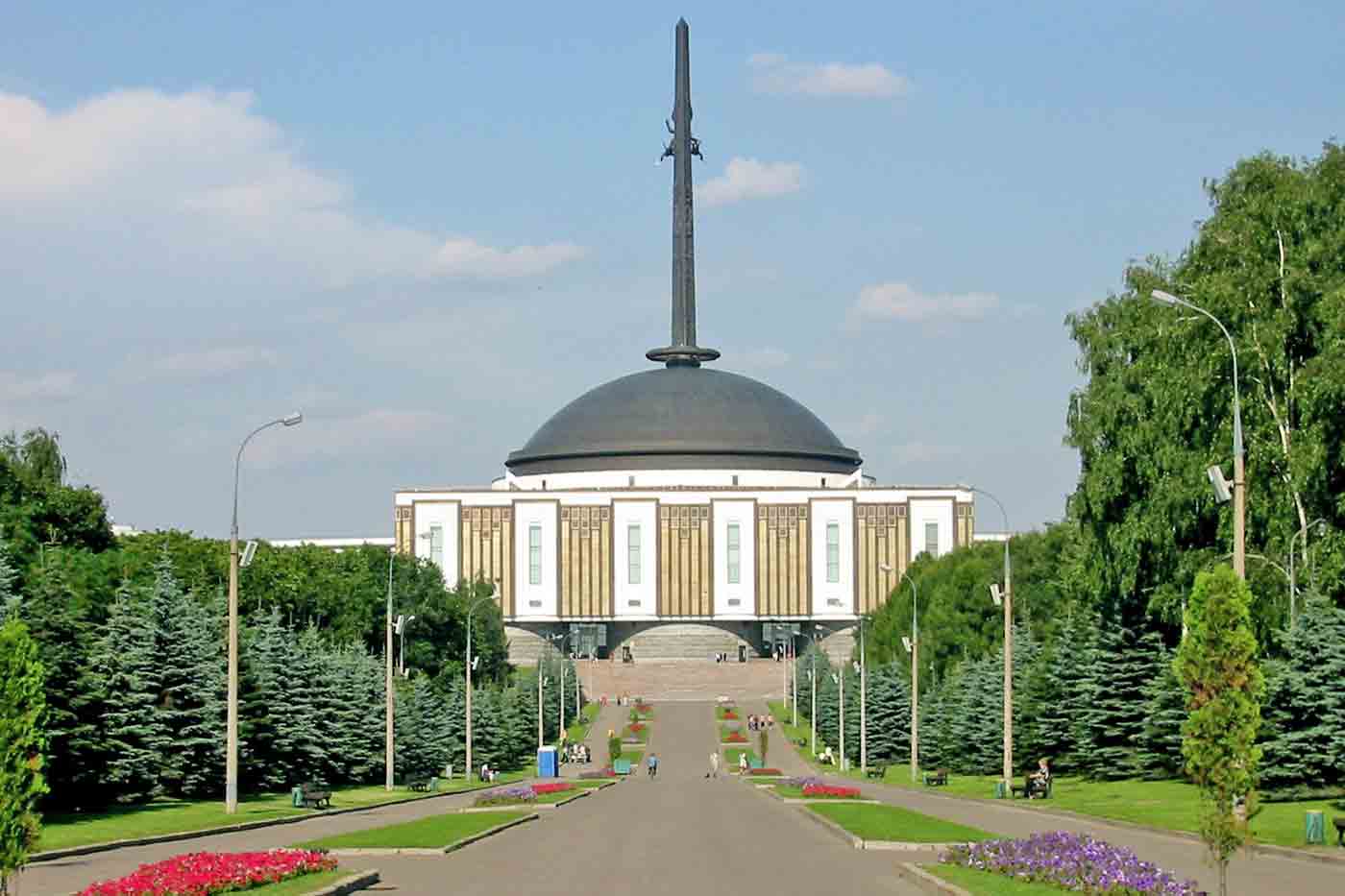
3. Novodevichy Convent
Also known as Bogoroditse Smolensky Monastery, this monastery has history going back to the 17th century. It is among Moscow tourist spots with incredible architecture and design. You will need an hour for this Monastery.
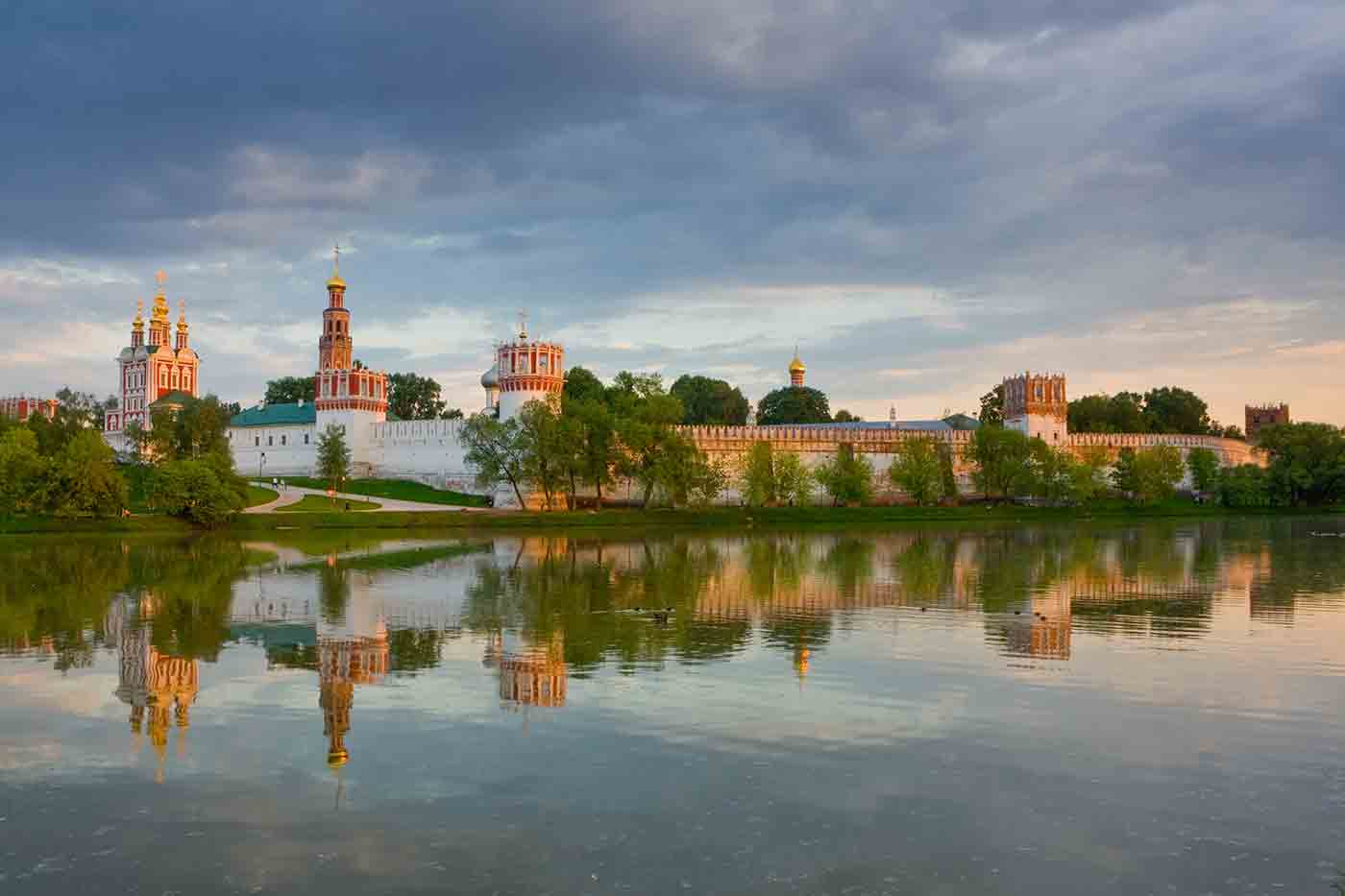
4. Gorky Park
This park is the venue for several activities in Moscow. It is also one of the very first parks established in the city and is named after Maxim Gorky, a prominent writer and political activist. You will need 20 to 30 minutes for this park.
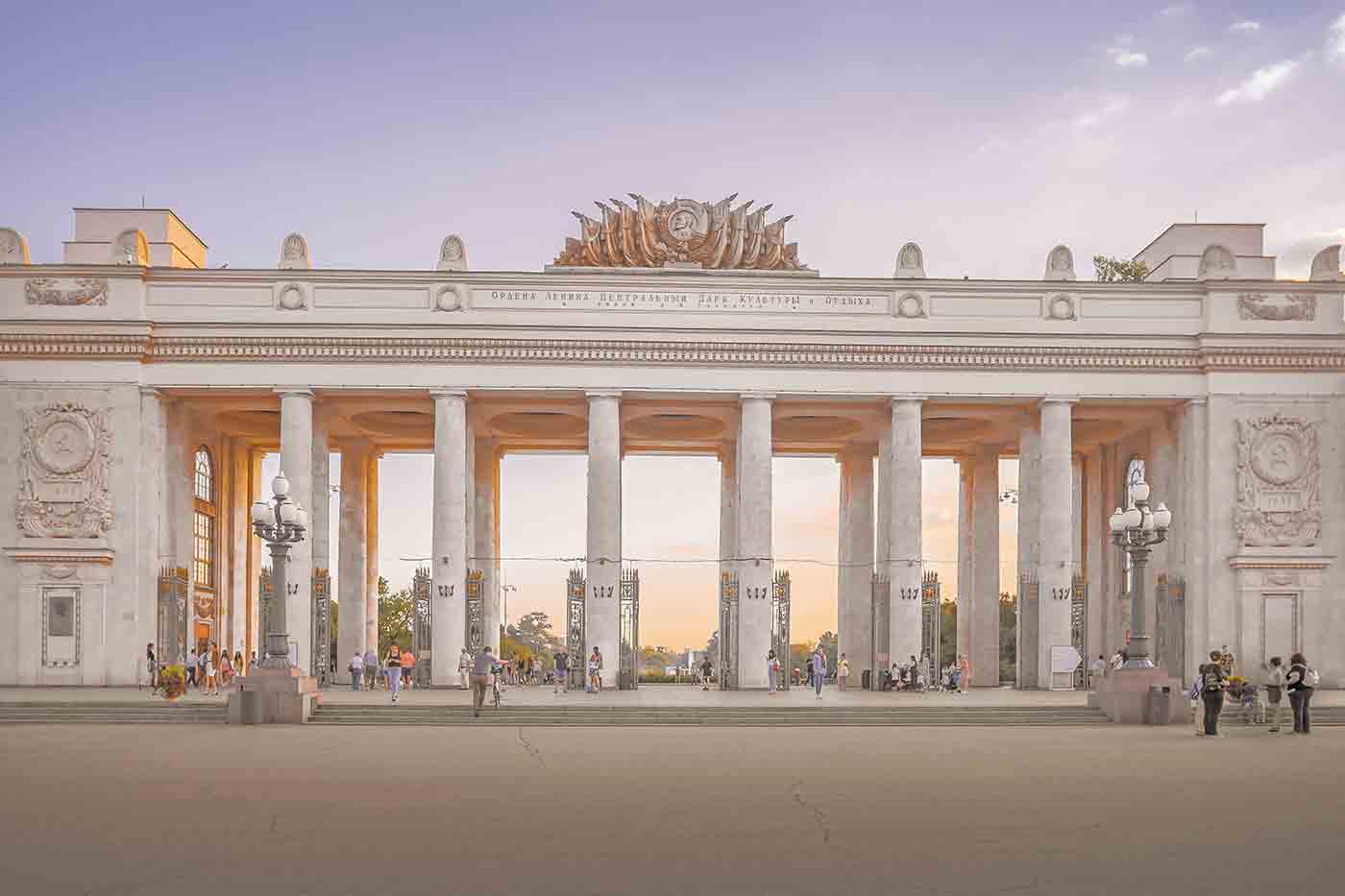
5. Garage Museum of Contemporary Art
This museum is dedicated to modern, abstract and contemporary art. It is among the best places to go in Moscow for those who admire art. You will need about an hour for this art gallery.
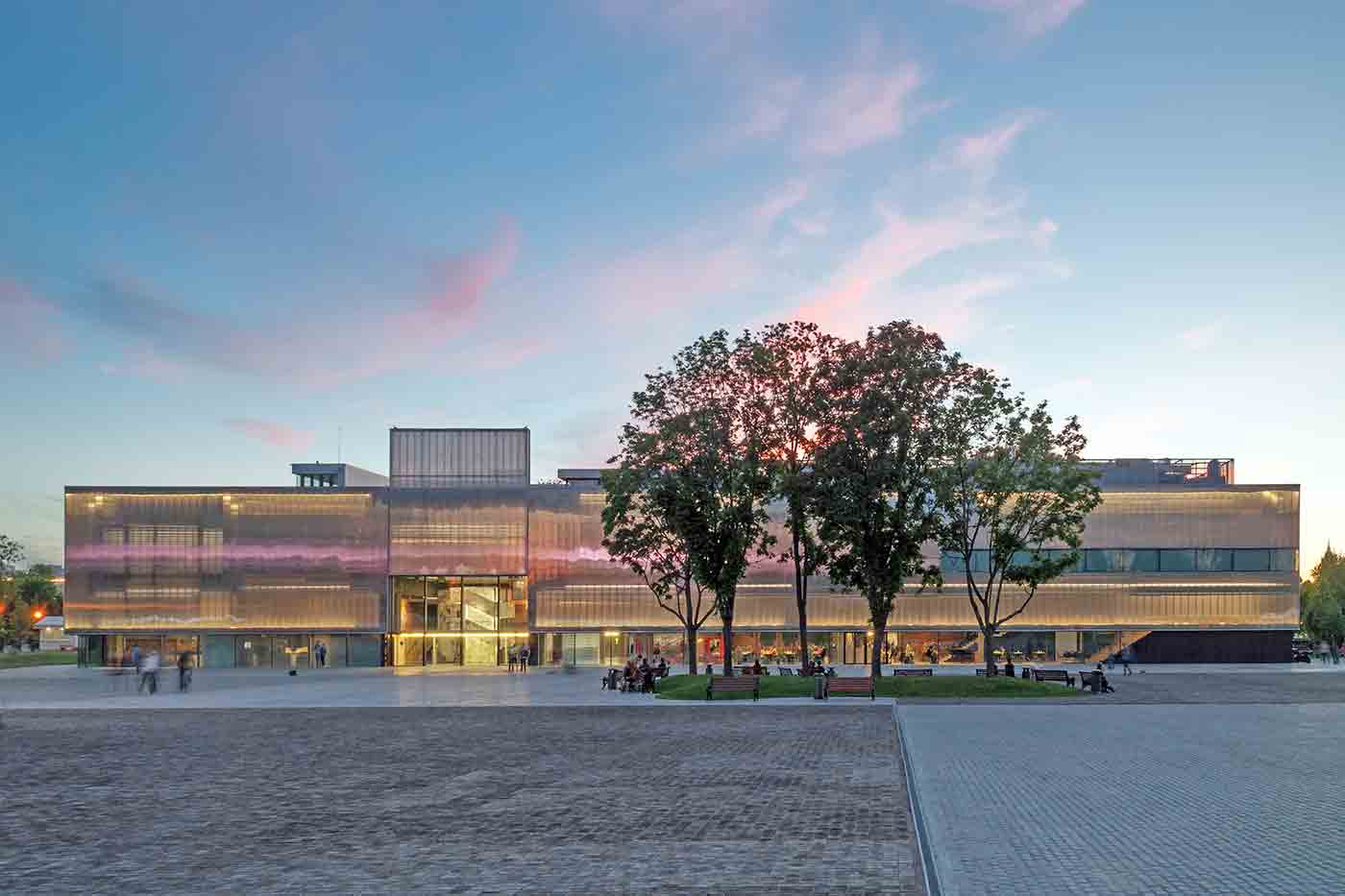
6. Tretyakov Gallery
This gallery is dedicated to works by Russian from 10th to 19th century. You will need about an hour to explore this gallery.
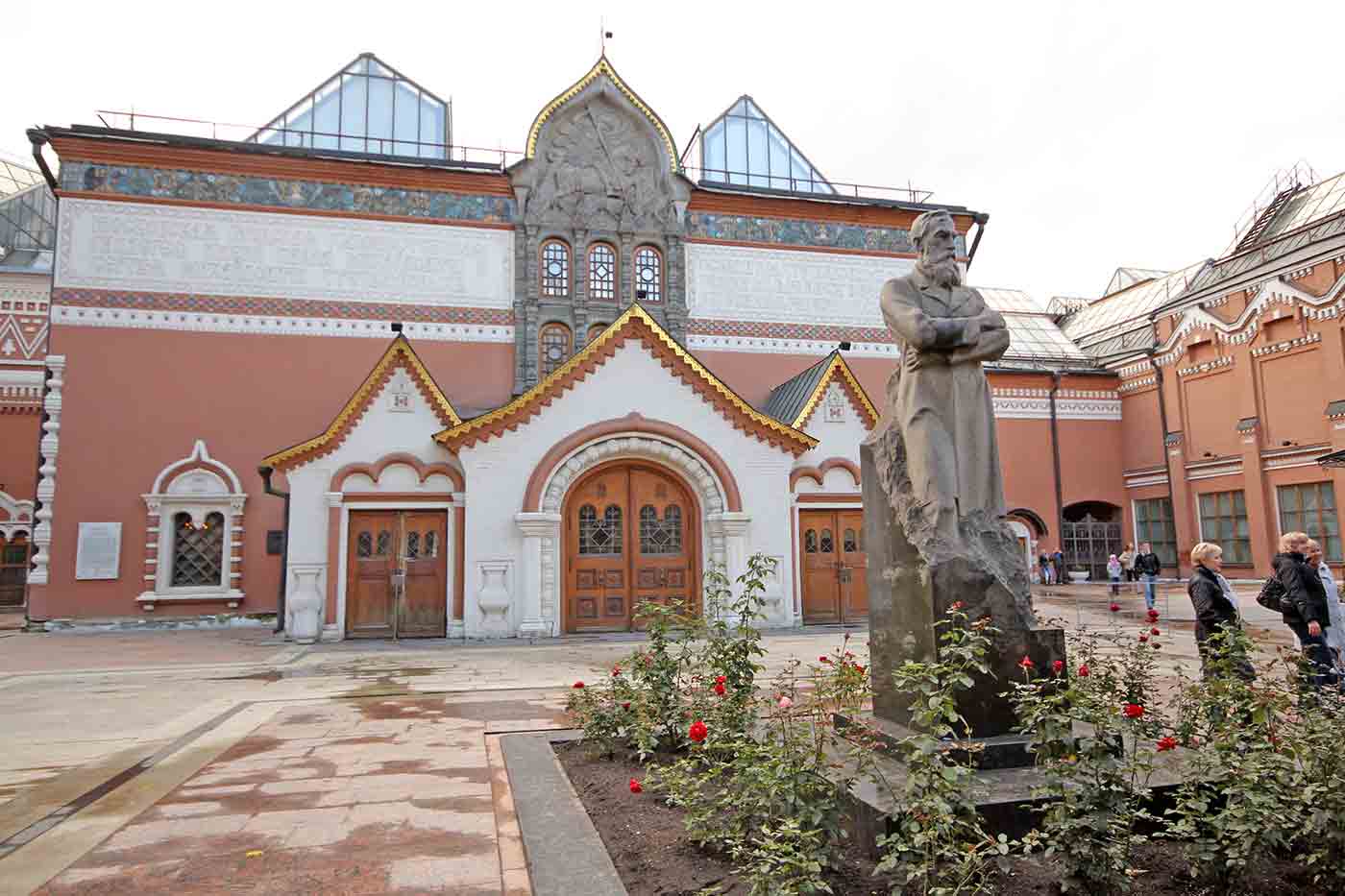
7. Aptekarskiy Ogorod Botanical Garden (Apothecary Garden)
This is the oldest botanical garden in the country. It was founded in 1706 under the reign of Peter the Great. You will need about an hour for these Botanical Gardens.
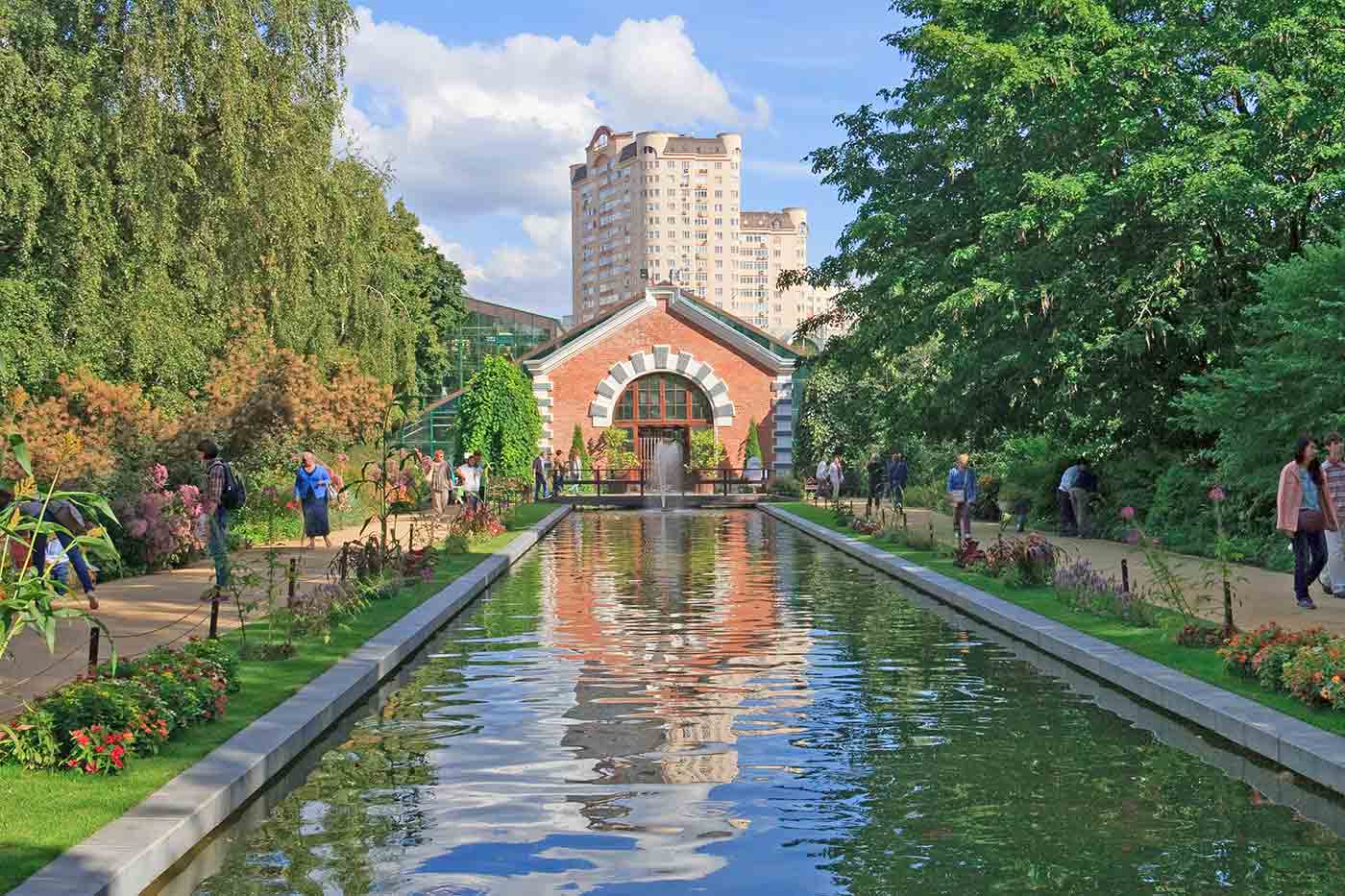
8. Moscow Museum of Modern Art
This museum is dedicated to 20th century paintings, sculptures and graphics. The collection features works by both Russian and foreign artists. It is among top places of interest in Moscow. It will take you an hour to explore this museum.
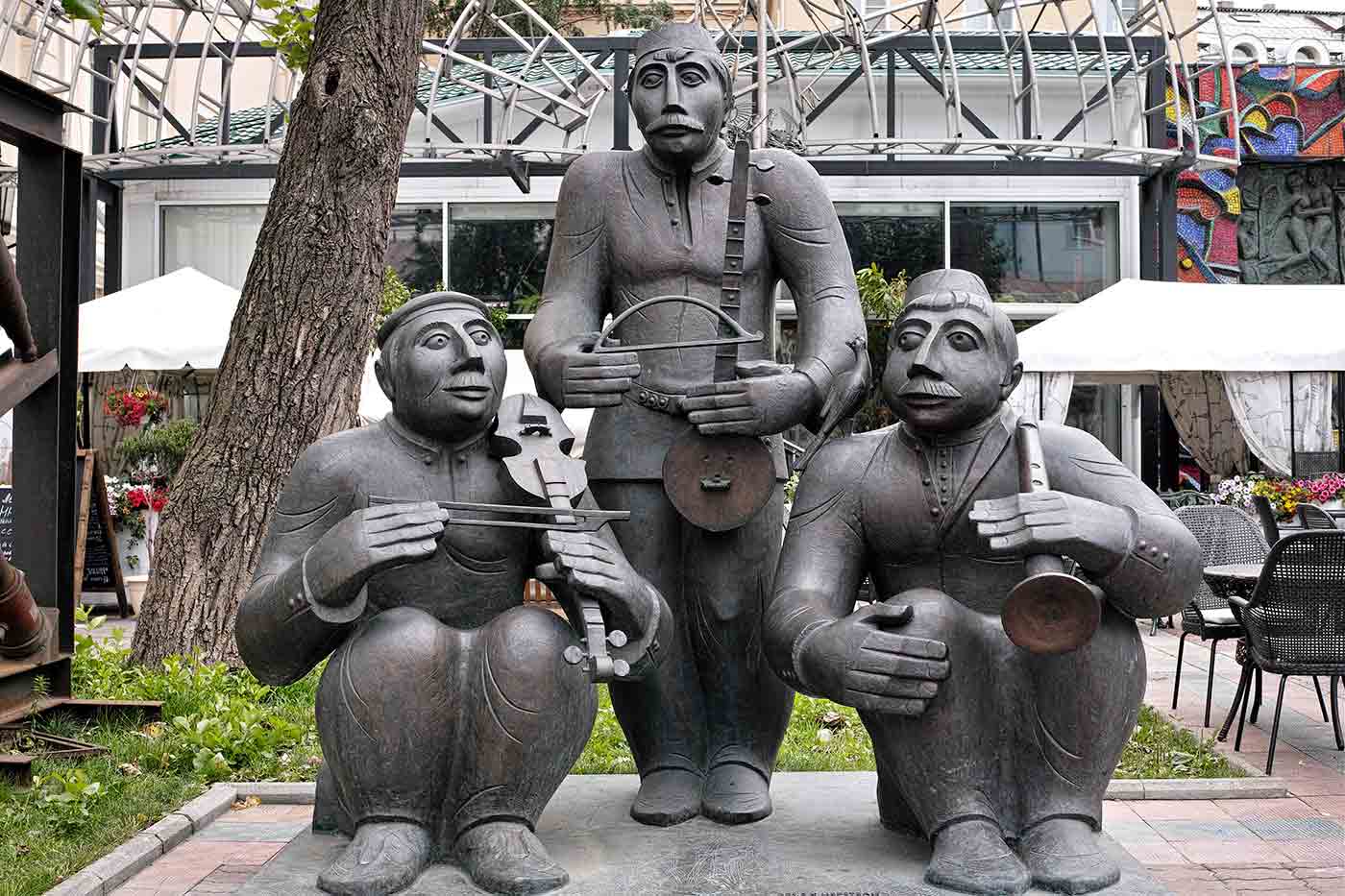
1. VDNkH (Exhibition of Achievements of National Economy)
Also known as Vystavka Dostizheniy Narodnogo Khozyaystva, it is an exhibition venue and an amusement park where people come for fun things to do in Moscow. You would need about an hour for VDNkH.
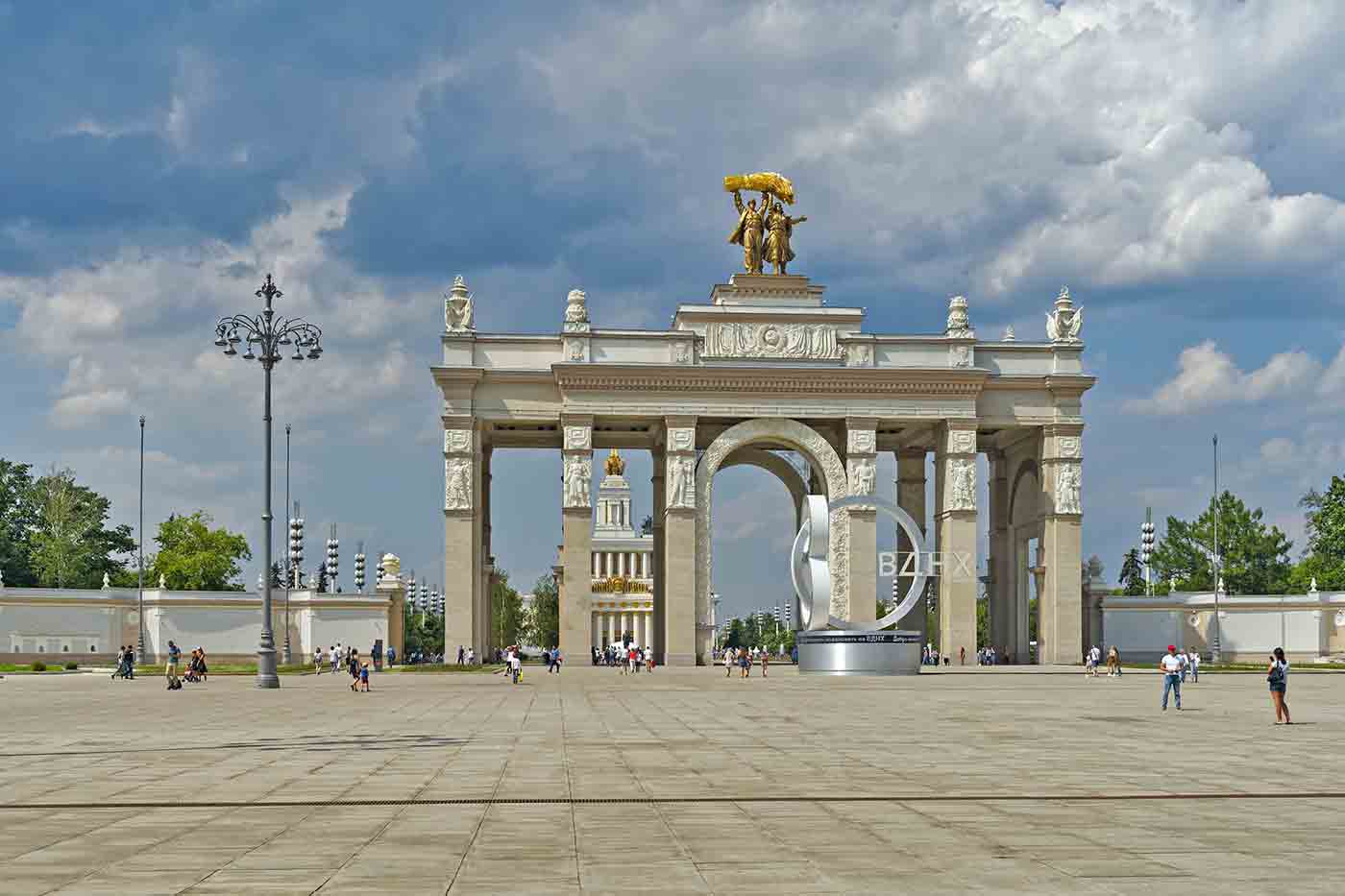
2. Memorial Museum of Cosmonautics
The name of the museum says it all, it is a museum dedicated to Russia’s endeavors in space. If you are a fan of space travel, this museum is a Moscow must see. You will need about 2 hours to explore this museum.

3. Ostankino Television Tower
This Radio and Television tower is the tallest free-standing structure in all of Europe. It is one of the best places for Moscow sightseeing. You will need about hour for this tower.

4. Jewish Museum and Tolerance Center
This is the largest Jewish museum in the entire world. The museum explores the history of Russia with Jews. It is among under appreciated Moscow tourist attractions and will require an hours of your time.

5. Museum of Soviet Arcade Machines
This is among the best places to visit in Moscow for a nostalgia trip. The museum is dedicated to arcade games. It will take you an hour to explore this museum.
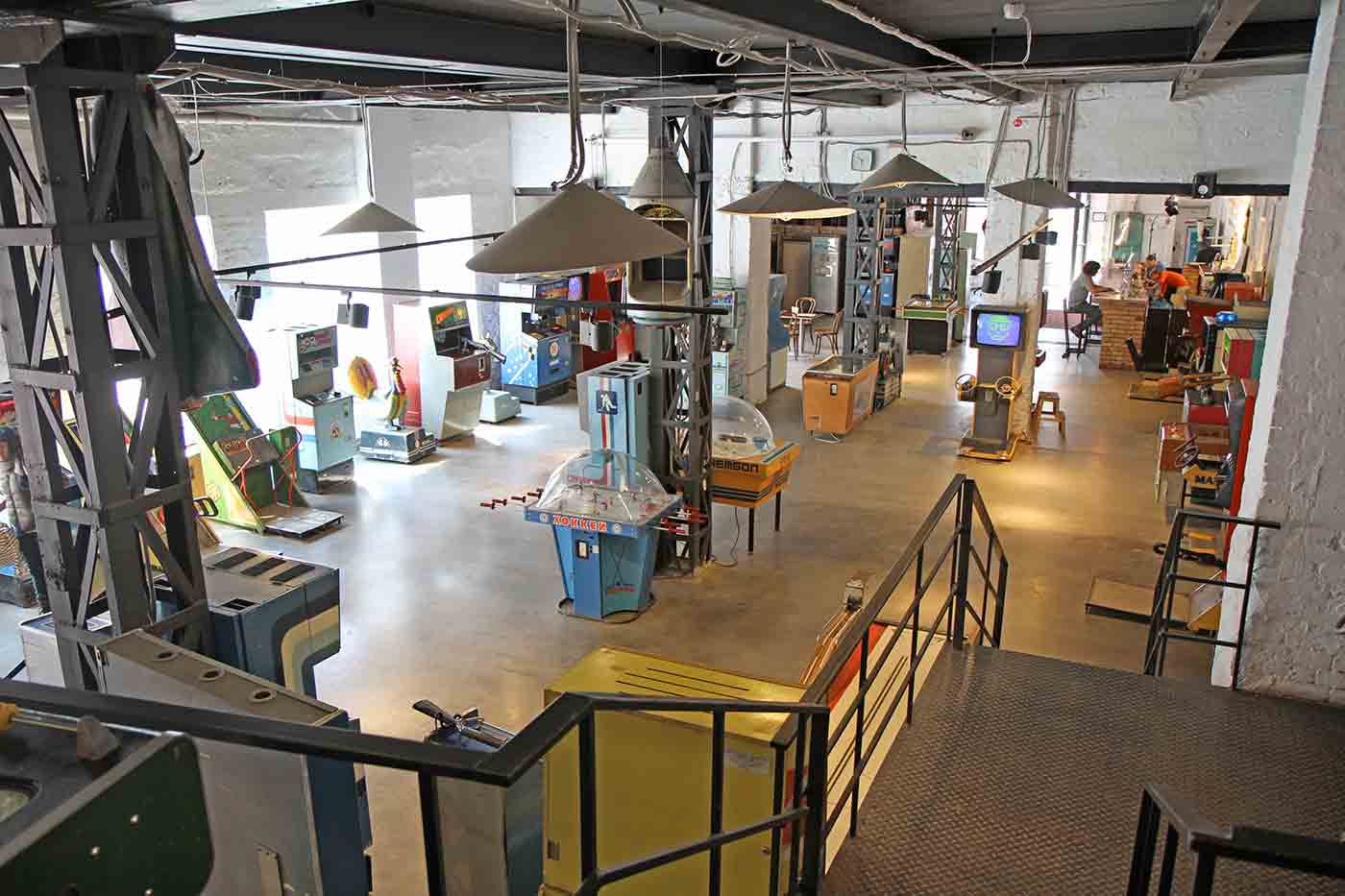
1. Cathedral of Christ the Saviour
This is the tallest orthodox christian church in the entire world. The construction of the monument completed in 1997. In terms of modern architecture, it is among top Moscow beautiful places. You would need 20 to 30 minutes for this church.
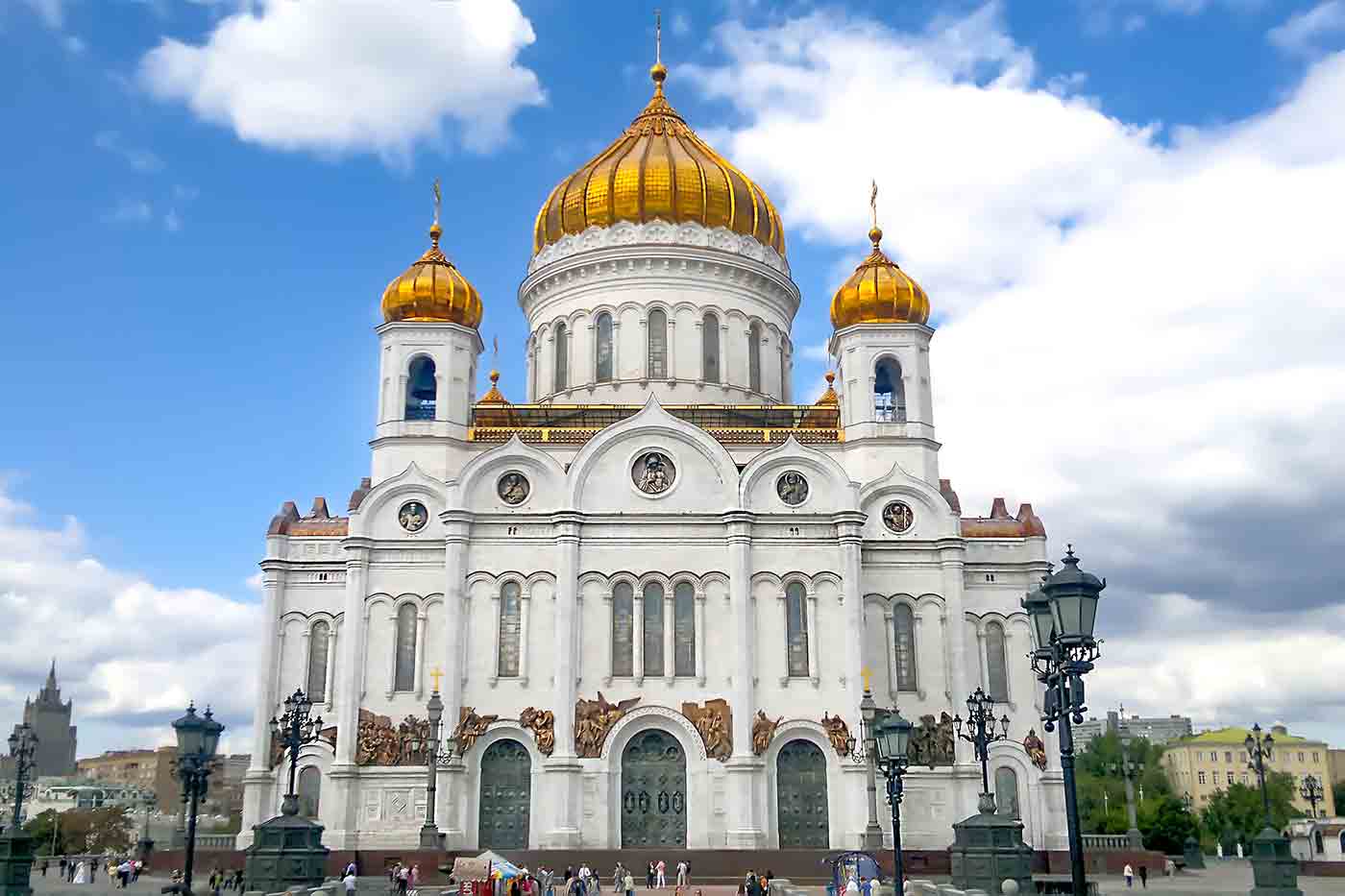
2. The Pushkin State Museum of Fine Arts
This art museum has the largest collection of European Art in Russia. It is named after Russian port Alexander Pushkin. You will need an hour for this Moscow attraction.
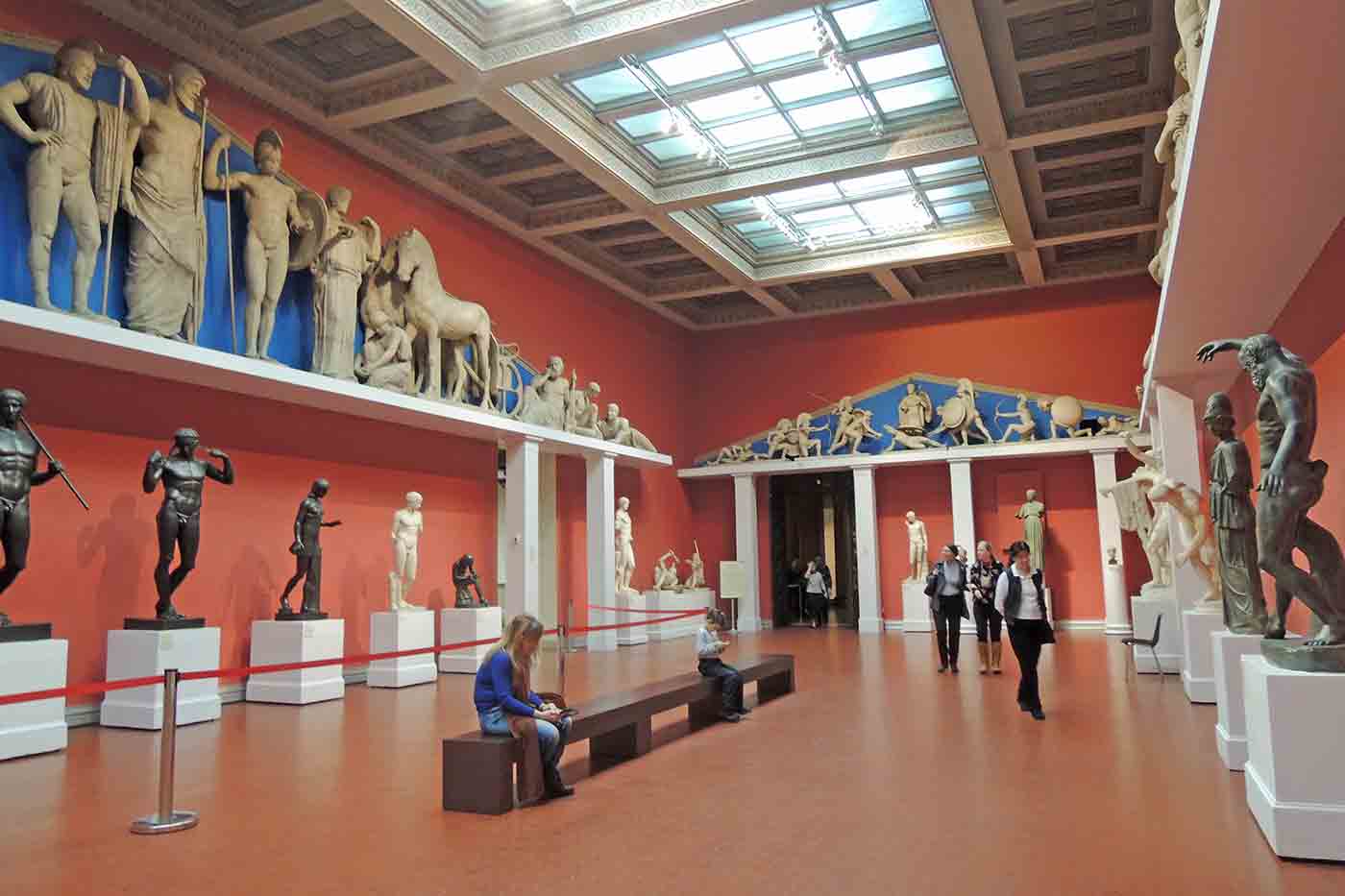
3. Moscow Planetarium
This one is for space enthusiasts to enjoy during Moscow travel. The museum is full of great exhibits concerning the cosmos and interactive exhibits. You will need about an hour for this planetarium.
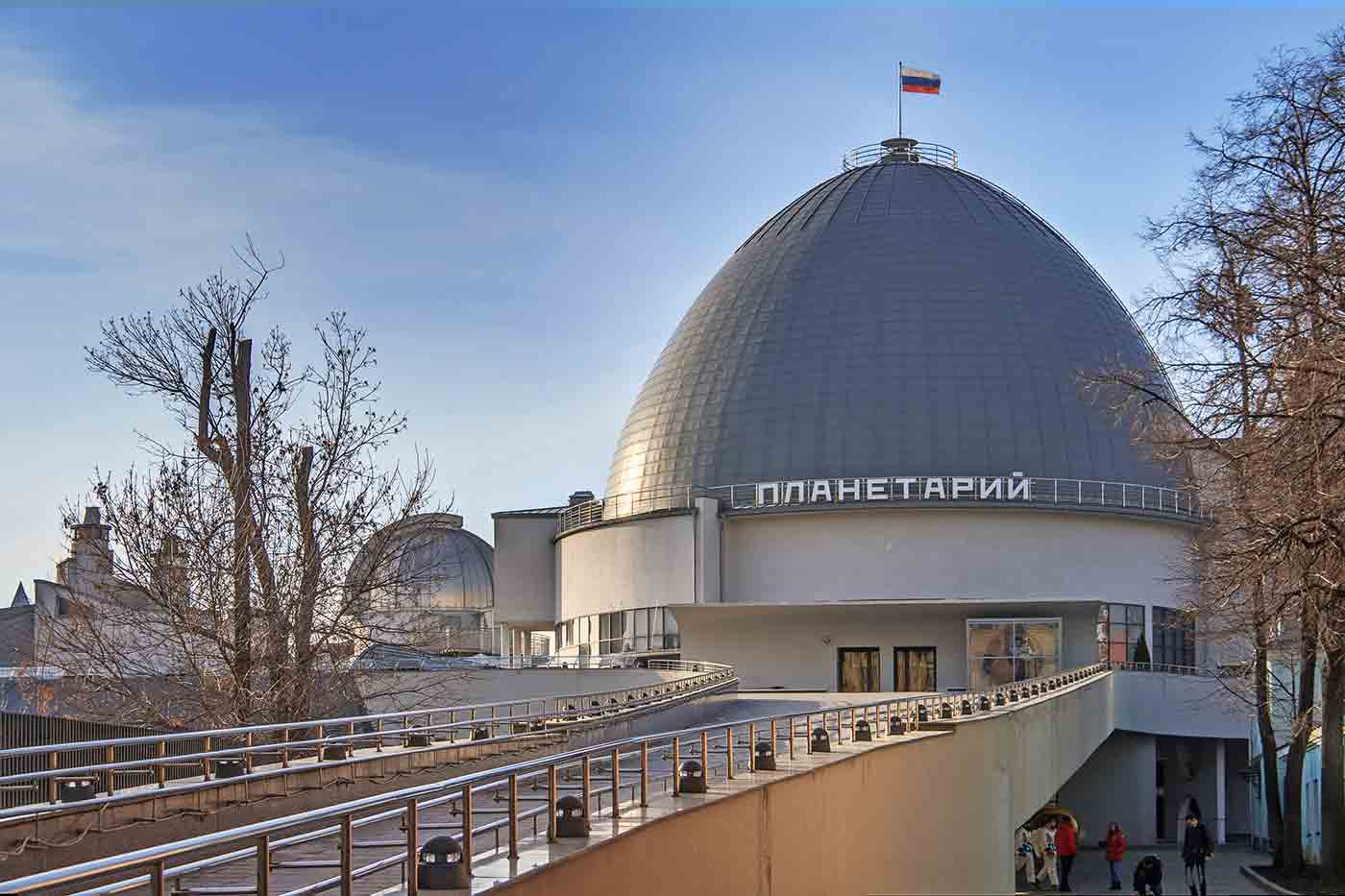
4. Moscow Zoo
This is the largest zoo in the country with around 1,000 species of animals residing here. It is among best things to do in Moscow for families. It will take you 2 hours to explore it.
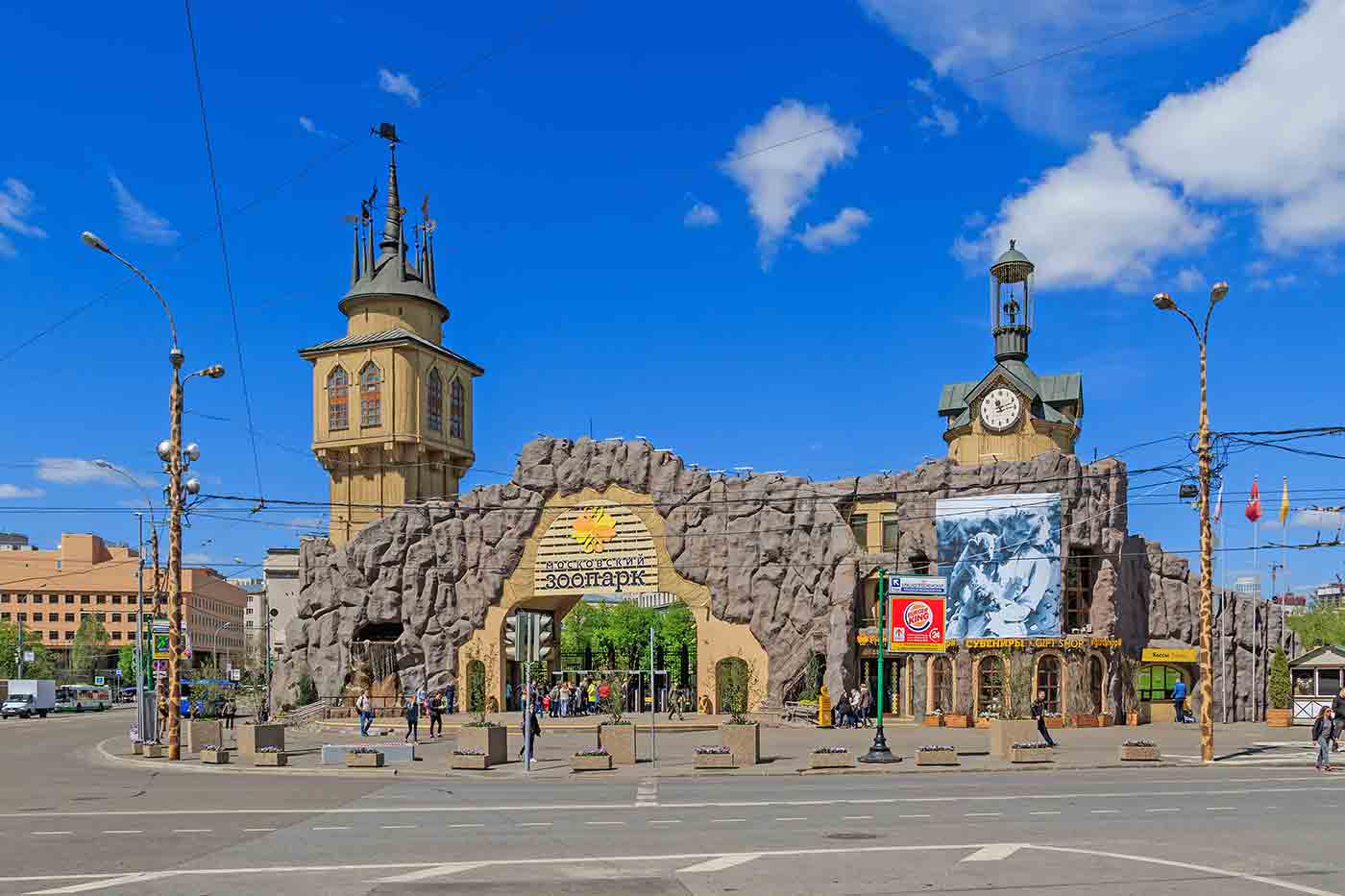
5. Mikhail Bulgakov Museum
This museum used to be the house of revered Russian writer Mikhail Afanasyevich Bulgakov. It depicts the life and work of this great writer. You would need 20 to 30 minutes for this house museum when you visit Moscow.
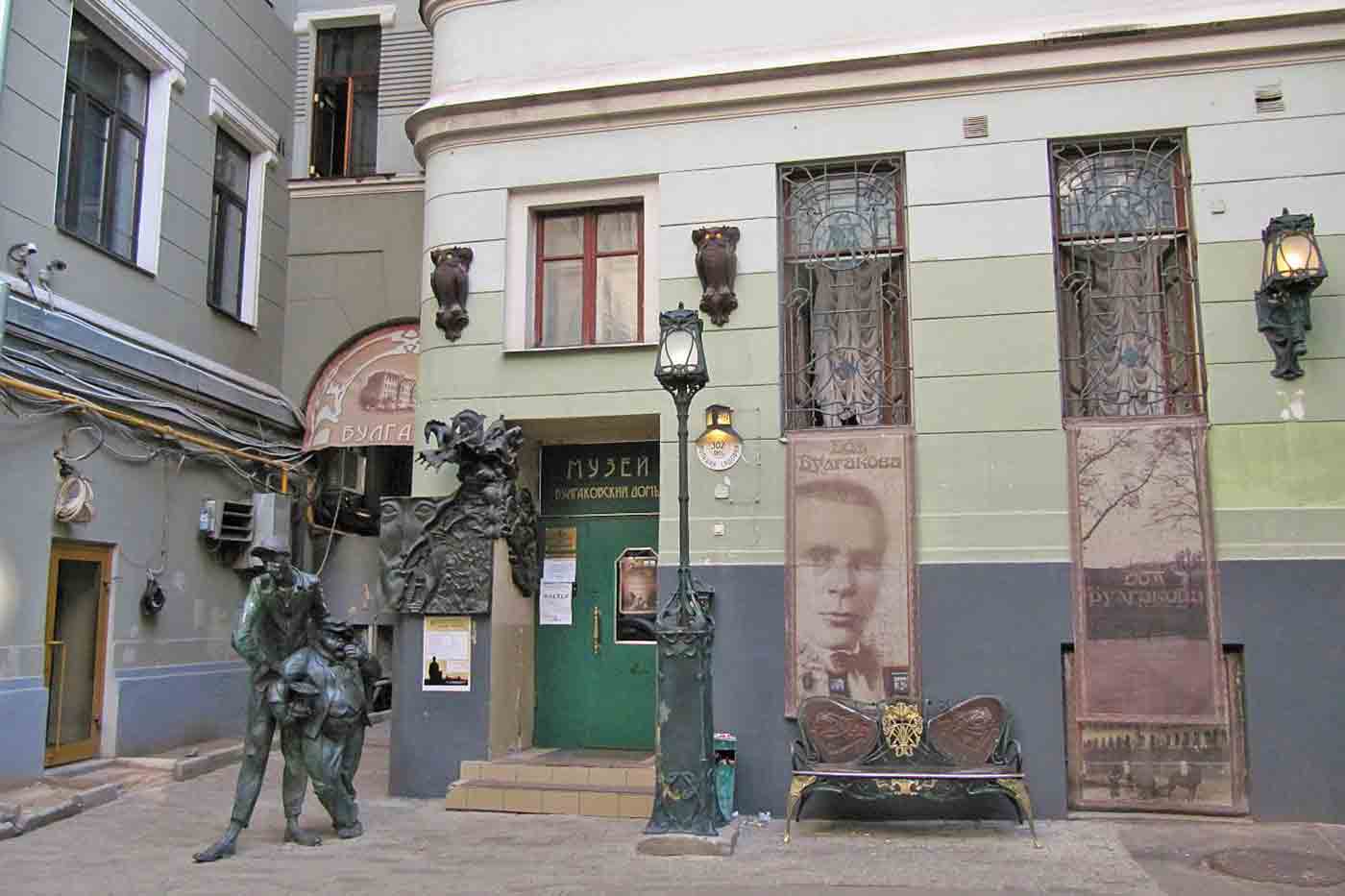
If you are looking for more top things to do in Moscow, check out the section below.
Things to do in moscow, monuments, museums & historical places to visit in moscow.
- St. Basil’s Cathedral
- The Moscow Kremlin
- Bolshoi Theatre
- The State Tretyakov Gallery
- The Pushkin State Museum of Fine Arts
- Gorky Central Park of Culture and Leisure
- Cathedral of Christ the Saviour
- Lenin’s Mausoleum
- State Historical Museum
- The Garage Museum of Contemporary Art
- Novodevichy Convent
- Kolomenskoye
- Museum of Cosmonautics
- Tsaritsyno Museum
- Moscow Museum of Modern Art
- Dormition Cathedral
- Armoury Chamber
- Multimedia Art Museum
- Grand Kremlin Palace
- Monument to Peter I
- Kuskovo Estate Museum
- Izmailovo Kremlin
- Muzeon Park of Arts
- Victory Museum
- Darwin Museum
- Jewish Museum and Tolerance Center
- New Tretyakov Gallery
- Ivan the Great Bell Tower
- Annunciation Cathedral
- Russian Impressionism Museum
- Gulag History Museum
- Museum Estate Arkhangelskoye
- Cathedral of Archangel
- Novodevichy Cemetery
- The State Museum of Oriental Art
- Amalaznyy Fond
- Spasskaya Bashnya Clock Tower
- Worker and Kolkhoz Statue
- Dvorets Tsarya Alekseya Mikhaylovicha Palace
- Kazan Cathedral
- National Center for Contemporary Art
- Polytechnical Museum
- The Moscow Planetarium
- State Pushkin Museum
- Schusev State Museum of Architecture
- Church of Ascension
- Battle of Borodino Museum
- Paleontologicheskiy Museum
- Central Armed Forces Museum
- Space Conqeurors Monument
- State Museum of Konstantin and Victor
- Moscow Cathedral Mosque
- Novospassky Monastery
- Donskoy Monastery
- Museum of Decorative Applied and Folk Arts
- Bakhrushin Theatre Museum
- State Museum of Modern Russian History
- The Museum of Moscow
- Izmaylovo Estate
- GES-2 Art Museum
- Tsar Cannon
- Gary Tatinsian Gallery
- Museum of Moscow
- Nouvelle Gallery Tretiakov
- Lumiere Brothers Center for Photography
- Museum of Soviet Arcade Games
- Tomb of the Unknown Soldier
- Tsentral’nyy Drevnerusskoy Kul’tury Museum
- Pushkin Monument
Nature & Wildlife Tourist Spots in Moscow
- Izmailovsky Park
- National Park Elk Island
- Serebryany Bor
- Shkolnoye Lake
- Beloye Lake
- Sokolniki Park
Entertainment & Leisure Tourist Spots in Moscow
- All Russian Exhibition Center
- Alexander Gardens
- Park Pobedy na Poklonnoy Gore
- Apothecary Garden
- Dream Island Amusement Park
- Neskuchuny Garden
- Park Izmaylovo
- Hermitage Garden
- Moscow Manege
- Sanduny Bathhouse
- Botanical Garden of the Russian Academy
Shopping in Moscow
- Arbat Street
- Stoleshnikov Lane
- Flacon Design Center
- TsUm Shopping Area
- Tverskaya Street
- Kitai Gorod Shopping District
- Okhotny Ryad Shopping Centre
- Izmailovo Market
- GUM Shopping Arcade
Beaches in Moscow
- Troparyovo Beach
- Levoberezhny Beach
- Meshcherskaya Recreation Area
- Rublyovo Beach
- Chyornoye Ozero
- Bolshoi Goroskoi Prud
Offbeat Places, Tours, & Adventure in Moscow
- Moscow River Cruise
- Ice Skating
Sightseeing in Moscow
- Ostankino Tower
- Tverskaya Tower
- Sparrow Hills
- Poklonnaya Hill
- Mercury City Tower
- Garden Ring
- Shukhov Tower
Food, Dining, Restaurants, & Street Food in Moscow
- Cafe Pushkin
- Lucky Izakaya Bar
- Zotman Pizza Pie
- Buba by Samosan
- Masters & Margaritas
- Simple Things
- White Rabbit
- Grand Cafe Dr. Zhivago
How to Reach Moscow?
There are 4 airports for Moscow travel namely Sheremetyevo International Airport, Domodedovo International Airport, Vnukovo International Airport, and Zhukovsky International Airport. Between these 4 airports, you can get direct flights from several major cities in Asia, Africa, Europe, Australia and North America. You have the option of bus and cabs to get around to places to visit in Moscow.
You get trains from several cities in Russia and Europe to visit Moscow including St. Petersburg, Berlin , Warsaw , Helsinki , Monaco, Paris , Ukraine, Tallinn , Riga , Brest, Belarus, Frankfurt , Vienna , Budapest and many more. There are frequent buses between Moscow connected with several cities in Europe.
If you plan to travel by road, there are so many major highways connecting to the city. There is basically a web of roads connecting to Moscow from all directions.
There are no passenger routes for Moscow travel. There are commercial ships traveling by Moscow canal through Baltic Sea.
Mustafa Natalwala
Mustafa is a content writer and digital marketing expert at WideWorldTrips.com His mainly interests are into travelling, photography, film-making
2 thoughts on “ 27 Tourist Places to Visit and Things to Do in Moscow in 4 Days Trip ”
Why Sokolniki park is missing? Or doesn’t it exist as before ? I used to roam inside it over fifty years ago ! May be now the forest has been consumed by the concrete edifices?
Thank you for updating us about this amazing place in Moscow. We have updated the article and included it in the Nature section of the article. But, as we have prepared the itinerary of palces based on popularity, we have not included Sokolniki Park in that section. You can find it by scrolling down to the Nature section. Thank You once again for helping us update our article.
Comments are closed.
- Share full article
Advertisement
Supported by
Namibia, Facing Drought, Plans to Kill Elephants for Meat
The Southern African country plans to butcher over 700 wild animals, including 83 elephants and 300 zebras, to feed people and, it hopes, cut down on dangerous cross-species encounters.

By Amelia Nierenberg
Reporting from London
The Southern African nation of Namibia is planning to butcher hundreds of its most majestic animals to feed some of the 1.4 million people — nearly half the country — who are in a hunger crisis amid the worst drought in a century.
The plan, under which the country will kill 723 wild animals, including 83 elephants, to feed people, is “necessary” and “in line with our constitutional mandate where our natural resources are used for the benefit of Namibian citizens,” the country’s ministry of environment, forestry and tourism said in a news release .
This strategy is not unheard-of. “Well-managed, sustainable harvesting of healthy wild animal populations can be a precious source of food for communities,” Rose Mwebaza, the director of the United Nations Environment Programme’s Africa Office, wrote in an email.
Much of Southern Africa is being affected by drought. More than 30 million people across the region are affected, the U.N. World Food Program said in June.
Droughts are common in Southern Africa, and the region has experienced several in the past decade, including from 2018 to 2021, Benjamin Suarato, a spokesman for the U.S. Agency for International Development, said in an email. But this one has been especially devastating and widespread across the region, said Juliane Zeidler, the country director of the World Wildlife Fund in Namibia.
“There is no food,” Dr. Zeidler said on Thursday. “There is no food for people and there is no food for animals.”
That’s in large part because of El Niño , a naturally occurring climate pattern that is often associated with warmer, drier weather in parts of the world. It returned last year and “has led to a record-breaking drought with some parts of the region receiving less than half the annual rainfall,” Mr. Suarato said.
As the drought dries out staple crops and kills livestock in the region, Namibia is looking past agriculture to its wild animals for food.
In addition to elephants, the country also plans to butcher 300 zebras, 30 hippos, 50 impalas, 60 buffaloes, 100 blue wildebeest and 100 elands (a type of antelope).
The animals are not just being killed for meat. Namibia is also trying to minimize dangerous encounters with humans which, it said, would be expected to increase during the drought as animals and humans sought out water and vegetation. (Though elephants are herbivores, they can be deadly. They killed at least 50 people in Zimbabwe last year, Reuters reported .)
Usually, animals would migrate in cases of severe drought, Dr. Zeidler said.
“But as the drought becomes nationwide,” she said, “there is limited space to migrate to.”
The situation is dire. Last week, a United Nations spokesman said that 84 percent of Namibia’s food resources were “already exhausted.”
And this is also a particularly tough time of year.
The U.S. aid agency, which announced an additional $4.9 million in humanitarian assistance last month, said that July through September is the “peak of the lean season, when food is scarcest.”
Namibia’s turn to wild game is nothing new. People in the region eat at least some of the animals listed in the environmental ministry’s cull list, like zebra, blue wildebeest and impala, according to a recent Namibian government report on the country’s game meat industry.
Eating wild game is common across the world, Dr. Mwebaza said, adding that the sustainable consumption of bush meat is allowed under the Convention on Biological Diversity .
“Provided the harvesting of these animals is done using scientifically proven, sustainable methods that consider animal welfare and are in line with both domestic and international commitments and legislation, there should be no cause for concern,” Dr. Mwebaza wrote.
Already, at least 157 animals have been killed, and the ministry said that their carcasses have yielded about 63 tons of meat.
Namibian officials say that they also hope to mitigate the effect of the drought on wildlife, saying that the hunt would focus on places where animals are taxing the water and grazing resources.
Elephants, which can stand over 13 feet tall and weigh over 13,000 pounds, consume an especially large amount of those resources. They can eat, on average, about 300 pounds of vegetation a day, Dr. Zeidler said.
Extreme drought killed at least 160 elephants in Zimbabwe’s largest national park by January and 300 elephants in Botswana last year, according to Reuters. WWF Namibia is working to raise funds to get water to elephants and other species in several national parks.
A large conservation reserve across Namibia and four other Southern African countries includes the world’s largest population of African savanna elephants, which are endangered and whose population has more than halved over the last three generations . But in this reserve in recent years, the elephant population was broadly stable, at more than 227,000 elephants, according to a 2022 survey .
But now, with the severe drought, those populations are under threat, and sometimes moving closer to human civilizations.
“Sometimes, you become victim to your own success,” Dr. Zeidler said. “In years and situations of harshness, it’s a bit more difficult to deal, then, with these human-wildlife conflicts.”
Lynsey Chutel contributed research.
Amelia Nierenberg is a breaking news reporter for The Times in London, covering international news More about Amelia Nierenberg
Around the World With The Times
Our reporters across the globe take you into the field..
A Venezuelan Exodus: About a quarter of the residents of Maracaibo, Venezuela’s second-largest city, have moved away due to economic misery and political repression. More are expected to soon follow .
Why Brazil Banned X: To combat disinformation, Brazil gave one judge broad power to police the internet. Now, after he blocked the social network, some are wondering whether that was a good idea .
How the Tories Lost Britain: Brexit and immigration upended their 14-year reign, setting the stage for a pitched battle to remake British conservatism .
Mexico’s Judiciary Rift: A showdown over a plan by Mexico’s outgoing president to reshape the country’s judiciary is raising fears over the effect on the rule of law and trade with the United States.
An Ancient Irish Game Adapts: For centuries, hurling’s wooden sticks have been made from Ireland’s ash trees. But with a disease destroying forests, the sport is turning to different materials .

- FROM THE EDITOR
Why we’re shining a light on wildlife tourism
Selfie-seeking visitors like close encounters with exotic animals. Our investigation uncovered rampant abuse behind the scenes.
People love animals. Nowhere is that more apparent than at National Geographic, where photos of animals are among the most “liked” by our Instagram followers , stories about animals drive traffic on our website, and animals are prominent in the pages of our magazine.
But this love of animals can often lead people, unwittingly, to hurt them. This month we explore the thriving industry of wildlife tourism—a way for people to appreciate and support animals when it’s done appropriately but an exploitative business with terrible consequences when it’s not.
We sent reporter Natasha Daly and photographer Kirsten Luce around the world to investigate the lives of captive animals once the selfie-taking tourists go home. What they found will break your heart . In some attractions with unscrupulous operators, tourists have no idea the animals they’re joyously interacting with have been abused. They “don’t know that … the elephants give rides and perform tricks without harming people only because they’ve been ‘broken’ as babies,” Daly writes. “Or that the Amazonian sloths taken illegally from the jungle often die within weeks of being in captivity.”
Even more shocking is her discovery that some elephants at an “eco” resort in Thailand—where customers see animals roaming a property unchained—are the same elephants that, at another attraction just a few miles away, give rides and do tricks, sometimes prodded by a sharp metal hook.
Wildlife-encounter tourism is not new. But examining it is all the more urgent today because of social media. Who among us would not want to cuddle a baby tiger, memorialized by a shareable photo? That is, until we find out the reality: Cubs are taken from their mothers days after birth, so the mothers can quickly be bred again. And no one quite knows what happens to those precious baby tigers once they become unruly teenagers.
As our reporting found, too often this industry takes advantage of people’s love of animals even as it exploits them for profit from birth to death.
With this month’s package of stories on animal exploitation and continuing coverage by our Wildlife Watch team , we hope this complicated, important topic gets the attention it deserves. That’s the first step toward securing a truly happy ending for the animals.
Thank you for reading National Geographic.
Related Topics
- ANIMAL WELFARE
- ANIMAL CRUELTY
- WILDLIFE CRIME
You May Also Like

$1,500 for 'naturally refined' coffee? Here's what that phrase really means.

U.S. arrests Cambodian official headed to wildlife summit—for monkey smuggling

Elephants are in trouble—and we’re to blame

Why Poison Is a Growing Threat to Africa’s Wildlife

Ozempic was tested on monkeys IUCN listed as endangered. Here’s what we know
- Environment
- Paid Content
History & Culture
- History & Culture
- Mind, Body, Wonder
- Terms of Use
- Privacy Policy
- Your US State Privacy Rights
- Children's Online Privacy Policy
- Interest-Based Ads
- About Nielsen Measurement
- Do Not Sell or Share My Personal Information
- Nat Geo Home
- Attend a Live Event
- Book a Trip
- Inspire Your Kids
- Shop Nat Geo
- Visit the D.C. Museum
- Learn About Our Impact
- Support Our Mission
- Advertise With Us
- Customer Service
- Renew Subscription
- Manage Your Subscription
- Work at Nat Geo
- Sign Up for Our Newsletters
- Contribute to Protect the Planet
Copyright © 1996-2015 National Geographic Society Copyright © 2015-2024 National Geographic Partners, LLC. All rights reserved
share this!
September 3, 2024
This article has been reviewed according to Science X's editorial process and policies . Editors have highlighted the following attributes while ensuring the content's credibility:
fact-checked
peer-reviewed publication
trusted source
Reef tourism encourages climate action, finds study
by University of Queensland

University of Queensland research has revealed that informing tourists visiting the Great Barrier Reef about climate impact doesn't negatively affect their experience and can help encourage climate action. The research was published in People and Nature .
The researchers surveyed 656 reef visitors about their experiences and behaviors during boat trips.
Dr. Yolanda Waters from UQ's School of the Environment said the results showed information on climate change was positively received by visitors.
"Informing visitors about the impacts climate change has had on our marine environment doesn't diminish visitor's enjoyment of the Great Barrier Reef—we found it might even do the opposite," Dr. Waters said.
"80% of participants wanted more information on climate change, specifically on what they could do to help."
Dr. Waters said the findings were a win-win for both the climate and the tourism industry .
"In the world of tourism, there's this lingering idea that providing information on climate change might appear divisive or 'ruin' people's day, particularly in places that are vulnerable to degradation," she said.
"But our work shows there's an opportunity for tourism operators to enhance visitor experiences while simultaneously advancing climate action."
Five boat operators across Cairns and Townsville assisted in the study, with a portion of tourists given climate information via a marine biology presentation, posters around the vessel, a short informative video and regular mentions of climate change impacts and actions throughout the trip.
Adult passengers were then invited to complete a short five-minute survey during the return leg of the day trip.
Dr. Waters believes the work provides further opportunity to improve climate communication and effectively promote climate change engagement among tourists.
"Tourism can be a powerful tool for climate action ," she said.
"Our work shows that most tourists actually want more information, particularly about how they can make meaningful action.
"As the Great Barrier Reef faces escalating threats from climate change—highlighted by the Queensland Government's latest Reef Outlook Report—the need for proactive measures has never been more urgent.
"The reef's fragile ecosystems are under intense pressure, and how tourism responds can significantly impact both environmental outcomes and the sustainability of the industry moving forward."
Journal information: People and Nature
Provided by University of Queensland
Explore further
Feedback to editors

Miniature treadmills accelerate studies of insects walking
5 hours ago

City light pollution is shrinking spiders' brains, new study finds

Nanostructures enable on-chip lightwave-electronic frequency mixer
7 hours ago

Researcher helps develop new technique to explore oceanic microbes

Soil treated with organic fertilizers stores more carbon, study finds

Soil pollution surpasses climate change as top threat to underground biodiversity, study finds

Optoelectronic diamond device reveals an unexpected phenomenon reminiscent of lightning in slow motion
8 hours ago

Fetching in cats is more common than previously thought, researchers find

Dozens of viruses detected in Chinese fur farm animals

Boeing will fly its empty capsule back to Earth soon. Two NASA astronauts will stay behind
Relevant physicsforums posts, the secrets of prof. verschure's rosetta stones.
Aug 29, 2024
Alaska - Pedersen Glacier: Landslide Triggered Tsunami
Aug 23, 2024
Iceland warming up again - quakes swarming
Shiveluch volcano erupts on kamchatka peninsula.
Aug 18, 2024
A very puzzling rock or a pallasite / mesmosiderite or a nothing burger
Aug 14, 2024
M6.8 and M6.3 east of Mindanao, Philippines
Aug 13, 2024
More from Earth Sciences
Related Stories

Climate justice is a critical issue for the tourism industry, say researchers
Aug 26, 2024

Promotion of simple behaviors such as recycling plastic can lead to climate-related, sustainable behaviors
Jun 29, 2023

Great Barrier Reef Outlook Report 2024: An ecosystem under pressure

Australia tackles poor Great Barrier Reef water quality

Concern for the Great Barrier Reef can inspire climate action, but the way we talk about it matters
Nov 20, 2023

Great Barrier Reef suffers mass coral bleaching event
Mar 26, 2020
Recommended for you

Scientists uncover hidden source of snow melt: Dark brown carbon

Levels of one 'forever chemical' are increasing in groundwater, study finds
11 hours ago

Uncollected waste and open burning major sources of plastic pollution, global study finds
12 hours ago

Study reveals shifting influence of El Niño on central Asia's rainfall

Organic phosphate isotopes method offers a new way to track pollutants in the environment
13 hours ago

Beef industry can reduce emissions by up to 30%, says new research
Sep 3, 2024
Let us know if there is a problem with our content
Use this form if you have come across a typo, inaccuracy or would like to send an edit request for the content on this page. For general inquiries, please use our contact form . For general feedback, use the public comments section below (please adhere to guidelines ).
Please select the most appropriate category to facilitate processing of your request
Thank you for taking time to provide your feedback to the editors.
Your feedback is important to us. However, we do not guarantee individual replies due to the high volume of messages.
E-mail the story
Your email address is used only to let the recipient know who sent the email. Neither your address nor the recipient's address will be used for any other purpose. The information you enter will appear in your e-mail message and is not retained by Phys.org in any form.
Newsletter sign up
Get weekly and/or daily updates delivered to your inbox. You can unsubscribe at any time and we'll never share your details to third parties.
More information Privacy policy
Donate and enjoy an ad-free experience
We keep our content available to everyone. Consider supporting Science X's mission by getting a premium account.
E-mail newsletter
- LIVE DISCOURSE
- BLOG / OPINION
- SUBMIT PRESS RELEASE
- Advertisement
- Knowledge Partnership
- Media Partnership
- Law & Governance
Assam's Tourism Boom Highlighted at North Eastern Conference
Assam tourism minister jayanta mallabaruah emphasized the state's tourism growth at the north eastern tourism ministers conference. foreign tourist arrivals jumped from 6,000 to 42,000, and domestic visits neared a crore. strategies for tea tourism, golf, wildlife, and religious tourism were discussed along with infrastructure improvements..
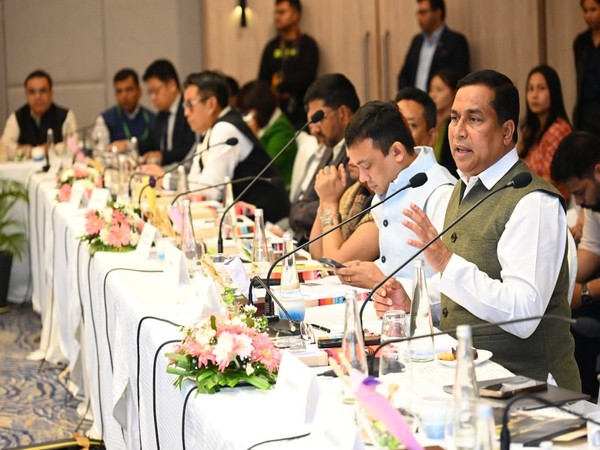
Assam Tourism Minister Jayanta Mallabaruah attended the Tourism Ministers Conference for North Eastern and Eastern States, chaired by Union Minister Gajendra Singh Shekhawat in Shillong on Monday. The conference focused on strategies to enhance the region's tourism sector.
In his address, Minister Mallabaruah noted the remarkable growth in Assam's tourism industry, with foreign tourist arrivals increasing from 6,000 to 42,000, and domestic footfall nearing a crore. 'Since 2016, Assam's tourism sector has undergone a significant transformation,' he stated, attributing the success to focused initiatives and government support.
Mallabaruah stressed the need for a comprehensive marketing strategy to unlock Assam's diverse tourist attractions, promoting Tea Tourism, Golf Tourism, Wildlife Tourism, and Religious Tourism. He emphasized regularizing airfares and developing luxury tourism infrastructure under the 'Amar Alohi' scheme, which includes facilitating homestays. He also proposed a tourism-focused search engine to aid local businesses.
The Minister highlighted the need to reshape Assam's external perceptions, often linked to insurgency and floods. He called for Union Government support to further boost the sector and indicated every village in Assam has the potential to be a tourist destination. Kumar Padmapani Bora presented on Assam's tourism initiatives, underscoring recent departmental efforts.

Ukrainian Foreign Minister Dmytro Kuleba resigns, parliament speaker says, r...

Top Financial Developments: UK's Regulatory Cuts, French Solar Investment, a...

Asian Markets Tumble Amid Tech Sell-Off: Hong Kong & China Hit Hard

China and Nigeria Strengthen Ties in Energy, Technology, and Trade
Latest news, karolina muchova draws inspiration from arthur ashe to reach u.s. open semi-finals, japanese spy detained by belarus security forces amid tensions, u.s. steel acquisition by nippon steel faces national security hurdles, chinese families flock to thailand for quality education and relaxed lifestyle.

OPINION / BLOG / INTERVIEW
Who report highlights critical insights and challenges in global vaccine safety, emerging threats in south-east asia: who bulletin highlights rising mpox cases, cholera, and dengue, post-pandemic labor shortages: the complex challenge facing advanced economies, refining policy tools: the impact of a new dsge model on north macedonia's economy, connect us on.
- ADVERTISEMENT
- KNOWLEDGE PARTNERSHIP
- MEDIA PARTNERSHIP
- Agro-Forestry
- Art & Culture
- Economy & Business
- Energy & Extractives
- Law & Governance
- Science & Environment
- Social & Gender
- Urban Development
- East and South East Asia
- Europe and Central Asia
- Central Africa
- East Africa
- Southern Africa
- West Africa
- Middle East and North Africa
- North America
- Latin America and Caribbean
OTHER LINKS
- Write for us
- Submit Press Release
- Opinion / Blog / Analysis
- Business News
- Entertainment News
- Technology News
- Law-order News
- Lifestyle News
- National News
- International News
OTHER PRODUCTS
Email: [email protected] Phone: +91-720-6444012, +91-7027739813, 14, 15
© Copyright 2024
Want to see a city like a local? Take the subway.
Subway stations and train cars provide an intimate view into how citizens shop, interact and move about.
Welcome to The Upgrade, By The Way’s series on travel hacks and hot takes. See how to submit here.
The revelation began, like so many do, in the bathroom — the women’s room at the Tokyo Metro’s Shibuya Station, to be specific. A whimsical mural of birds covers the walls, and a loop of birdsongs serve as quiet ambient music. My fascination with subway stations took root.
The futuristic, perpetually teeming transit hub is described on its website as having “a magnetism that few can resist.” I cannot be the only person who credits that allure largely to the restrooms , which are as sparkling as the lobby facilities at any Four Seasons Hotel.
The station itself was equally immaculate. And when a train pulled in, people waited for riders to exit before they filed in, no matter how crowded it was. The systematic flow of people on the escalators — standing on the right, walking on the left, no exceptions — made me think that children receive subway etiquette training in public schools. The orderliness, the cleanliness and respect for fellow urbanites add up to a portrait of Tokyo, condensed.
I will always opt for public transportation when I travel. The true local experience is unavoidable when you’re side by side with others, observing what they’re buying, what they’re reading and how they treat one another. A city’s heartbeat pulses along its tracks.
Yes, it can be a hassle to decode the fare machines in a foreign transit system or to navigate the labyrinthine tunnels, which never fail to call to mind a litany of disaster movies. But who doesn’t appreciate a little mystery on their journey?
When everything runs smoothly, the subway gets you to your destination more quickly than a car inching through traffic. Plus, it offers bite-size doses of the city’s attractions and idiosyncrasies. In New York City, for instance, you get public art ; art deco accents, a flicker of an extinct opulence; talented buskers; newsstands hawking overpriced soft drinks and snacks; and critters that constitute the urban ecosystem’s wildlife. If a full-immersion local experience is what you’re going for, you need to take in the lows as well as the highs.
The Moscow Metro is a series of concentric circles of tracks with routes that radiate out from the center like spokes. The map is chaotic and perplexing and tough to navigate if you don’t know Cyrillic, but the stations make you forget all that. The glorious underground art and architecture is museum-worthy. The underground retailers sell an assortment of necessities — home goods, clothing, beauty items, hardware and electronic gizmos, evoking the simplicity, efficiency and forced minimalism of 20th-century life there.
The London Underground , founded in 1863, maintains its Victorian charm. It manifests not only in the brick archways and tiled surfaces, but also in the aggressive civility, like the famous “Mind the gap” safety announcement and the billboards emblazoned with a colorful cartoon heart encouraging straphangers to “Be kind.”
In Belgrade, Serbia, an official visitors website deems the system “easy to use, but hard to love, yet it has a certain charm.” The message nails the city’s no-nonsense exterior and huge heart, a dynamic I love about it.
The streetcars that click-clack down busy thoroughfares are just another performer in the vintage production that is New Orleans.
As a New Yorker without a driver’s license who’s dependent on the subway for everything, I cannot endorse the Metropolitan Transportation Authority enough. Yes, there are breakdowns and delays along its 850 miles of track, shutdowns for construction, litter and the sheer humanity, which gets increasingly — let’s call it multisensory — as weather heats up. And the public kvetch fest sometimes feels like an Olympic sport. (“My commute was worse than yours,” people will say, ad infinitum.)
Yet despite all those demerits, I remind tourists in New York that you get what you pay for, which is $2.90 per ride . Personally, whenever I travel, I’d rather spend cash on memorable meals, museum books and purchases from stores that don’t exist elsewhere than drop upward of $20 on a car ride to get somewhere.
Liza Weisstuch is a New York City-based writer. You can follow her on X @livingtheproof .
More travel tips
Vacation planning: Start with a strategy to maximize days off by taking PTO around holidays. Experts recommend taking multiple short trips for peak happiness . Want to take an ambitious trip? Here are 12 destinations to try this year — without crowds.
Cheap flights: Follow our best advice for scoring low airfare , including setting flight price alerts and subscribing to deal newsletters. If you’re set on an expensive getaway, here’s a plan to save up without straining your credit limit.
Airport chaos: We’ve got advice for every scenario , from canceled flights to lost luggage . Stuck at the rental car counter? These tips can speed up the process. And following these 52 rules of flying should make the experience better for everyone.
Expert advice: Our By The Way Concierge solves readers’ dilemmas , including whether it’s okay to ditch a partner at security, or what happens if you get caught flying with weed . Submit your question here . Or you could look to the gurus: Lonely Planet and Rick Steves .

The Economic Times daily newspaper is available online now.
Et wlf: with our cultural power, we will be world's most respected nation by 2047, says gajendra singh shekhawat.
If more work is done on showcasing India's strengths and its varied offerings and cultures, India would be among the top ten destinations in the world, said Shekhawat. "Our historical forts and palaces stand out. We have wildlife, safaris, walking trails, agro tourism. There is culture, music, cuisines. There is everything that tourists want.

Read More News on
(Catch all the Business News , Breaking News , Budget 2024 Events and Latest News Updates on The Economic Times .)
Subscribe to The Economic Times Prime and read the ET ePaper online.

Trading at high PE, these 15 mid-cap stocks look expensive, yet give good returns

SUGAR Cosmetics follows Nykaa and Mamaearth’s path, glams up for an IPO

3 questions the USD230 million crypto heist raises about WazirX-Binance dispute

Is it time for a new Sebi chief?
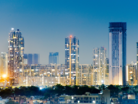
Indian real estate’s increasing allure for global institutional investors explained
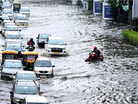
How heatwaves and floods are putting auto sales under the weather
Find this comment offensive?
Choose your reason below and click on the Report button. This will alert our moderators to take action
Reason for reporting:
Your Reason has been Reported to the admin.

To post this comment you must
Log In/Connect with:
Fill in your details:
Will be displayed
Will not be displayed
Share this Comment:
Stories you might be interested in
Tourists caught out by record temperatures across the Kimberley
By Ted O'Connor
By Vanessa Mills
By Esse Deves
ABC Kimberley
Topic: Weather
Kimberley tourists and residents are being reminded to keep cool amid soaring temperatures in Western Australia's far north.
Some tourism operators have rescheduled tours to earlier parts of the day in a bid to beat the heat.
What's next:
The weather bureau says the hot conditions are forecast to continue for another week.
Tourists who normally flock to northern WA for winter sunshine at this time of year are instead sweltering through record-breaking heat, as tour operators seek workarounds to keep them cool and safe.
Temperatures across Western Australia's north peaked at more than 41 degrees Celsius on Monday, with the Bureau of Meteorology forecasting more hot weather to come.
August maximum temperatures in the region usually fluctuate in the low 30s.
Kimberley tour operator Scott Harvey is ensuring people on his tour are well-looked after. ( ABC Kimberley: Ted O'Connor )
Tour guide Scott Harvey said this morning's visit to Ivanhoe Crossing near Kununurra in the East Kimberley occurred earlier to allow tourists to escape the heat.
"Keeping the aircon on the bus, really drumming into the passengers the need for hydration … [we're] trying to work with [the heat] as much as possible," he said.
"That way we can keep out of the heat and avoid any cases of heat stress."
Tourist Bill Ryan had travelled to Kununurra from Perth and was on the tour.
He said while he was expecting the region to be warm, he wasn't anticipating it to be quite so hot.
"The temperature's got out of control," he said.
"A third of our group is over 80 so we have to be extremely careful walking the gorges and rocky terrain in this heat.
"They are very positive … a good guide helps."
Tourist Bill Ryan is taking extra precautions in the extreme weather. ( ABC Kimberley: Ted O'Connor )
A spokesperson for East Kimberley resort El Questro said it was also advising visitors not to embark on hikes after 10am.
"We've also moved our horse-riding experiences earlier in the day, but still have two rides heading out daily," the spokesperson said.
Records broken
Record August temperatures were broken on Monday in five Kimberley locations, with Yampi — a Defence training ground — recording the hottest winter day in Australia on record.
Meteorologist Jessica Lingard said the hot conditions would continue for another week.
"It's all being driven by a stagnant high-pressure system that's sitting in the centre of the country and it's not moving," she said.
"It's allowing that heat to build and build and it's not going anywhere."
"We're [also] seeing records being broken throughout the [Northern] Territory, northern South Australia, south-west Queensland and even into New South Wales."
The WA Department of Health said it had not issued a heat warning for the Kimberley, as it was not "technically a heatwave".
The department said it was reminding people to watch for signs of dehydration, heat stress and heat stroke.
East Kimberley College students enjoying an ice cream during the region's record heat. ( ABC Kimberley: Alys Marshall )
Kathleen Atkinson from the WA Country Health Service said it was important travellers and locals alike to follow health advice.
"We know that Kimberley communities are acclimatised to the heat but it’s a timely reminder for everyone, including tourists and visitors, to take steps to stay safe and well in the hot weather," Dr Atkinson said.
"Seek a place to keep cool, such as your home, a library, community centre or shopping centre.
"Close your windows and draw blinds, curtains or awnings early in the day to keep the heat out of your home."
Wildlife reacts to heat
In the West Kimberley, Derby native wildlife carer Heidi Sampey said it was not uncommon for wildlife carers to work overtime to help stressed animals.
"The animals are used to hot conditions, of course, but when it suddenly hits it knocks everyone around," she said.
"If it keeps going it could get quite dire for some of the animals."
Not all animals at the Derby Wildlife Rehabilitation Centre are fazed by the hot weather. ( Supplied: Heide Sampey )
Derby, about 2,000 kilometres north of Perth, peaked at 40.7C on Monday.
Ms Sampey said people needed to be on the look out for signs of heat stress and dehydration in animals.
Records for above 40C days in August have been broken in four Kimberley towns. ( Supplied: Heidi Sampey )
"A really good trick is to freeze some water in some bottles and they [animals] can go lay near that to cool down," she said.
"Definitely have lots and lots of water available to them."
ABC Kimberley — local news in your inbox

IMAGES
VIDEO
COMMENTS
Scan the space. Observe whether animals have an appropriate environment, including shelter, ample space, a comfortable resting area, and a secluded place away from crowds. Beware of buzzwords ...
By Natasha Daly. May 23, 2019. • 8 min read. Right away, Elephant Valley Thailand felt different. The property, nestled in the forest on the outskirts of Chiang Rai, a small city in northern ...
In 2016, travel and tourism contributed $7.6 trillion, or 10.2%, to total GDP, and the industry provided jobs to one in 10 people, according to the World Travel & Tourism Council. While nature-based tourism, which includes wildlife tourism, has been expanding rapidly in the last decade or so due to increased demand and opportunities, wildlife ...
Wildlife tourism development has been proposed as a solution to human-wildlife conflict [3,14,15]. Recent studies have focused on examining whether and how tourism benefits can alter communities' hostile attitudes and livelihoods from the economic and social perspectives . In this article, we argue that those studies neglect the ecological ...
Suffering unseen: The dark truth behind wildlife tourism. Captive wild animal encounters are hugely popular, thanks partly to social media. But our investigation shows many creatures lead dismal ...
Wildlife tourism (WT) is an emerging sector of tourism, majorly meant to. view and/or encounter wildlife in the wild, captive, and semi-captive. settings. Because of the new emerging economies ...
This new knowledge contributes in three ways to the call to audit the impact of tourism on conservation (Moorhouse et al., 2015). Firstly, this study suggests that tourism to last chance destinations prompts the greatest new philanthropy to conservation when compared to other international and domestic trips in nature.
The call of the wild - and the wildlife in it - is a powerful one. But as the dark truth behind many wildlife tourism activities becomes ever clearer, the case for responsible tourism has never been stronger. Acknowledging we should be more responsible, however, is only part of it. Learning what this means, and putting it into practice, is key.
To cite this article: Jessica Bell Rizzolo (2021): Wildlife tourism and consumption, Journal of Sustainable Tourism, DOI: 10.1080/09669582.2021.1957903 To link to this article: https://doi.or g/10 ...
The goal of this research was to develop and validate an integrative model for memorable wildlife tourism experience. The study examined how escapism, experience co-creation, existential authenticity, and experiential satisfaction serve as drivers of memorable wildlife experience. It further explored the connection between memorable wildlife ...
Wildlife Tourism. Wildlife tourism (WT), defined as 'tourism based on encounters with non-domesticated (non-human) animals' (Higginbottom, 2004, p. 2), is an important sector in developed and developing countries. WT encounters can be non-consumptive and thus congruent with the tents of ecotourism, or consumptive based on activities such as ...
For models of wildlife consumption at home, wildlife tourism activities at home were used as predictors. 6 This was measured by the percentage of respondents who viewed the behavior as "very acceptable." 26.7% of Indian respondents, 16.1% of US respondents, 15.9% of Thai respondents, 14.6% of Canadian respondents, and 13.8% of Chinese ...
How Tourism Benefits Nature and Wildlife. The Great Barrier Reef. Yellowstone. The Amazon Rainforest. One of the top reasons that tourists are drawn to destinations such as these is because of their rich biodiversity and unique landscapes. According to Brand USA, 2 of the top 5 motivators for selecting vacation spots are ecotourism and nature.
A very interesting chapter, Representing Wild Animals to Humans: The Ethical Future of Wildlife Tourism, focuses on wildlife tourism in captive settings. As captive animals are increasingly the only way that the majority of people can see a (previously found only in the wild) animal, this chapter is an important read for anyone engaged with ...
A lot of iconic wildlife tourism experiences, already impacted and at risk of further damage by wildlife trafficking and bush meat consumption, could be put in danger because of the wider impacts of COVID 19 such as job losses in tourism and inadequate protected area management ( ACF, 2020; Weber et al., 2020 ).
Travelers often aren't aware of it, but many wildlife tourism activities actually hurt the creatures. The reality is: Wildlife tourism is a complex industry. As an article in National Geographic notes, "discerning the difference between ethical and problematic wildlife experiences" is a difficult task.
They include, for instance, wildlife resources , cross-border natural resources management for the purpose of tourism , food-environment-hospitality relationships , environmental state of important touristic locations and geographical domains [26,27,28], and the state governance of nature-based tourism . Nonetheless, it is hoped that the ...
Wildlife disturbance - Tourism in Russia can cause disturbance to local wildlife, particularly in areas where wildlife is a key attraction for tourists. ... If you enjoyed this article about tourism in Russia, I am sure you will like these too: 35 Famous Landmarks Of Russia (with photos) 35 fascinating facts about Russia; Tourism in Alaska;
2 of 13 | . The dried out Lake Picrolimni is seen from above, in the village of Mikrokampos, northern Greece, Aug. 19, 2024. A severe drought in northern Greece, worsened by successive heatwaves and low rainfall, is causing water shortages that are threatening agriculture, drying up lakes, and stressing local communities dependent on tourism.
3. Marvel at St. Basil's Cathedral. St. Basil's Cathedral is one of the most iconic churches in the world, and it was the single thing we were most excited to see while in Moscow. Built almost 500 years ago, St. Basil's Cathedral is recognized by its colorful domes and whimsical style.
4. Gorky Park. This park is the venue for several activities in Moscow. It is also one of the very first parks established in the city and is named after Maxim Gorky, a prominent writer and political activist. You will need 20 to 30 minutes for this park. 5. Garage Museum of Contemporary Art.
Namibia's turn to wild game is nothing new. People in the region eat at least some of the animals listed in the environmental ministry's cull list, like zebra, blue wildebeest and impala ...
Why we're shining a light on wildlife tourism. Selfie-seeking visitors like close encounters with exotic animals. Our investigation uncovered rampant abuse behind the scenes. By Susan Goldberg ...
The researchers surveyed 656 reef visitors about their experiences and behaviors during boat trips. Dr. Yolanda Waters from UQ's School of the Environment said the results showed information on ...
Assam Tourism Minister Jayanta Mallabaruah emphasized the state's tourism growth at the North Eastern Tourism Ministers Conference. Foreign tourist arrivals jumped from 6,000 to 42,000, and domestic visits neared a crore. Strategies for Tea Tourism, Golf, Wildlife, and Religious Tourism were discussed along with infrastructure improvements.
When everything runs smoothly, the subway gets you to your destination more quickly than a car inching through traffic. Plus, it offers bite-size doses of the city's attractions and idiosyncrasies.
ABSTRACT. An online survey of the American public (n = 500) was used to explore perceptions of the effects of tourism on wildlife and definitions of key tourism terms.Results show that the public's assessment of the impacts of tourism are relatively nuanced and reflective of trade-offs discussed in the literature, and that there is broad recognition of the potential for wildlife to ...
If more work is done on showcasing India's strengths and its varied offerings and cultures, India would be among the top ten destinations in the world, said Shekhawat. "Our historical forts and palaces stand out. We have wildlife, safaris, walking trails, agro tourism. There is culture, music, cuisines. There is everything that tourists want.
Not all animals at the Derby Wildlife Rehabilitation Centre are fazed by the hot weather. ( Supplied: Heide Sampey ) Derby, about 2,000 kilometres north of Perth, peaked at 40.7C on Monday.
The two met in Vladivostok on the sidelines of an economic forum designed to attract foreign investment and showcase Russia to them. Greeting Vulin as the two sat down for talks, Putin expressed hope that Serbia's deputy prime minister will be able to "take a close look and evaluate the possibilities of cooperation with such a large and promising region" as Russia's far east.